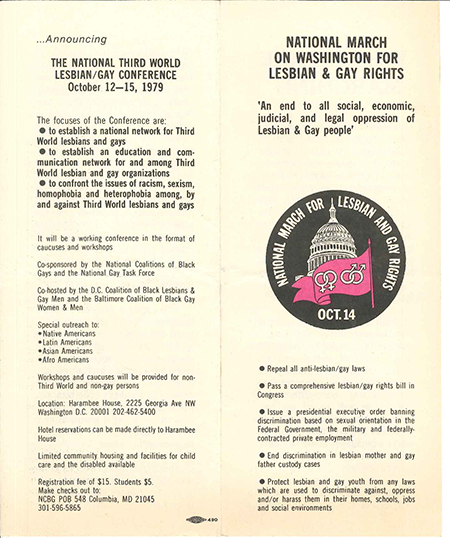Category: Project Update
Statement from the NYC LGBT Historic Sites Project about Digital Erasure at Stonewall
February 19, 2025
“Transgender and Queer People Cannot Be Erased”
Statement from the NYC LGBT Historic Sites Project, the Leading Historians and Preservationists on NYC Site-Based LGBTQ History
FEBRUARY 19, 2025—NEW YORK, NY—The National Park Service, under a new executive order, has removed all mentions of transgender and queer identities from a growing number of webpages associated with LGBTQ history. In response, the NYC LGBT Historic Sites Project has issued the following statement:
“Revising the historical record to eliminate transgender and queer identities for political purposes is a dangerous and divisive practice. As preservationists and historians, the founders of the NYC LGBT Historic Sites Project authored and helped secure the Stonewall Inn’s listing on the National Register of Historic Places in 1999 and its designation as a National Historic Landmark in 2000. Our research and advocacy were pivotal in the designation of Stonewall National Monument in 2015.
“Facts matter. History matters. Transgender and queer people have always existed and will continue to exist. Their histories and contributions are inextricably linked to the American story and must not be erased. We must stand together and call out those whose fear and hatred seek to harm us and push us back into obscurity.
“For over 30 years, the Project team has persevered against hostility in telling the full and complex story of the LGBTQ community through the built environment. Our resilience and tenacity has proven that LGBTQ history is American history. We will not stop documenting this history. We will not stop telling the full story and sharing LGBTQ people’s footprint in history. We will always be committed to educating and bridging the gap for greater understanding.
“Our work has enabled the creation of invaluable resources for educators, historians, community leaders, enthusiasts, tourists, and the general public. It has the power to reduce feelings of isolation and shame, build an appreciation for LGBTQ cultural heritage, encourage cross-generational understanding, and connect people today to a rich and vibrant past.
“Through nearly 500 locations (and growing) across the five boroughs, we are providing a fact-based LGBTQ cultural landscape, including transgender and queer narratives. We will continue our mission to educate and raise awareness.
“Our history—once invisible—will not be erased.”
Resources available from the NYC LGBT Historic Sites Project that document transgender and queer narratives, as well as those associated with the Stonewall National Monument:
- Curated Theme: Transgender History (more)
- Historical Entry: The Stonewall Inn (more)
- Fact Sheet: Stonewall, The Basics (more)
- Fact Sheet: Stonewall, Lo básico (more)
- Free Audio Guide: Stonewall and Nearby Sites, created for Bloomberg Connects (more)
- Map: Greenwich Village LGBTQ+ History (more)
About the NYC LGBT Historic Sites Project
The NYC LGBT Historic Sites Project, launched in 2015 by preservation professionals, is an award-winning cultural heritage initiative and educational resource documenting and presenting historic sites connected to the LGBTQ community throughout New York City. Its website, including an interactive map, features nearly 500 diverse places from the 17th century to 2000 that are important to LGBTQ history and illustrate the community’s influence on NYC and American culture.
The project researches and nominates LGBTQ sites to the National Register, advocates for the official recognition of LGBTQ historic sites, provides walking tours (also accessible through a free-app), presents lectures, engages the community through events, develops educational programs for New York City public school students, and disseminates its content through robust social media channels. Its goal is to make an invisible history visible while fostering pride and awareness.
Web: www.nyclgbtsites.org
Instagram: @nyclgbtsites
Bluesky: @nyclgbtsites.bsky.social
Facebook: /nyclgbtsites
YouTube: @nyclgbtsites
###
Project Manager Amanda Davis at Library of Virginia Uncovering Queer History Research Workshop
October 21, 2024
Project manager Amanda Davis recently joined the Library of Virginia as a guest speaker at their Uncovering Queer History Research Workshop to discuss the Project’s work documenting place-based LGBT history in New York City. Watch the full video below.
Banned Books Week: Truman Capote and James Baldwin in NYC
September 27, 2024
The Project is delighted to partner with our friends at Penguin Random House and Vintage Books to elevate the work of two authors whose work has, at one time or another, been banned by the broader culture for the views and words: Truman Capote and James Baldwin. As you revisit their writings, take a moment to connect with their legacies via the extant sites across New York City that weave into their life stories.
READ BANNED BOOKS
learn more from Penguin Random house
Truman Capote Residence, 70 Willow Street, Brooklyn — From around 1955 to 1965, legendary theater designer Oliver Smith rented the garden apartment of his Brooklyn Heights home to Capote, who wrote his best-known works, Breakfast at Tiffany’s and In Cold Blood, during this time. (read more)
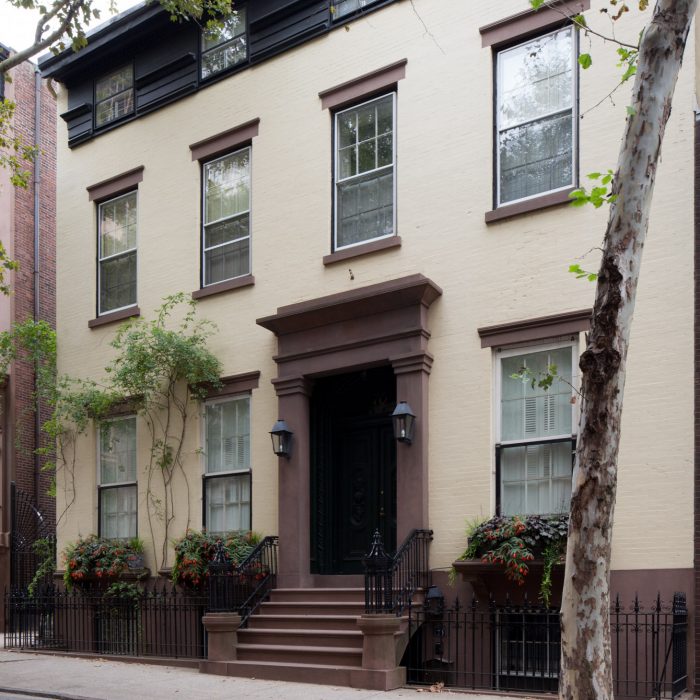
Hotel St. George, 111 Hicks St, Brooklyn — From the 1920s through the 1970s, this mammoth edifice was one of the best known centers of gay male life in Brooklyn. Famed for its luxurious public spaces and its blind-eye to discreet same-sex relationships, it became a favored cruising ground and residence for gay men, including Hart Crane, Tennessee Williams and Truman Capote. (read more)
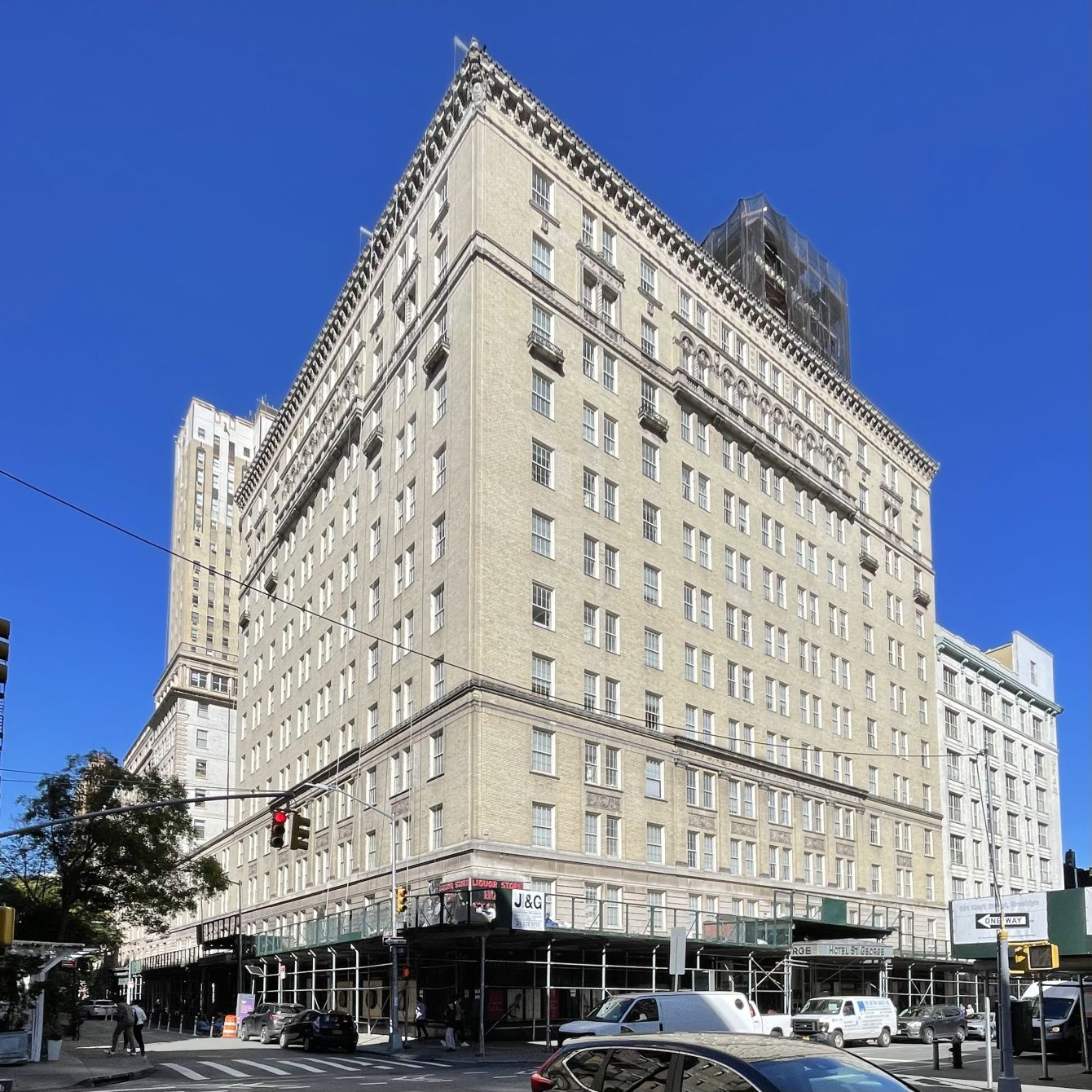
New York Public Library, Main Branch, 476 5th Avenue, Manhattan — Patience and Fortitude, the famed lions that guard the steps of the library, sit sentinel to the collections of so many beloved authors, including Truman Capote, whose papers are in safe keeping here.
The Plaza, 768 5th Avenue, Manhattan — Both James Baldwin and Truman Capote were in attendance at the famed Black and White Ball, held in the Grand Ballroom in 1966 and widely regarded as one of the defining social events of the 1960s. The party feted the completion of Capote’s In Cold Blood. (read more)
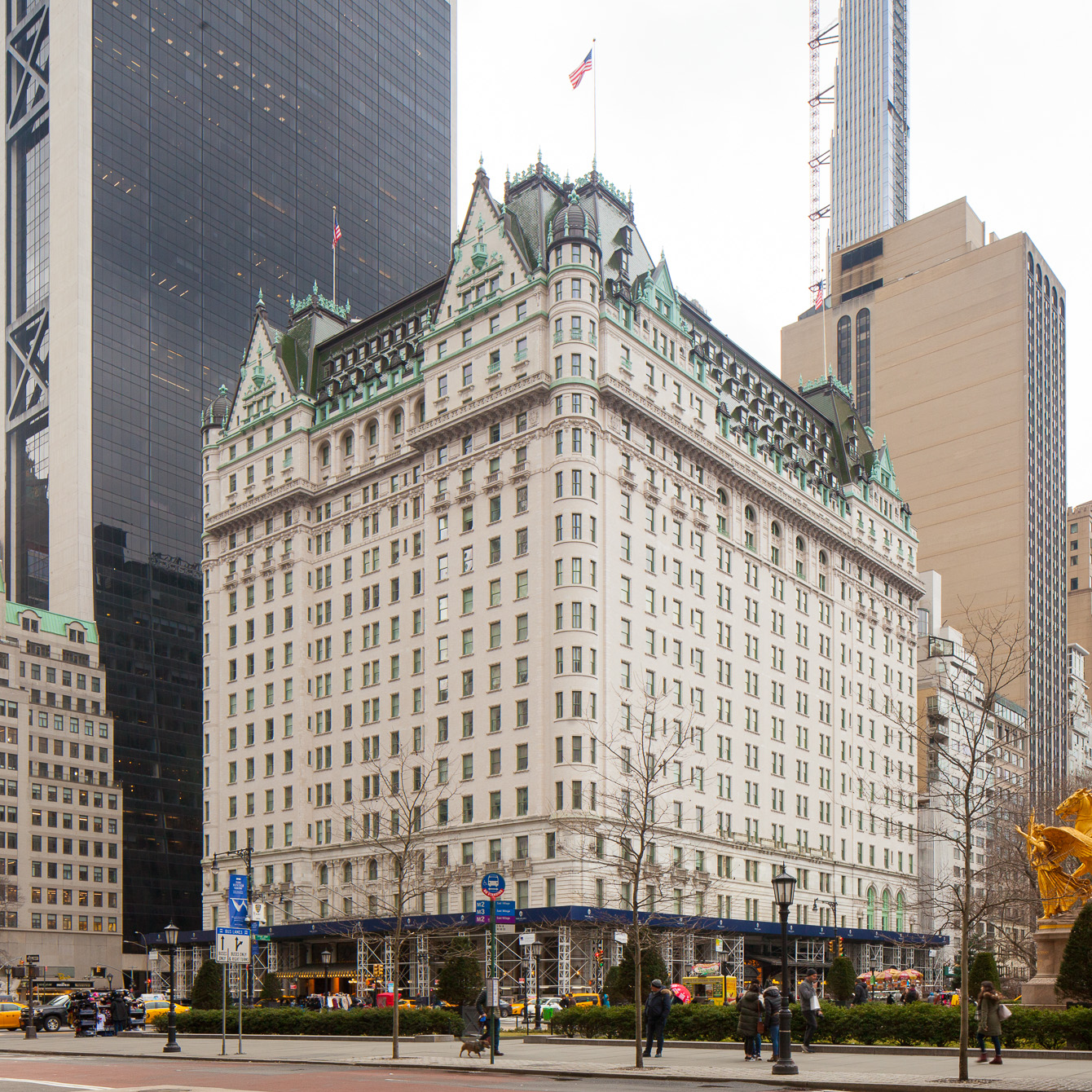
August Wilson Theater (then known as ANTA Playhouse), 243-259 West 52nd Street, Manhattan — Opened in 1925 as the Guild Theater and renamed the ANTA Playhouse in 1950, this venue staged multiple productions involving major LGBT performers and creators, including James Baldwin’s Blues for Mr. Charlie (1964). (read more)
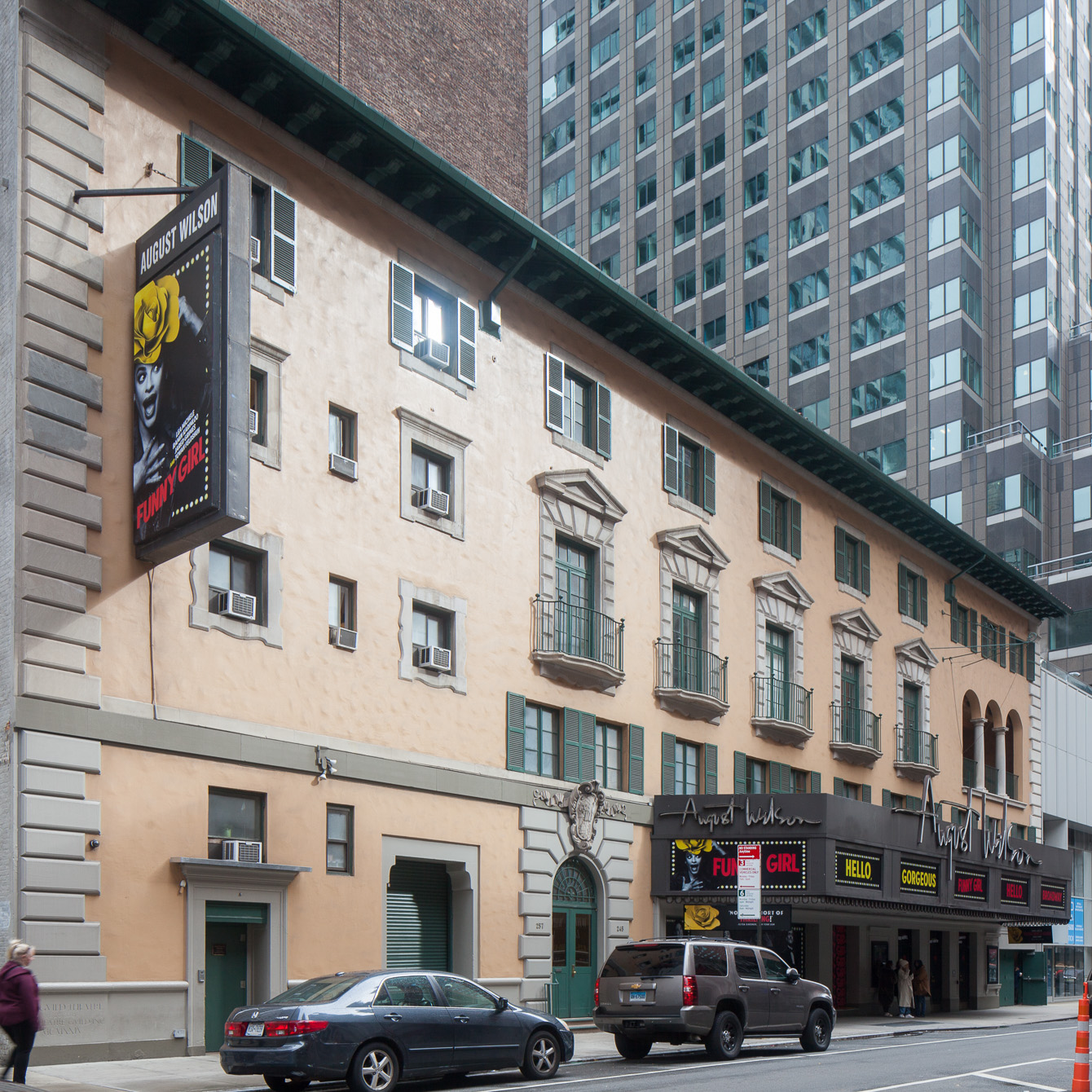
James Baldwin 100
August 2, 2024
Happy birthday, James Baldwin! August 2nd marks 100 years since the birth of the author and activist. For this special occassion, we’re visiting five NYC sites connected to Baldwin’s enduring legacy.
James Baldwin Residence, 81 Horatio Street — Baldwin lived at 81 Horatio Street from 1958 to 1961, and it’s where he continued working on his third novel, Another Country, which included bisexual characters. (read more)
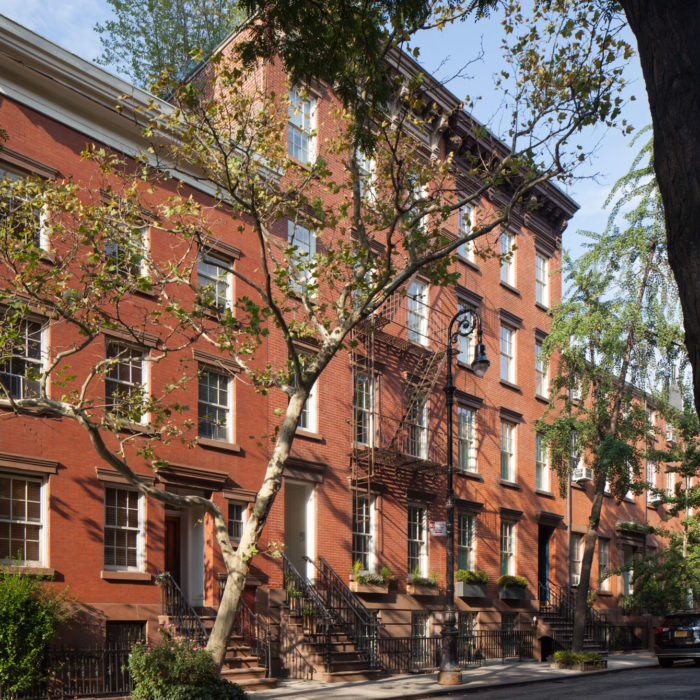
135th Street Branch of the New York Public Library — Growing up in Harlem, Baldwin was profoundly influenced by the 135th Street Branch of the New York Public Library, dedicated to Black literature, once saying he read “every single book” here. (read more)
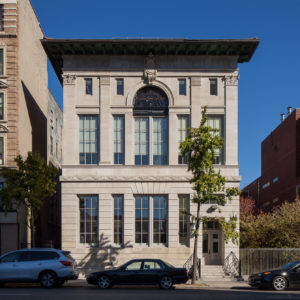
SCHOMBURG CENTER FOR RESEARCH IN BLACK CULTURE, 515 Malcolm X Boulevard — This institution houses one of the country’s most significant collections of African American history and the African Diaspora, including the records of LGBT notables and groups including James Baldwin. (read more)
NOW ON VIEW at the Schomburg:
“JIMMY! God’s Black Revolutionary Mouth.”
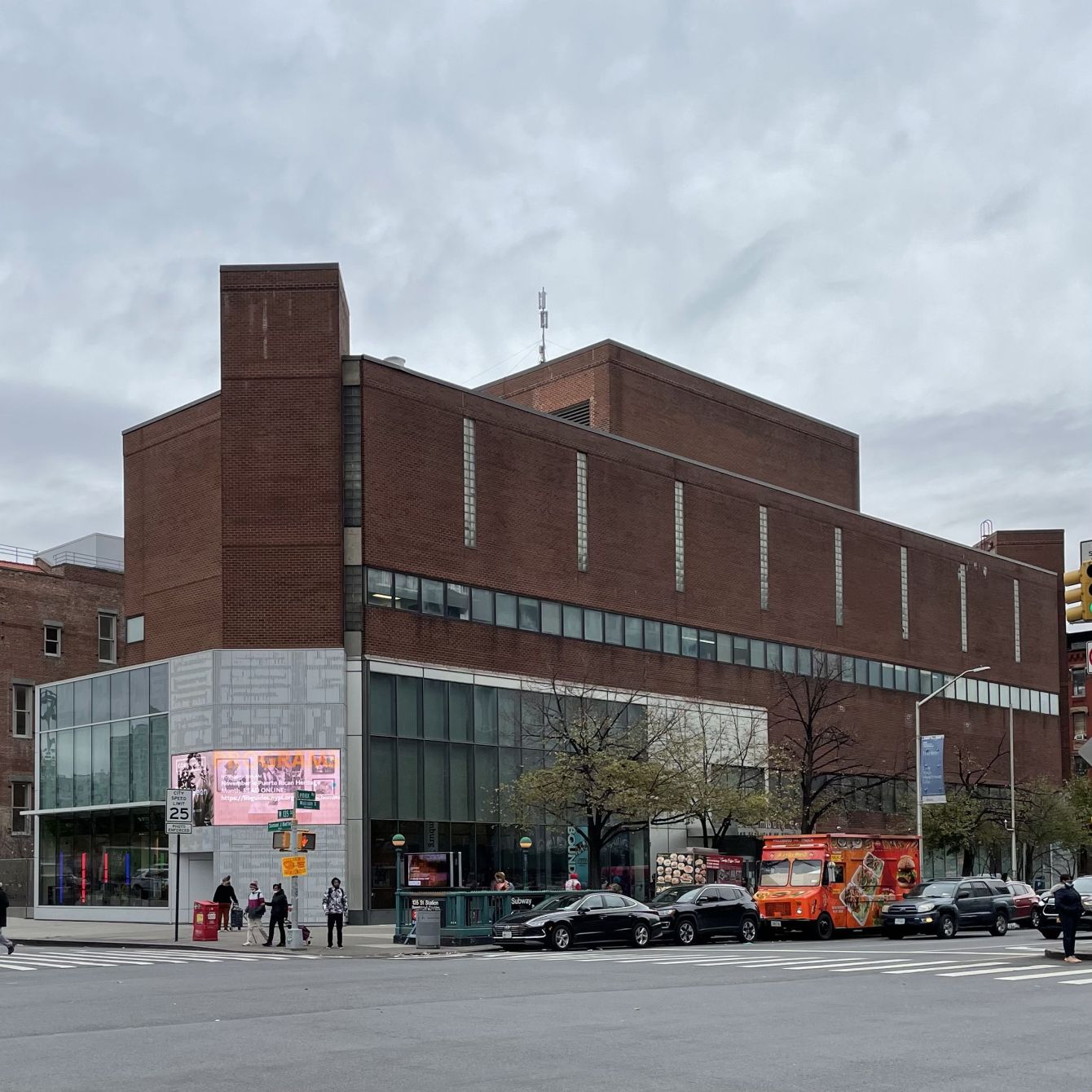
The San Remo, 189 Bleecker Street — In 1943, Baldwin moved downtown to Greenwich Village and frequented hangouts like the San Remo, popular with Bohemians, Beats, and gay people — though he also wrote about the racism he experienced here. (read more)

National Headquarters for the 1963 March on Washington for Jobs and Freedom, 170 West 130th Street — Baldwin’s civil rights activism brought him back to Harlem in 1963. He met with those planning and preparing for the iconic March on Washington for Jobs and Freedom in D.C. at its National Headquarters. (read more)

James Baldwin Residence, 137 West 71st Street — Baldwin owned 137 West 71st Street on the Upper West Side from 1965 until his death in 1987. During that period, he wrote about his own sexuality for the first time in his 1985 essay, “Here Be Dragons,” also published as “Freaks and the American Ideal of Manhood.” (read more)

LGBT Historians Partner with Bloomberg Connects to Create FREE Audio Tour of Stonewall and Surrounding Sites
June 25, 2024
PRESS CONTACT
Ken Lustbader, NYC LGBT Historic Sites Project
(917) 848-1776 / [email protected]
Audio Featuring First-hand Stories from History-Making Trailblazers and More
NEW YORK, NY—Tuesday, June 25, 2024—The NYC LGBT Historic Sites Project, an award-winning initiative committed to documenting and presenting historic sites connected to the LGBT community throughout New York City, announces the launch of their featured audio tours and more on the Bloomberg Connects mobile app.
“We’re thrilled to be among the newest cultural organizations and institutions invited to share on the Bloomberg Connects mobile app. Our digital guide has the power to immerse you in NYC’s LGBT history, from anywhere in the world.” — Amanda Davis, manager of the NYC LGBT Historic Sites Project
The Project’s content on the app features stories and historic images of LGBT historic sites — residences, bars, bookshops, community spaces, public places, businesses, and more. Engaging audio and video clips from the Project team, leading LGBT scholars, and activists who made LGBT history immerse you in history, from anywhere in the world.
“As historic preservationists with over 30 years of experience documenting LGBT history, we are proud to make an invisible history visible through our digital guide on the Bloomberg Connects app.” — Ken Lustbader, co-director of the NYC LGBT Historic Sites Project
CONNECT ANY TIME, FROM ANYWHERE
Take a self-guided audio tour in the vicinity of Stonewall National Monument, or explore thematic tours focusing on 1970s lesbian activism and transgender history (with more in development). Virtually visit the physical locations and streetscapes where LGBT history was made.

ENGAGING AND IMMERSIVE AUDIO

Ellen Broidy, activist and co-planner of the first ever Christopher Street Liberation Day March (today’s Pride March). “Craig [Rodwell] suddenly said, ‘it’s time to take some direct action.’ The more we talked, the clearer we could see the beginnings of what could be a mass movement.”

Author Hugh Ryan speaking about the extant Jefferson Market Courthouse and (since demolished) Women’s House of Detention. As Hugh shares, queer women and people who today might identify as nonbinary or transgender were prosecuted for “failures of femininity.”

Trailblazing gay rights activist Randy Wicker, who participated in the consequential “Sip-In” at Julius’ bar in 1966: “This was the first time a gay organization had publicly challenged the laws and regulations that forbid homosexuals to have access to public accommodations. It was against the liquor laws of New York State to allow any homosexuals to assemble or to be served alcohol in a bar.”
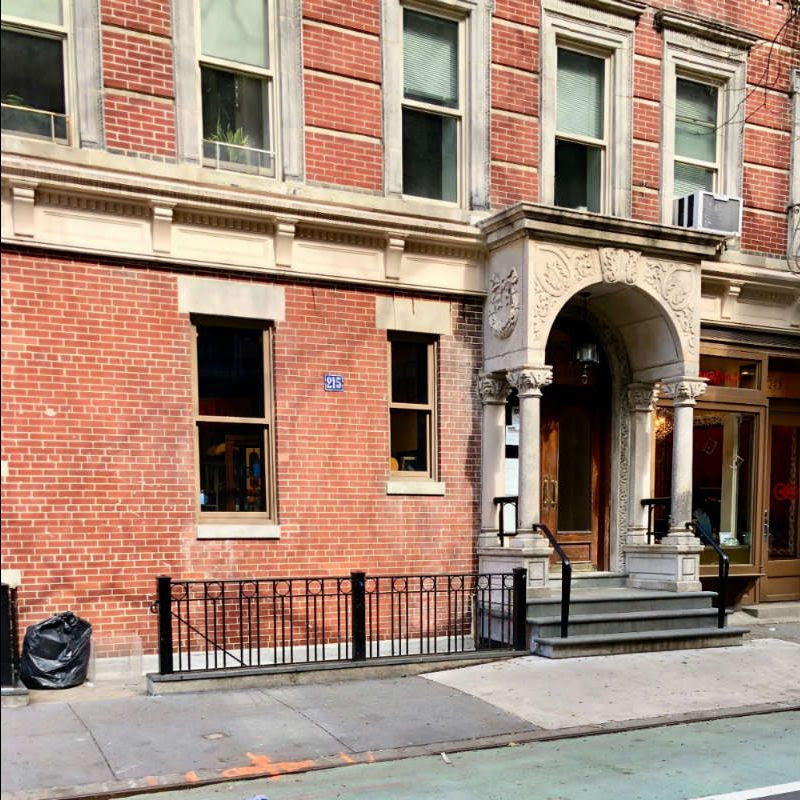
Project co-director Jay Shockley, sharing the events of the Snake Pit raid, which led to 167 gay men being arrested by the NYPD and one young man impaled on an iron fence: “Any way you look at it, that boy was pushed!! We are all being pushed.”

Project manager Amanda Davis, on the Oscar Wilde Memorial Bookshop, founded and owned by an “unsung hero of the LGBTQ rights movement,” Craig Rodwell. In the face of mainstream propaganda that said being LGBTQ was wrong, one could walk into the Bookshop “and read books that are saying exactly the opposite [which] must have been so incredible.”

Project co-director Ken Lustbader, narrating your visit to the Stonewall Inn, the site of the history-changing uprising in June 1969: “When you oppress people for so long, when you tell them that their lives aren’t legitimate, and you tell them that their identity isn’t real, it only takes a little moment to have an explosive response.”
PREVIEW FROM FEATURED AUDIO TOUR, “PLACING STONEWALL”:
LGBTQ+ activism didn’t begin at Stonewall, and it didn’t end there either.
It’s location in Greenwich Village is key in placing the 1969 uprising in LGBTQ+ history. An early “gayborhood,” the Village has been an important epicenter of LGBTQ+ life in New York City for well over a century.
In the pre-Stonewall years, amidst an atmosphere of fear and repression, gay bars and other social gathering spaces were crucial in creating a sense of community and brewing political agitation. Though discrimination remained post-Stonewall, the gay liberation era of the early 1970s ushered in a new wave of unapologetic activism and increased visibility.

About the NYC LGBT Historic Sites Project
The NYC LGBT Historic Sites Project, launched in 2015 by preservation professionals, is an award-winning cultural heritage initiative and educational resource documenting and presenting historic sites connected to the LGBT community throughout New York City. Its website, including an interactive map, features 450+ diverse places from the 17th century to 2000 that are important to LGBT history and illustrate the community’s influence on NYC and American culture.
The project researches and nominates LGBT sites to the National Register, advocates for the official recognition of LGBT historic sites, provides walking tours (also accessible through a free-app), presents lectures, engages the community through events, develops educational programs for New York City public school students, and disseminates its content through robust social media channels. Its goal is to make an invisible history visible while fostering pride and awareness.
Web: www.nyclgbtsites.org
Instagram: @nyclgbtsites
Twitter: @nyclgbtsites
Facebook: /nyclgbtsites
Research to Document LGBT History of NYC’s Hotel Chelsea Receives Award From National Park Service
April 10, 2024
PRESS CONTACT
Ken Lustbader, NYC LGBT Historic Sites Project
(917) 848-1776 / [email protected]
RESEARCH TO DOCUMENT LGBT HISTORY OF NYC’S HOTEL CHELSEA RECEIVES AWARD FROM NATIONAL PARK SERVICE
Architectural historians and scholars from the NYC LGBT Historic Sites Project receive $25,000 to fund amendment to National Register of Historic Places
NEW YORK, NY—Wednesday, April 10, 2024—The NYC LGBT Historic Sites Project, an award-winning initiative committed to documenting and presenting historic sites connected to the LGBT community throughout New York City, has been awarded $25,000 by the National Park Service as part of its initiative to increase LGBT diversity on the National Register of Historic Places.
Under the auspices of its fiscal sponsor, the Fund for the City of New York, the Project will undertake research to amend the existing National Register of Historic Places nomination for New York City’s Hotel Chelsea to add the LGBT social history to its understanding and appreciation as a nationally-significant historic site.
“We are honored to have the National Park Service continue to support our work to increase LGBT diversity on the National Register of Historic Places. Now more than ever, as the teaching of queer history faces pushbacks across the country, sites like the famed Hotel Chelsea serve as important reminders of the contributions that LGBT people have made to American history and culture. This amendment will officially recognize these contributions by documenting, to date, over 80 notable LGBT artists, writers, musicians, and activists who helped turn the Hotel Chelsea into an internationally recognized icon of New York City.” —Amanda Davis, project manager of the NYC LGBT Historic Sites Project
From the existing entry for the Hotel Chelsea, located at 222 West 23rd Street, at www.nyclgbtsites.org:
The Hotel Chelsea, the storied residence hotel on 23rd Street, has played host to a succession of countercultures throughout the 20th century, serving as a hub and inspiration for the Beat Generation, Postmodern artists, rock and punk musicians, drag performers, and the Club Kids. Until 2011, when new developers evicted many long-term residents and began controversial decade-long renovations, the Chelsea was a creative sanctuary that fostered collaboration among numerous LGBT writers, musicians, artists, designers, filmmakers, and actors such as:
- Stormé DeLarverie, a biracial singer, male impersonator, activist, and bouncer
- Charles James, widely regarded as the first American couturier and one of the most influential women’s fashion designers of the 20th century
- Lance Loud, a TV personality, journalist, and punk rock musician who emerged as a public gay figure after his momentous coming out on America’s first reality television series, An American Family, in 1973
- Ching Ho Cheng, an openly gay Chinese-American artist who depicted his rooms at the Chelsea in a series of gouache still-life paintings
- Sarah Bernhardt, a 19th century French actress, fashion icon, and businesswoman who was one of the world’s first celebrities
- Robert Mapplethorpe, a highly influential photographer of the late 20th century
- Virgil Thomson, an eminent composer and music critic of the 20th century
- Simone de Beauvoir, a French author and feminist who is best known for her treatise, The Second Sex (1949), a classic of feminist literature
- Zaldy Goco, a Filipino-American fashion designer and model
- Frida Kahlo, a Mexican artist best known for her portraits depicting the human body, identity, and deat
Funding comes through the National Park Service’s Underrepresented Communities grant program, which began in 2014 and has provided $7 million to State and Tribal Historic Preservation Offices and Certified Local Governments to work towards diversifying the National Register of Historic Places through surveys and nominations. The Underrepresented Communities grant program is one element of the Historic Preservation Fund, which uses revenue from federal oil and gas leases on the Outer Continental Shelf to assist with a broad range of preservation projects without expending tax dollars, with the intent to mitigate the loss of a nonrenewable resource to benefit the preservation of other irreplaceable resources. Established in 1977, the HPF is authorized at $150 million per year through 2023 and has provided more than $2 billion in historic preservation grants to states, Tribes, local governments, and nonprofit organizations. Administered by the NPS, HPF funds may be appropriated by Congress to support a variety of historic preservation projects to help preserve the nation’s diverse cultural resources. For more information about NPS historic preservation programs and grants, please visit go.nps.gov/grants.
About the NYC LGBT Historic Sites Project
The NYC LGBT Historic Sites Project, launched in 2015 by preservation professionals, is an award-winning cultural heritage initiative and educational resource documenting and presenting historic sites connected to the LGBT community throughout New York City. Its website, including an interactive map, features 450 diverse places from the 17th century to 2000 that are important to LGBT history and illustrate the community’s influence on NYC and American culture.
The project researches and nominates LGBT sites to the National Register, advocates for the official recognition of LGBT historic sites, provides walking tours, presents lectures, engages the community through events, develops educational programs for New York City public school students, and disseminates its content through robust social media channels. Its goal is to make an invisible history visible while fostering pride and awareness.
Web: www.nyclgbtsites.org
Instagram: @nyclgbtsites
Twitter: @nyclgbtsites
Facebook: /nyclgbtsites
About the National Park Service
More than 20,000 National Park Service employees care for America’s 428 national parks and work with communities across the nation to help preserve local history and create close-to-home recreational opportunities. Learn more at www.nps.gov.
Awareness Campaign to Take Over Christopher Street Station for International Transgender Day of Visibility
March 26, 2024
PRESS CONTACT
Ken Lustbader, NYC LGBT Historic Sites Project
(917) 848-1776 / [email protected]
Awareness Campaign to Take Over Christopher Street Station for International Transgender Day of Visibility
‘Voice of the Subway’ Bernie Wagenblast hosts limited-series podcast featuring Callen-Lorde, NYC LGBT Historic Sites Project and other notables
Media Availability Planned for Friday, March 29 at 11:00 AM
NEW YORK (March 26, 2024)—A new awareness campaign, “In Transit: Guiding 2.4 million daily riders to respect trans people,” will launch at the Christopher Street-Sheridan Square station on Friday, March 29 in honor of International Transgender Day of Visibility. The campaign is inspired by ‘Voice of the Subway’ Bernie Wagenblast who came out as transgender in 2022, and her voice will be heard in the subway station in recognition of this day.
The campaign was created by AREA 23, an IPG Health company and award-winning healthcare marketing agency, with expert support from the NYC LGBT Historic Sites Project, an award-winning cultural heritage initiative, and Callen-Lorde Community Health Center, a global leader in LGBTQ+ health.
The installation features posters in the Christopher Street station, a location with deep significance to the community, that raise awareness of Transgender Day of Visibility and drive riders to listen to a podcast mini-series, “InTransit,” hosted by Bernie Wagenblast and includes rotating guests. Each episode is the length of a typical subway ride and will highlight educational content related to the transgender community including gender identity, inclusive language and other relevant topics. In addition, the campaign will lead to the unveiling of a new fictional transit line in which every stop represents a real-life landmark of the trans movement in New York City. People will be able to “ride” the line via a forthcoming microsite traveling through a sampling of NYC’s trans history.
Bernie Wagenblast, Voice of the Subway:
“I know how much visibility matters and I hope, by sharing my story, folks will be reminded that transgender people are a part of their everyday life each time they hear me making an announcement.”
David Traini, Group Creative Director, AREA 23:
“This is an opportunity to share Bernie’s story as a way to help raise visibility for transgender people, celebrate their contributions and milestones while also raising awareness for the discrimination that many face around the globe. Our goal was twofold: to spotlight and support the transgender community while also fostering understanding and education among all commuters.”
Ken Lustbader, co-director of the NYC LGBT Historic Sites Project:
“As we recognize Transgender Day of Visibility, it’s crucial to also understand that trans people have always existed, making their own history as they pursue healthy, safe, and joyful lives. ‘In Transit’ and the T Line have the power to introduce large numbers of New Yorkers to place-based trans history, right here in their own city. From the 19th century residence of Murray Hall to medical offices where ground-breaking care was provided as early as the 1940s, these extant sites allow for a visceral connection to an often overlooked history.”
Patrick McGovern, CEO of Callen-Lorde:
“We’re honored to be part of this creative and engaging campaign that uplifts the experiences of trans New Yorkers for International Transgender Day of Visibility,” said Patrick McGovern, CEO of Callen-Lorde Community Health Center. “The resilience of the trans community has paved the way for LGBTQ+ rights across the country, and their stories deserve to be amplified and celebrated. At a time when LGBTQ+ healthcare is under attack, Callen-Lorde is proud to serve as a safe haven for queer and trans people who need knowledgeable and welcoming healthcare–as we have for more than 55 years.”
For more information please contact: [email protected] and [email protected].
About NYC LGBT Historic Sites Project
The NYC LGBT Historic Sites Project, launched in 2015 by preservation professionals, is an award-winning cultural heritage initiative and educational resource documenting and presenting historic sites connected to the LGBTQ+ community throughout New York City. Its website, including an interactive map, features over 450 diverse places from the 17th century to 2000 that are important to LGBTQ+ history and illustrate the community’s influence on NYC and American culture. The project researches and nominates LGBTQ+ sites to the National Register of Historic Places, advocates for local recognition of LGBTQ+ historic sites, conducts public programs, and disseminates its content through robust social media channels (@nyclgbtsites). Its goal is to make an invisible history visible while fostering pride and awareness.
About Callen-Lorde
Callen-Lorde is the global leader in LGBTQ+ health care. Since the days of Stonewall, we have been transforming lives in LGBTQ+ communities through excellent comprehensive care, provided free of judgment and regardless of ability to pay. In addition, we continuously pioneering research, advocacy and education to drive positive change for LGBTQ+ people, because we believe health care is a human right. To learn more about Callen-Lorde, please visit callen-lorde.org
About AREA 23, An IPG Health Company
Part of the IPG Health network, AREA 23 is a full-service agency focused on pushing creativity and invention in healthcare marketing to new heights. Its “What If” way of working provides a framework for breakthrough ideas that truly drive innovation and keep clients ahead of industry trends. AREA 23 has been consistently recognized with the highest industry awards and honors including three Grands Prix at Cannes Lions and “Healthcare Agency of the Year” at Cannes Lions in 2020/2021, 2022 and 2023, and “Global Pharma Agency of the Year” and “North American Regional Pharma Agency of the Year” at the 2023 London International Awards. The agency was also recognized as the #1 most creative agency in the world on The Drum’s 2023 World Creative Rankings – the first time a healthcare agency has secured the top spot in the U.S. and global leaderboards. Visit area23hc.com to learn more.
Project co-directors Discuss the Power of Place on WNYC’s “All of it With Alison Stewart”
November 20, 2023
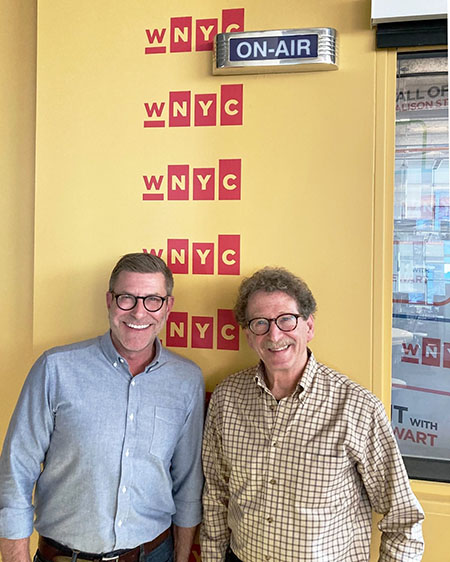 “We all believe very strongly in the power of place,” co-director Andrew Dolkart shares on WNYC’s “All Of It With Alison Stewart,” in response to the question of how the Project got its start. He continues that before the Project, as professional preservationists, “We were interpreting all kinds of history, but we weren’t interpreting our own [LGBT] history.” REPLAY the full interview and listener call-in session via link in bio!
“We all believe very strongly in the power of place,” co-director Andrew Dolkart shares on WNYC’s “All Of It With Alison Stewart,” in response to the question of how the Project got its start. He continues that before the Project, as professional preservationists, “We were interpreting all kinds of history, but we weren’t interpreting our own [LGBT] history.” REPLAY the full interview and listener call-in session via link in bio!
How is learning about history through place meaningful? Co-director Ken Lustbader had the answer: it allows you to “have a visceral connection to the past and see where history took place. For example, you could look at the place where James Baldwin lived on the Upper West Side and you can see the doorway that he went into, to his apartment on the ground floor. That’s a definite connection to an individual who was so important to American history. And it’s different than simply reading about it in a book … *There’s* the location, and *that’s* the connection.”
The episode highlighted the work of co-director Jay Shockley to document LGBT associations with Broadway theaters and the numerous National Register of Historic Places nominations researched and drafted by project manager Amanda Davis.
Listen to the full story below, and on WNYC’s website
The Project’s Amanda Davis Testifies in Support of Paul Rudolph Landmark Designation
November 28, 2023
Today, the NYC Landmarks Preservation Commission held a public hearing to hear testimony on Paul Rudolph’s Modulightor Building. Project manager Amanda Davis was on hand to offer testimony in support of designation of this important building.
See Amanda’s full testimony below:
Testimony in Support of the Proposed Designation of the Modulightor Building, 246 East 58th Street, Manhattan, as a New York City Landmark
Tuesday, November 28, 2023
My name is Amanda Davis and I am the project manager of the NYC LGBT Historic Sites Project, a cultural heritage initiative founded by historic preservationists in 2015 to document historic places connected to the lesbian, gay, bisexual, and transgender community in the city’s five boroughs.
The Project strongly supports the designation of The Modulightor Building as a New York City Landmark. The building was designed by eminent architect and iconic modernist Paul Rudolph, who was openly gay. While this would not be the first LPC-designated landmark designed by an LGBTQ architect, the designation of The Modulightor Building has the opportunity to be the first in the LPC’s history to officially acknowledge an architect’s gay identity. This provides a small but important step in making LGBTQ history visible. The Modulightor Building is one of over 450 historic places our project has documented that illustrate the contributions that LGBTQ people have made to New York and American history and culture. It is also included in our website’s “Art & Architecture” thematic collection of sites, in order to celebrate the impact of LGBTQ people on the city’s built environment.
Paul Rudolph and Ernst Wagner, who lived and worked together until Rudolph’s death, founded Modulightor in 1975. They developed a system of lighting fixtures that could be combined in countless variations, as well as furniture and other interior accessories. In 1990, Modulightor moved into a four-story building at 246 East 58th Street, which Rudolph and Wagner jointly purchased the year before. Rudolph modified the existing structure, moving his architectural office to the second story. Modulightor’s showroom and production facility occupied the ground story, mezzanine, and three sub-basements.
The interior was the last in New York City completed by Rudolph during his lifetime, with work based largely on his plans continuing after his death. The building was left to Wagner in Rudolph’s will, and Wagner worked with others to create the Paul Rudolph Foundation in 2001. The subsequent Paul Rudolph Heritage Foundation now occupies the second story. The Foundation notes that “The Modulightor building is the only intact and publicly accessible building designed by Paul Rudolph in New York City.” In addition, it is one of three residential townhouse buildings in Manhattan that display Rudolph’s contributions to American architecture in the 20th century. And it would join a select handful of significant Modernist townhouses in Manhattan to be designated.
The NYC LGBT Historic Sites Project proudly supports this proposed designation.
Thank you.
The Project Publishes its 450th NYC Site Entry
November 2, 2023
The NYC LGBT Historic Sites Project, an award-winning initiative committed to documenting and presenting historic sites connected to the LGBT community throughout New York City, has published the 450th entry to its map of extant NYC buildings, parks, monuments and other places that connect us to the City’s significant LGBT history.
“Reaching 450 LGBT historic sites is an incredible milestone for our project. With new entries like the Chelsea workshop where Gilbert Baker and volunteers sewed the record-breaking mile-long Rainbow Flag for Stonewall 25 in 1994, we continue to shed light on the LGBT history that exists all around us. It’s empowering, especially for queer and trans youth, to learn these stories and to see where they happened.” — Amanda Davis, Project manager
This major milestone comes after eight years of work on the part of the Project team—co-directors Andrew Dolkart, Ken Lustbader and Jay Shockley, plus Project manager Amanda Davis. Founded in 2015, the Project is at once a scholarly initiative and an educational resource for teachers as well as the general public, who may peruse the site and use the Curated Themes as avenues for self-guided discovery.
As the Project team continues its important work in NYC, it is simultaneously a model for other initiatives beyond the five boroughs and a leader in the national conversation on site-based research, advocacy and preservation. The Project was recognized by the National Trust for Historic Preservation with its prestigious Trustees’ Award for Organizational Excellence in 2022, one of the preservation field’s highest honors. The Project is also increasing LGBT representation on the National Register of Historic Places—the federal government’s honorary list of sites deemed significant to American history—in fulfillment of a Underrepresented Communities grant from the National Park Service. Though the National Register includes over 96,600 sites across the country, the LGBT community remains vastly underrepresented—only four sites provided a focus on LGBT history in 2014. Including 10 sites completed through the Project’s grant-funded work, such as the Alice Austen House on Staten Island and the James Baldwin Residence in Manhattan, the number of National Register sites with LGBT representation is now up to 30.
Next, the Project is focused on completing the significant undertaking of adding an LGBT “overlay” to the Greenwich Village Historic District, elevating the history and importance of LGBT individuals and organizations connected to nearly 250 of the more than 1,900 buildings included in the district, originally listed on the National Register of Historic Places in 1979. Extant sites will now be further understood for their connection to people and events of the LGBT community and movement because of the Project’s work.
The Project team continues to expand the website’s coverage of sites across the five boroughs, and publishes new entries regularly.
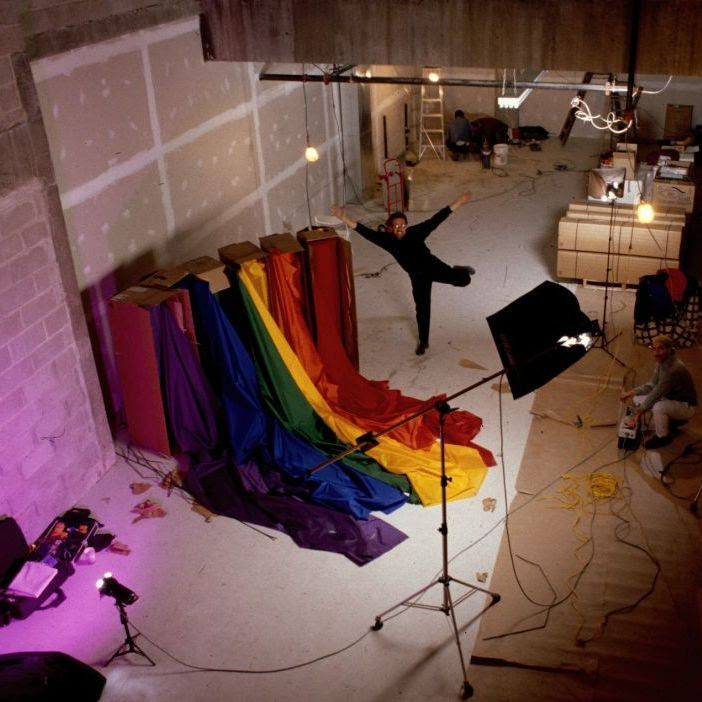
From the website, www.nyclgbtsites.org:
For the Pride March associated with Stonewall 25, held in New York City in June 1994, activist Gilbert Baker envisioned a mile-long Rainbow Flag. Baker moved from San Francisco to New York at the end of 1993. The basement commercial space at 269 West 16th Street became his “Raise the Rainbow” workshop. In anticipation of long hours of sewing, he had white linoleum floors installed to reflect more light in the space. The walls, including the pipes, were painted white and big banks of fluorescent lights ran the length of the room. He also specified the location of a staircase (still there) so that the finished flag could be transported to street level more easily. The workshop accommodated 18 “refrigerator-sized crates,” each holding a bolt of fabric and weighing 400 pounds.
Completed in early June, the mile-long flag, which was entered into the Guinness Book of World Records, weighed 7,000 pounds and measured 30 feet in width. However, the project faced issues from the start … Baker felt that “Stonewall 25 was ultimately a commercial for marketing and merchandising the movement, an advertisement of power rather than an act of empowerment.” He decided, early in the morning of June 25, 1994, the day of the Pride March, to secretly veer from the agreed upon plan; once the flag, carried by about 5,000 volunteers, reached First Avenue and East 57th Street, Baker, wearing a handmade sequined gown, surprised nearly everyone by cutting the front of the flag into ten large sections. He and several friends each carried a section to an alternate, non-permitted Fifth Avenue march that had been planned to bring attention to the AIDS epidemic.
Images of the Rainbow Flag on both avenues made the front page of the New York Times and other outlets, turning the flag, 16 years after its creation, into a globally recognized icon.
To read more, visit the website entry.
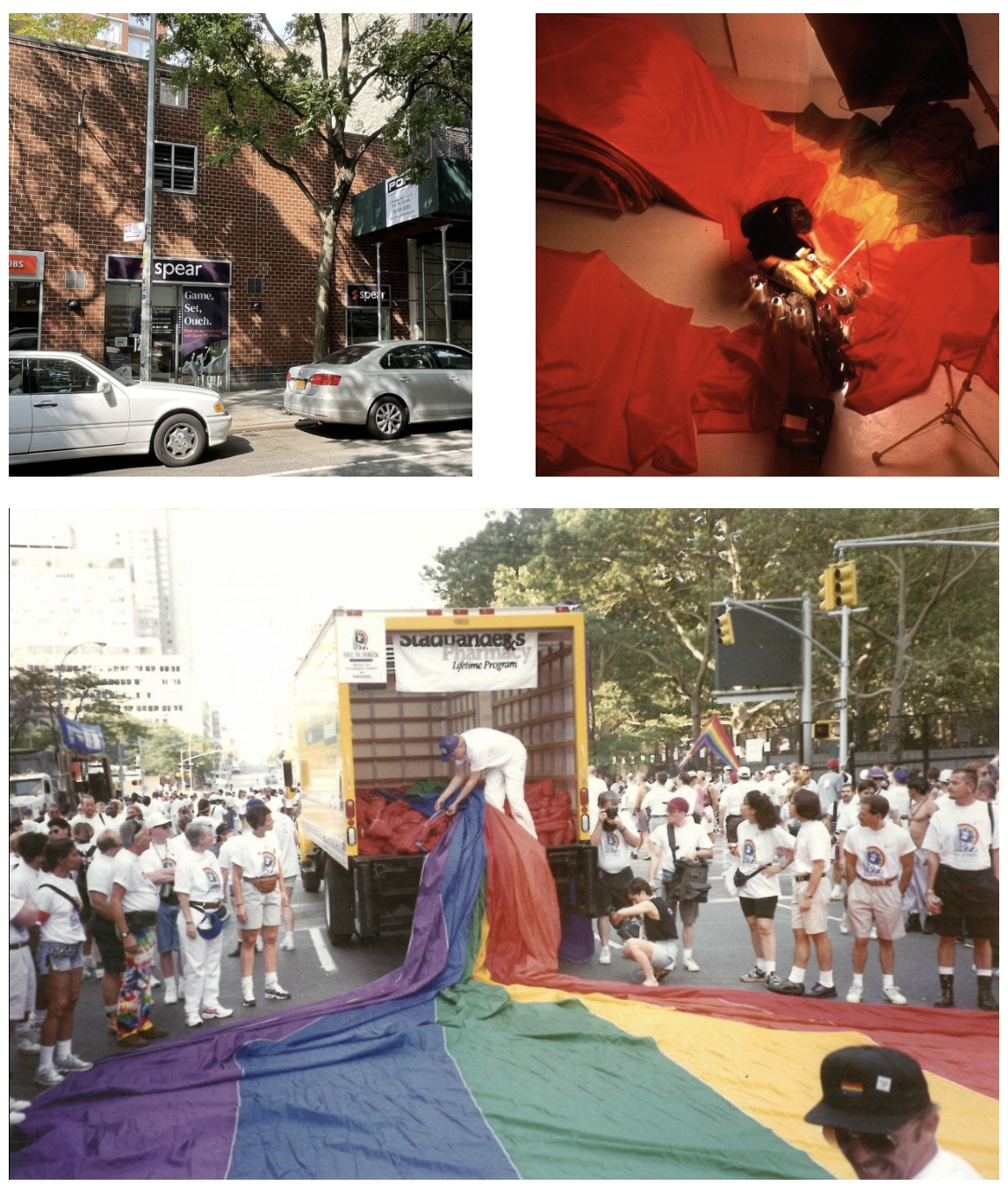
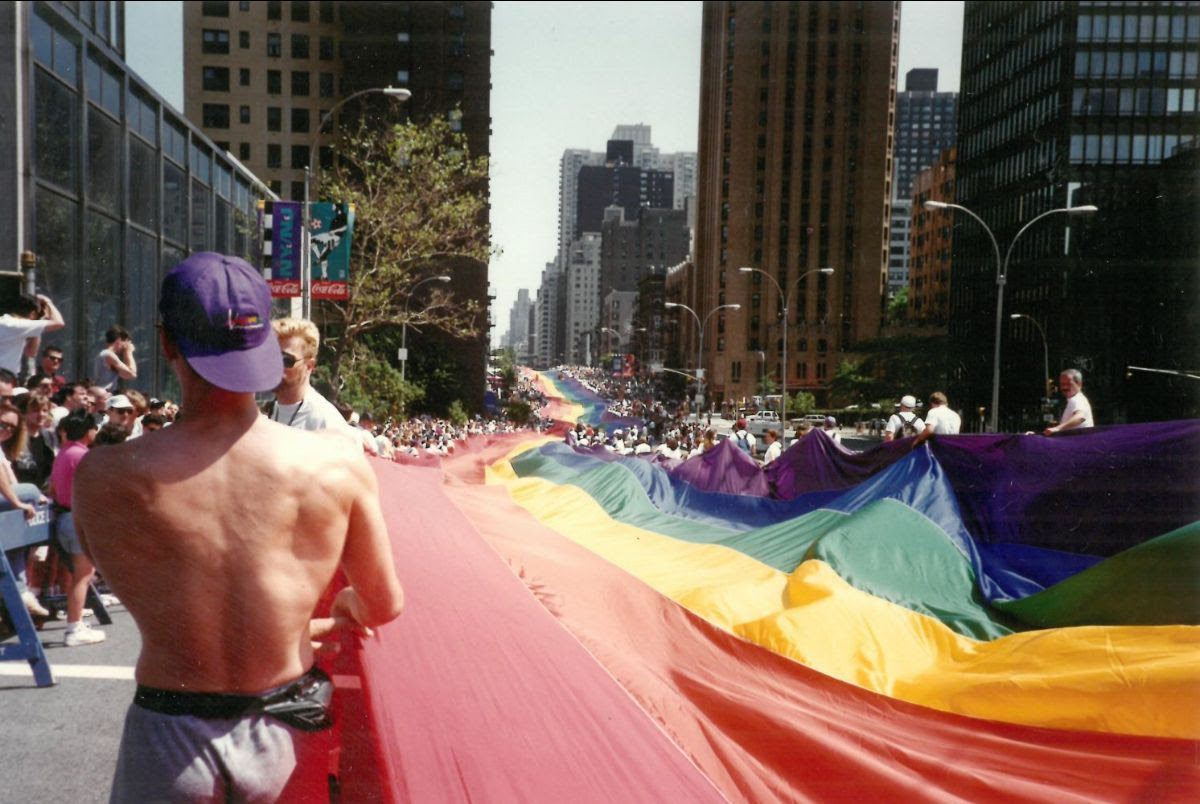
Photos, top to bottom, left to right: (1) Gilbert Baker at the Chelsea workshop, 1993. Photo by Mick Hicks, courtesy of the Gilbert Baker Foundation; (2) Exterior of 269 West 16th Street, Manhattan; (3) Gilbert Baker sewing the mile-long Rainbow Flag at the Chelsea workshop. Photo by Mick Hicks, courtesy of the Gilbert Baker Foundation; (4) Tom Taylor unties the Flag as it is removed from the truck at NYC Pride, June 1994. Photo by Charley Beal. Courtesy of the Gilbert Baker Foundation; (5) The mile-long Rainbow Flag on First Avenue, looking north from East 48th Street, at NYC Pride, June 1994. Photo by Charley Beal. Courtesy of the Gilbert Baker Foundation.
WATCH: NYC LGBT Historic Sites Project Receives Prestigious Trustees’ Award from the National Trust for Historic Preservation
November 5, 2022
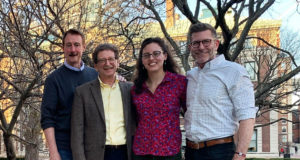 The NYC LGBT Historic Sites Project is thrilled and honored to share that our work to identify and document NYC’s place-based LGBT history was honored by the National Trust for Historic Preservation Friday, November 4th, with their Trustees’ Award for Organizational Excellence, one of our field’s highest honors. The award was given at the PastForward Conference, in a ceremony hosted by old house icon Bob Vila.
The NYC LGBT Historic Sites Project is thrilled and honored to share that our work to identify and document NYC’s place-based LGBT history was honored by the National Trust for Historic Preservation Friday, November 4th, with their Trustees’ Award for Organizational Excellence, one of our field’s highest honors. The award was given at the PastForward Conference, in a ceremony hosted by old house icon Bob Vila.
“Each year at the PastForward Conference we come together to recognize those making a real difference in historic preservation. This year’s recipients embody not just the preservation of American history, but also demonstrate how preserving historic places can play a key role in addressing critical issues of today, including climate change, equality, and housing.” — Paul Edmondson, president and CEO of the National Trust for Historic Preservation
Since its founding in 2015, the Project has now identified, researched and mapped over 400 sites across New York City’s five boroughs which connect the public viscerally to the places — residences, bars and venues, public spaces, and more — where LGBT people have contributed to American culture.
About the Trust’s selection of the Project for the 2022 Trustees’ Award for Organizational Excellence: The NYC LGBT Historic Sites Project is a nationally-recognized and influential cultural heritage initiative and educational resource that identifies and documents diverse extant LGBT sites from the 17th century to 2000. The only permanent organization of its kind in the US, the project staff have created an interactive website, National Register nominations, publications and public programs, and school educational materials, among other resources. Sitting at the intersection of historic preservation and social justice, the organization has been particularly eager to document LGBT sites associated with women and Black, Asian, Latinx, trans, and gender-variant communities. In the near future, they hope to prioritize local sites of LGBT history associated with Indigenous and Two Spirit Peoples.
Greenwich Village, Storied Home of Bohemia and Gay History
November 21, 2022
By: Michael Kimmelman
from The New York Times
The architectural historian Andrew Dolkart leads a walk past landmarks like the Stonewall Inn, Julius’ bar and the home of Lorraine Hansberry; excerpted from Kimmelman’s new book, “The Intimate City: Walking New York.”
Testimony in Support of the Proposed Designation of the Julius’ Bar Building as a New York City Landmark
November 11, 2022
To be presented by Project co-director, Andrew Dolkart, at the NYC Landmarks Preservation Committee public hearing on Tuesday, November 15, 2021.
My name is Andrew Dolkart, and I am one of the co-directors of the NYC LGBT Historic Sites Project, a cultural heritage initiative founded by historic preservationists in 2015 to document historic places connected to the lesbian, gay, bisexual, and transgender community in the city’s five boroughs.
The Project strongly supports the designation of the Julius’ Bar Building as a New York City Landmark. In the early 1990s, my co-directors, Jay Shockley and Ken Lustbader, and I were part of the Organization of Lesbian and Gay Architects + Designers (OLGAD), a pioneering group that advocated for LGBT historic sites at a time when the field of historic preservation paid little attention to sites of cultural significance, let alone ones connected to the LGBT community. In 1994, OLGAD created what we believe is the first map in the country to document LGBT historic places, and the building that houses Julius’ was included in this effort.
In 2015, when the NYC LGBT Historic Sites Project formed, one of our first priorities was to continue what OLGAD began more than twenty years earlier. We took the initiative to undertake the necessary research and write the text for the nomination of Julius’ to the National Register of Historic Places, which was approved in April 2016, one day before the 50th anniversary of the so-called “Sip In”.
Julius’ is located just a few minutes’ walk from the more famous Stonewall Inn, but its place in LGBT history is just as significant. The events at Stonewall in June 1969 did not exist in a vacuum. In the decades leading up to that uprising, bars were one of the few places that LGBT people could gather openly. Yet, at the same time, there were always inherent risks since the mere presence of a homosexual in a bar was considered to be disorderly: frequent police raids and other forms of entrapment could lead to arrest, loss of employment, and physical and mental abuse, among other threats. With photographers in tow, the game-changing public action by the Mattachine Society on April 21, 1966, which culminated at Julius’, was the earliest planned effort to capture LGBT discrimination in real time.
When we give walking tours in the area, we typically end at Julius’, and young people, in particular, are often surprised to learn that at one time, even in New York City, even in Greenwich Village, LGBT people faced these hardships in bars, of all places. Julius’ is therefore not only a great place to gather and have drinks with friends, but also a valuable teaching tool.
We thank Helen Buford, the owner of Julius’, for her incredible stewardship of the bar and its history, and for collaborating with and supporting our Project from the very beginning. The NYC LGBT Historic Sites Project proudly supports this proposed designation.
Thank you.
Plaque Unveiling at Caffe Cino, on Joe Cino’s 91st Birthday
November 17, 2022
The following remarks were presented by Amanda Davis, NYC LGBT Historic Sites Project manager, at the November 16, 2022 unveiling of the plaque at the former Caffe Cino, celebrating the building on the National Register of Historic Places.
Thank you to everyone who has come out today to celebrate the Caffe Cino, which Joe Cino opened nearly 65 years ago here at 31 Cornelia Street. I’d like to thank David Wilder and the staff of Bombay Bistro for collaborating with us today on this plaque unveiling and to the Cino alums that are here today, especially Magie Dominic, who will be sharing some remarks after me. We would not have been able to list the Caffe Cino on the National Register of Historic Places without Magie’s archive and knowledge of the Caffe Cino.
My name is Amanda Davis, and I’m the project manager of the New York City LGBT Historic Sites Project. We’re a cultural heritage initiative that, since 2015, documents historic places in the city’s five boroughs that have important connections to the LGBT community, from the 17th century to the year 2000. Our website features an interactive map of over 400 places (and counting), and we also give walking tours, host public programs, and advocate for official landmark status to help formalize the significance of LGBT historic sites in New York and American history.
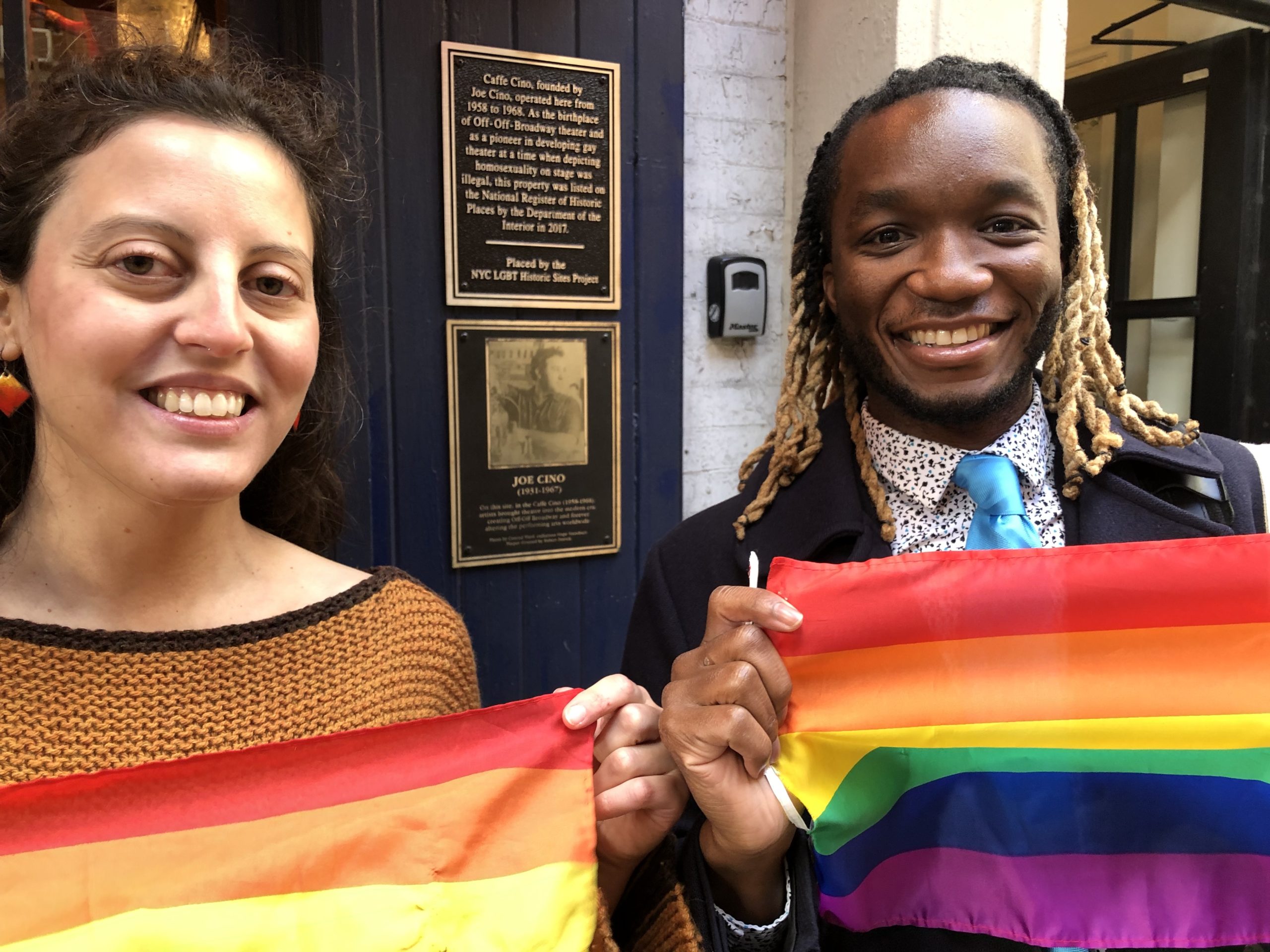
In 2017, we successfully listed the Caffe Cino building to the National Register of Historic Places, in recognition of its significance as the birthplace of Off-Off-Broadway and as a pioneer in the development of gay theater at a time when depicting homosexuality on stage was illegal. The Caffe Cino is one of my favorite sites that I’ve ever researched – a wonderfully quirky, vibrant, and touching story that comes right out of the pages of what Greenwich Village must have been like during the 1960s. For most of the 20th century, this area was very Italian, something that Joe Cino would use to his advantage when he stood here, in December 1958, with his then-boyfriend, Ed, who showed Joe a “for rent” sign on the storefront space at 31 Cornelia Street and introduced him to the landlady, Mrs. Leema, who was looking out her upstairs window. Once they made the connection that she was Italian and Joe was Sicilian, Mrs. Leema said, “I don’t even have to come down, I’ll throw the keys.” And from there, Joe said, in his only known interview, he and Ed “went in and viewed the ruins.” He saw the potential in the tiny room, already envisioning where the counter and coffee machine would go.
The Caffe Cino opened soon after and by 1960, plays were being staged. A year later, playwright Doric Wilson helped establish the Cino as a venue for new work with four plays – two of which included gay themes. The Cino’s breakthrough hit came in 1964 with the staging of Lanford Wilson’s The Madness of Lady Bright, which was centered on an aging drag queen slowly going mad alone in his room. It was so popular that within a year, the Caffe became particularly well known for presenting gay or gay-friendly works. The most successful production here was Dames at Sea, which introduced teenager Bernadette Peters in 1966.
It’s impossible to tell the Cino’s whole story today or even mention the impressive list of theater artists associated with it, but perhaps it’s best summed up by saying that the Cino was a place where Joe Cino encouraged anyone to write about anything they wanted. For gay playwrights, in an era of widespread homophobia, this provided a level of freedom to write gay-themed work at a level never before experience on the New York stage. The Caffe Cino is, as I like to say, a true testament to the arts as a powerful platform for change. In the 1960s, before the Stonewall Uprising and the Gay Liberation era led to increased visibility for LGBT people, gay theater artists at the Cino gave audiences rare public exposure to multi-dimensional and realistic gay characters, and, in doing so, challenged the negative and stereotypical portrayals that had permeated
mainstream theater and film for decades. What we see on stage or on screen very often affects how we view each other and even view ourselves. Although the Cino closed in 1968, following the tragic suicide of Joe Cino a year earlier, the gay theater that it had nurtured continued to evolve with the emergence of gay theater companies, some of which were founded by Cino alums.
We’re honored to be able to unveil the National Register plaque on what would be Joe Cino’s 91 st birthday, and also celebrate the return of the plaque donated by playwright Robert Patrick in 2008.
Pictured, Amanda Davis with Tevin Williams, representing State Sen. Brad Hoylman.
A Visit to Ferncliff Cemetery
October 24, 2022
By: Amanda Davis
Happy LGBT History Month! A couple of weeks ago, I visited Ferncliff Cemetery in Hartsdale, New York, just north of the city in Westchester County. It’s a place I’ve been wanting to visit for a few years now because it’s where writer and activist James Baldwin is buried.
Before my mother and I drove to the cemetery, I looked up the “Celebrities & Notables” list on Ferncliff’s website to see who else we might visit. It’s a pretty impressive list!
LGBT notables there that we didn’t visit, due to time constraints, include society leader Elsa Maxwell (1883-1963), actress Ona Munson (1910-1955), who played Belle Watling in Gone with the Wind (1939), and novelist Cornell Woolrich (1903-1968). Also of note is Conrad Veidt (1893-1943), a straight actor who starred in what is believed to be the world’s earliest pro-gay film, the German silent movie Different from the Others (1919). It was co-written by sexologist Magnus Hirschfeld, who is not buried at Ferncliff but whose 1930s visit to New York City is mapped on our website. Gay icon Judy Garland (1922-1969) was interred at Ferncliff until 2017, when she was moved to Hollywood Forever Cemetery in Los Angeles at the request of her daughter, Liza Minnelli.
The following three people from Ferncliff’s list of notables — all pioneering LGBT African Americans — are featured on our website. With Pride flag in hand, my mother and I navigated our way around the cemetery to pay our respects on what turned out to be a picture-perfect October day.
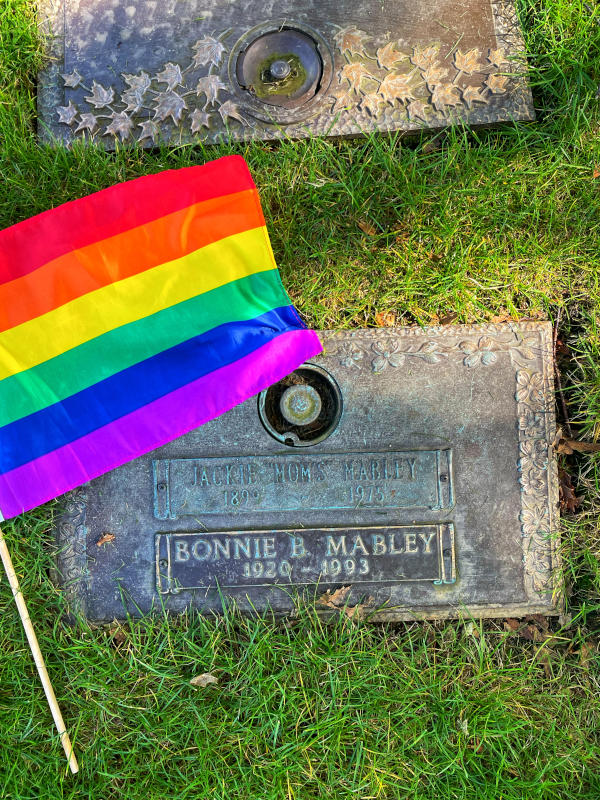
The first gravesite we visited was Jackie “Moms” Mabley (1899-1915), a stand-up comedian in the mid-20th century who was known as “The Funniest Woman in the World.” She is mentioned in two places on our website: the Apollo Theater in Harlem, where she is credited as the first woman to headline a performance there, and the Ed Sullivan Theater in Midtown, where she appeared on The Ed Sullivan Show in the 1960s.
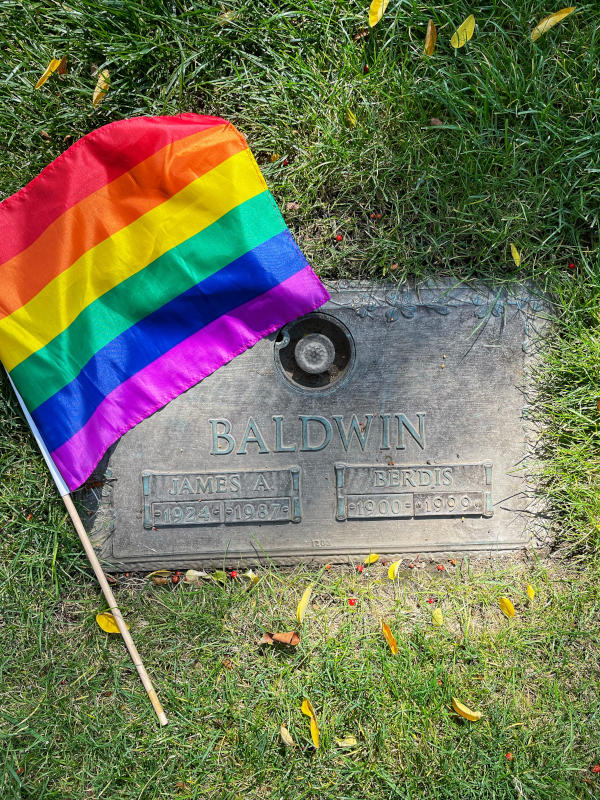
We next visited novelist and civil rights activist James Baldwin (1924-1987). He is featured in several places on our website, including his Upper West Side residence, which we successfully nominated to the National Register of Historic Places in 2019 for its significance to Black and LGBT history. The rowhouse at 81 Horatio Street in Greenwich Village, where he lived from 1958 to 1961, was where he worked on his third novel, Another Country (1962). This December will mark the 35th anniversary of his death.
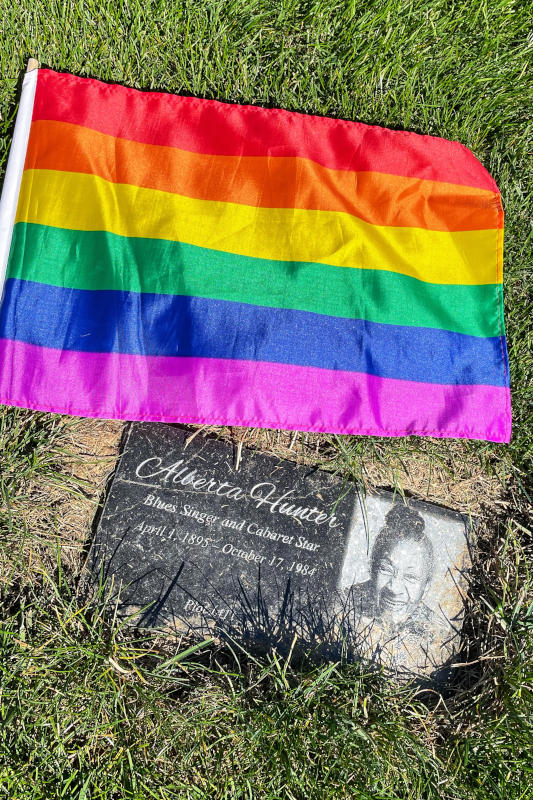
Our last stop was the gravesite of blues legend Alberta Hunter (1895-1984). She is featured in several places on our website, including her Harlem residence at 133 West 138th Street, which she owned from 1927 until at least 1945, and the Apollo Theater, where she performed.
I almost thought we weren’t going to find her because when we followed the grave numbering system the spot where she should have been was just a patch of grass. We looked in several other places and then, when I was just about to call it a day, I looked to my right and saw her smiling face looking back at me! If you’d like to visit her just know that she’s in the same row that you’d think she’d be (if you follow the numbering system) but she’s a bit further down to the left. We also shared a quick clip of the Pride flag swaying in the breeze by her gravesite on our Instagram page to commemorate the anniversary of her death on October 17th.
More Cemetery Tributes
The NYC LGBT Historic Sites Project team loves paying tribute to LGBT people in their final resting places. Co-director Jay Shockley and I visited Congressional Cemetery in Washington, D.C., last month to visit the likes of gay rights leaders Frank Kameny, Barbara Gittings, Kay Lahusen, and Leonard Matlovich, as well as Alain Locke, known as the “Dean” of the Harlem Renaissance. You can catch our Instagram Reel from that trip.
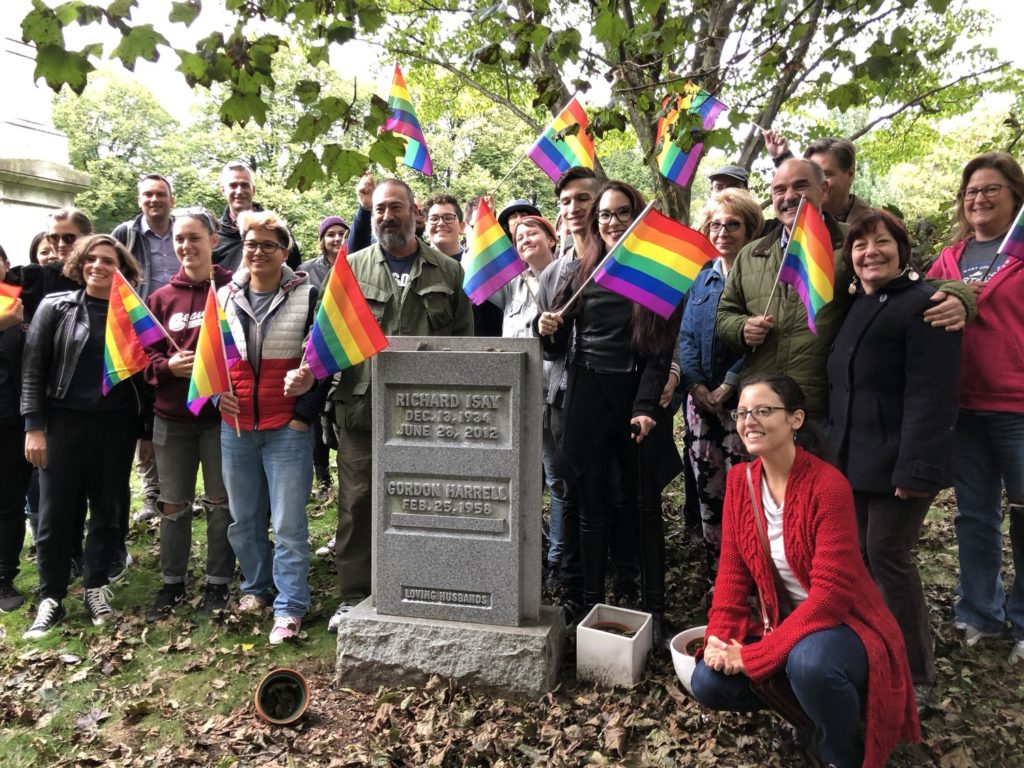
Want to join us in the future? We lead cemetery tours annually at Green-Wood Cemetery in Brooklyn and Woodlawn Cemetery in the Bronx and place Pride flags at the gravesites of LGBT notables. These are typically held in either the spring or the fall and are always very moving and popular events. Follow us on social media (@nyclgbtsites) or subscribe to our email list (sign-up box below) to be the first to know the next time we schedule an outing.
In Support of Lesbian Herstory Archives NYC Landmark Designation
October 20, 2022
to be presented at public hearing on October 25, 2022
Testimony in Support of the Proposed Designation of the
Lesbian Herstory Archives, 484 14th Street, Brooklyn,
as a New York City Landmark
Tuesday, October 25, 2022
My name is Amanda Davis and I am the project manager of the NYC LGBT Historic Sites Project, a cultural heritage initiative founded by historic preservationists in 2015 to document historic places connected to the lesbian, gay, bisexual, and transgender community in the city’s five boroughs.
The Project strongly supports the designation of the Lesbian Herstory Archives as a New York City Landmark, the first LGBT historic site to be designated in Brooklyn. When we launched our website with an inaugural 100 sites, the Lesbian Herstory Archives was included. Founded in 1974 in the Upper West Side apartment of Joan Nestle, the Archives bought its current Park Slope rowhouse in 1991, officially reopening in June 1993. The purchase ensured that the Archives would have a permanent space, which continues to serve the lesbian community today. Its resources, particularly its archival photographs, have been invaluable to our Project in documenting many of the over 400-plus sites on our website.
With a history that spans nearly fifty years – thirty of those years in Park Slope – the Lesbian Herstory Archives is likely the first, long-standing, lesbian-specific community space in New York City. It is also an early example of a group run by and for lesbians. The Archives was born out of a need to provide a voice for lesbians, who often felt underrepresented and unheard in gay male-dominated groups, and to connect emerging lesbian artists and writers with more established ones, at a time when lesbians were less visible in mainstream culture. Access to previously unknown lesbian-affirming literature, ephemera, and other archival items has also empowered women and linked them with their past. Archives coordinator Saskia Scheffer once noted that “Most people would throw everything out about lesbians, or only keep the negative things. … But the Archives house the collective memory of what happened to us as a group.”
The Lesbian Herstory Archives’ location in Park Slope also speaks to the importance of the neighborhood to LGBT history. By the 1990s, Park Slope was popular with lesbians and their families as a place to live and find community, and several lesbian-associated groups and businesses, including the Archives, operated there. As a result, the designation of the Lesbian Herstory Archives building as a New York City Landmark would also highlight and celebrate Park Slope’s historic significance to the lesbian community.
The NYC LGBT Historic Sites Project proudly supports this proposed designation.
Thank you.
PHOTOS: Plaque Unveiled at Julius’ Bar, Commemorating History-Making Act of Civil Disobedience
April 22, 2022
FOR IMMEDIATE RELEASE
PHOTOS: Plaque Unveiled at Julius’ Bar, Commemorating History-Making Act of Civil Disobedience
Activists, preservationists, historians and others gather to honor the site of the 1966 “Sip-In” at Julius’, on 56th anniversary of event
NEW YORK, NY —On April 21, 2022, Village Preservation, the NYC LGBT Historic Sites Project, the owner of Julius’ Bar, Broadway star John Cameron Mitchell, LGBT activist and 1966 “Sip-In” participant, Randy Wicker, and others, gathered for the unveiling of a plaque to acknowledge Julius’ significance to LGBT activism and history.
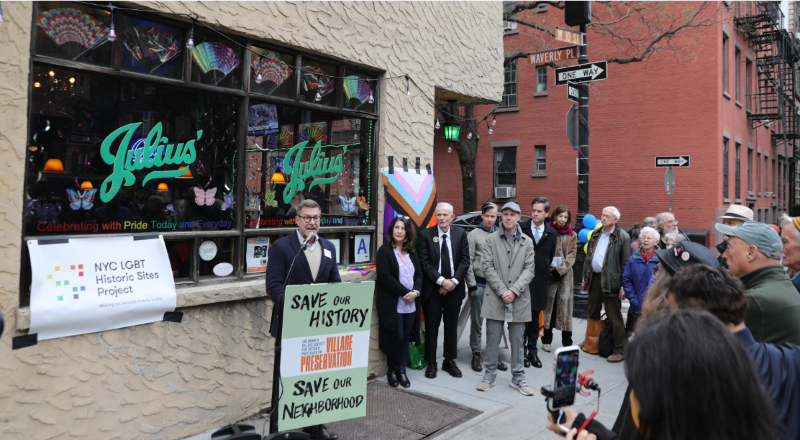
On April 21, 1966, members of the Mattachine Society, an early gay rights group, organized what became known as the “Sip-In” to challenge New York State Liquor Authority (SLA) regulations that were promulgated so that bars could not serve drinks to known or suspected gay men or lesbians, since their presence was considered de facto disorderly. The SLA regulations were one of the primary governmental mechanisms of oppression against the gay community because they precluded the right to free assembly. This was particularly important because bars were one of the few places where gay people could meet each other.
Mattachine members Dick Leitsch, Craig Rodwell, and John Timmons, accompanied by several reporters, went to a number of bars to document this discrimination. At Julius’, where they were joined by Randy Wicker, the group announced that they were “homosexuals” and asked to be served a drink — the bartender refused their request. This refusal received publicity in The New York Times and the Village Voice and was the first time LGBTQ discrimination had been proactively documented in mainstream media. The reaction by the SLA and the newly-empowered New York City Commission on Human Rights resulted in a change in policy and the birth of a more open gay bar culture. Scholars of gay history consider the “Sip-In” at Julius’ a key event leading to the growth of legitimate gay bars and the development of the bar as the central social space for urban gay men and lesbians.
Ken Lustbader, NYC LGBT Historic Sites Project: “Today we make an invisible history visible by installing a commemorative plaque on the exterior of Julius’ bar, an important location in LGBTQ history. In April 1966, courageous activists staged a ‘Sip-In’ to publicize the homophobic discrimination that the LGBTQ community experienced in bars, which could refuse them service if suspected of being homosexual. These pre-Stonewall trailblazers challenged the idea that LGBTQ people were second-class citizens — they deserved safe and welcoming places to socialize and build community. The NYC LGBT Historic Sites Project is proud to have undertaken extensive research and writing when nominating Julius’ to the State and National Registers of Historic Places in 2016 for LGBTQ history. Since then, we have nominated an additional ten sites directly associated with LGBTQ history. With the recent pushback of LGBTQ rights and attacks on queer people throughout the country, we’re proud to join with our partners at Village Preservation and Helen Buford, owner of Julius’, to formally memorialize this history with this tangible plaque. It will provide intangible benefits of identity, pride, and a connection to the past.”
Andrew Berman, Village Preservation: “As the city’s oldest gay bar and home of the pioneering 1966 ‘Sip-In’ protesting anti-gay discrimination, we are proud to be placing a plaque at Julius’ with our partners at the NYC LGBT Historic Sites Project to honor this uniquely important civil rights site. Three years before Stonewall, when being gay was still considered a crime, these brave individuals protested for their right to gather free from harassment and discrimination. This is part of a long tradition of pioneering efforts for civil rights for LGBTQ people, African Americans, women, immigrants, and many others rooted in this neighborhood, from the first free black settlement in North America located here in the 17th century, to the fight for Women’s suffrage here in the late 19th and early 20th centuries, to the Stonewall Rebellion and many other agitations for LGBTQ+ rights which took place here in the late 20th century. We’re thrilled to be able to add this site as our 19th historic plaque in our neighborhoods, which have marked the homes of figures from James Baldwin to Jane Jacobs, Lorraine Hansberry to LeRoi Jones, Anais Nin to Alex Haley. We’re especially proud given that in 2012 we were able to get Julius’ determined eligible for the State and National Registers of Historic Places, when few LGBTQ+ sites had ever received such a determination, and we continue to advocate for individual New York City landmark designation for the site.”
About the NYC LGBT Historic Sites Project
The award-winning NYC LGBT Historic Sites Project, launched in 2015, is the culmination of over 30 years of research and advocacy by its founders, who are national pioneers in the historic preservation of LGBT sites. Their initial efforts to nominate the Stonewall Inn to the National Register of Historic Places in 1994 came to fruition five years later, and further efforts secured the designation of Stonewall National Monument in 2016. The NYC LGBT Historic Sites Project has since nominated eleven more LGBT sites to the National Register, from James Baldwin’s residence on the Upper West Side to the Women’s Liberation Center in Chelsea. In addition, six LGBT sites that the Project recommended to the NYC Landmarks Preservation Commission, including the Audre Lorde Residence on Staten Island and the Gay Activists Alliance Firehouse in Soho, became city landmarks in 2019. The Project also highlights the city’s LGBT history beyond Greenwich Village with a website of nearly 400 diverse places in all five boroughs. Dating to the 17th century, these sites illustrate the community’s influence on NYC and American history and culture.
The Project further disseminates its work by providing walking tours (also accessible through a free app), presenting lectures, engaging the community through events, developing educational programs for New York City public school students, and sharing its content through robust social media channels. Its goal is to make an invisible history visible while fostering pride and awareness for LGBT people around the world.
About Village Preservation
Since 1980 Village Preservation (VP) has documented, celebrated, and fought to preserve the special architectural and cultural heritage of Greenwich Village, the East Village, and NoHo, successfully advocating for landmark designation of over 1,500 buildings, and zoning protections for nearly 100 blocks. VP places a special emphasis on civil rights and social justice history connected to our neighborhoods; in 1999 it was co-applicant for listing Stonewall on the State and National Register of Historic Places — the first time any LGBTQ+ site had ever been so honored in the country — and in 2015 successfully helped lead the campaign for individual NYC landmark designation of the site. VP has also successfully proposed and secured landmark designation of the former NAACP headquarters, the LGBT Community Center, the Gay Activists Alliance Firehouse, and the studio of Jean-Michel Basquiat, among other sites.
Village Preservation offers 80 public programs annually about our neighborhoods’ histories; a need-blind children’s education program focused on architecture, African American history, and immigrant history; dozens of online maps and tours, including our Civil Rights and Social Justice Map, with over 150,000 views; a 4,000 piece historic image archive; and a collection of over 60 oral histories with important figures in the civil rights, social justice, artistic, literary, business, and cultural history of our neighborhoods.
Web: www.nyclgbtsites.org & www.villagepreservation.org
Instagram: @nyclgbtsites & @gvshp_nyc
Twitter: @nyclgbtsites & @gvshp
Facebook: /nyclgbtsites & /villagepreservation
###
Women’s Liberation Center listed to National Register of Historic Places
June 29, 2021
WOMEN’S LIBERATION CENTER
RECOGNIZED AS NATIONALLY-SIGNIFICANT
HISTORIC SITE
NYC LGBT Historic Sites Project research and advocacy leads to
listing of site connected to lesbian activism and herstory
on State and National Registers of Historic Places
NEW YORK, NY—Tuesday, June 29, 2021— The site of the Women’s Liberation Center, located at 243 West 20th Street from 1972 to 1987, has been listed on the New York State and National Registers of Historic Places. In the early 1970s, the Women’s Liberation Center was founded as an important meeting space for many women’s groups, including those that specifically served the lesbian community.
The Women’s Liberation Center was designated a New York City Individual Landmark in June 2019, following research and key advocacy by the NYC LGBT Historic Sites Project, in collaboration with key allies such as NYC Councilmember Corey Johnson. This latest designation speaks to the significance of the Women’s Liberation Center beyond New York City, to our state and national history.
Emily Kahn, consultant for the NYC LGBT Historic Sites Project: “Listing the Women’s Liberation Center on the National Register of Historic Places recognizes the strong activism, community building, and empowerment of women and lesbians in New York City. Yet, by being listed under national level significance, the Women’s Liberation Center continues its legacy of championing for the representation of women’s and LGBT history and culture nationwide. Just as new feminist groups formed at the WLC, I hope that additional National Register listings honoring women, especially queer women, will emerge in the aftermath of the WLC’s listing. Special thanks are due to the site’s current tenant, Nontraditional Employment for Women, for their help completing this nomination during the pandemic and ongoing work to empower women!”
Erik Kulleseid, Commissioner of the NYS Office of Parks, Recreation and Historic Preservation: “We are proud to have our partners at the NYC LGBT Historic Sites Project continue advancing listings on the New York State and National Registers. Their work is extraordinary; benefiting the much-deserved recognition of the history and accomplishments of our state’s LGBT+ communities and significant individuals. The Women’s Liberation Center increased the visibility of lesbians during the 1970s- and 80s-women’s liberation era and this designation pays tribute to the countless women who fought for equality historically and continue the movement today.”
Sarah Carroll, Chair of the Landmarks Preservation Commission: “In 2019, the Landmarks Preservation Commission designated the Women’s Liberation Center for its role in the LGBTQ civil rights movement and listing on the National Register is an important recognition that reinforces the building’s historical and cultural significance.”
243 West 20th Street, the former location of the Women’s Liberation Center in (l) c. 2016. Credit: Christopher D. Brazee/NYC LGBT Historic Sites Project; (r) c. 1980s. Courtesy NYC Landmarks Preservation Commission.
From the National Register nomination, completed by the NYC LGBT Historic Sites Project: The Women’s Liberation Center (WLC) is significant under criterion A in the area of social history: LGBT and Women’s Rights as the first permanent advocacy space for women’s and lesbians’ organizations in New York City and as one of the earliest examples of a feminist gathering space nationwide. Founded in 1970 and relocated to 243 West 20th Street in 1972, the WLC served as a meetinghouse and a clearinghouse for grassroots, radical organizations associated with the women’s and lesbian liberation movements. Due to the ability of women of all backgrounds to gather and share ideas in this space, the WLC helped foster an increased acceptance of lesbians within the women’s liberation movement and illustrated the nationwide trend for lesbian organizations to operate out of women’s centers. The inclusion of multiple perspectives from diverse organizations helped to create a more radical version of feminism and affirmed the need for women’s spaces within male-dominated society.
Two prominent lesbian organizations — Lesbian Feminist Liberation and Lesbian Switchboard — developed at the WLC in the early 1970s to advocate for increased rights for and improved visibility of lesbians. In addition to serving as a pioneering women’s space, the WLC also helped to cultivate lesbian activism both within and separate from the general gay liberation movement, which often overlooked lesbian issues. By serving as an alternative to the general movement, the WLC provided women with increased autonomy to advocate for their own rights both inside of and separate from the gay liberation movement. The WLC set a precedent for other LGBT centers and activism spaces, showing how these centers could focus not only on the political but also on the social and cultural needs of LGBT individuals. Finally, the WLC fostered ongoing and increasing partnerships between feminists and lesbians, representing a departure from earlier tensions in the second-wave women’s liberation movement. Although the WLC closed in 1987, activists and organizations associated with the WLC have been influential in instituting women’s and gay rights into the political agenda of the state and the nation since.
The building is exceptionally significant under criterion exception G for its pivotal and sustaining involvement in numerous aspects of the second wave of the women’s liberation movement, for its early support of lesbian activism and gatherings at a time when the latter were shunned by other women’s and gay rights organizations, as the first permanent advocacy space for women’s and lesbians’ organizations in New York, and for its precedent setting advocacy of feminist gathering spaces nationwide. The building continues to serve as a space for women’s activities today. The period of significance captures the most significant and influential years of the group’s existence, beginning with its move into this building in 1972 and concluding when the group disbanded in 1987.
“Marching for Pride: The Basics,” Fact Sheet for Pride March Anniversary, Released
June 23, 2020
FOR IMMEDIATE RELEASE
June 23, 2020
Media Contacts
Nick Porter [email protected] / 909-262-5920
Cristiana Peña [email protected] / 516-320-0038
TO MARK 50TH ANNIVERSARY OF FIRST-EVER NYC PRIDE MARCH,
NEW FACT SHEET PROVIDES HISTORICAL FOUNDATION FOR CELEBRATION
“Marching for Pride: The Basics” Answers Fundamental Questions about the
People and Events that Created NYC Pride
NEW YORK, NY — Tuesday, June 23, 2020 — The Stonewall 50 Consortium, Making Gay History, NYC LGBT Historic Sites Project, New York Public Library, GLSEN, National Parks Conservation Association, and the ONE Archives Foundation announce the release of “Marching for Pride: The Basics,” a new FAQ-style primer on the first-ever NYC Pride March, which marks its 50th anniversary this coming Sunday, June 28. (“Marching for Pride” is a companion piece to the fact sheet produced last year for the 50th anniversary of the Stonewall uprising, “Stonewall: The Basics.”)
“Marching for Pride: The Basics,” which is co-produced by leaders in LGBTQ history documentation, interpretation, education, and outreach is an easy-to-understand guide to the people, circumstances, and legacy of the first Christopher Street Liberation Day March, which took place on June 28, 1970—the one-year anniversary of the history-making Stonewall uprising of June 28, 1969.
“Most people know almost nothing about the history of the annual Pride march and celebrations held in New York City and cities around the world,” said Eric Marcus, founder and host of the Making Gay History podcast and chair of the Stonewall 50 Consortium. “As we prepared the fact sheet, even I was surprised by how little I knew—and I wrote a history book about the LGBTQ civil rights movement.”
Eric added, “‘Marching for Pride: The Basics’ clarifies the historical record, which was muddied by a recent New York Times article that failed to credit the four people who came up with the idea for the march and made it happen. Because of their foresight, Stonewall’s legacy is now celebrated each year with worldwide commemorations that have helped shape the trajectory of what’s become an international fight against discrimination and for equal rights.”
“Marching for Pride: The Basics” provides answers to fundamental questions such as:
- Where was the first Pride march held? (Hint: It wasn’t New York City.)
- How did New York City’s first Pride march come about?
- Why was the march called the Christopher Street Liberation Day March rather than the Stonewall Anniversary March?
- Who marched in the first NYC Pride march?
“We can’t talk about the legacy of Pride and the Christopher Street Liberation Day March without talking about Craig Rodwell,” said Amanda Davis, manager of the NYC LGBT Historic Sites Project. “Craig, like the larger queer community, felt everything change after the Stonewall uprising on June 28, 1969. Conservative, orderly protest no longer appealed to the new guard of young activists of which he was a part. They wanted ‘to be more relevant, reach a greater number of people, and encompass the ideas and ideals of the larger struggle in which we are engaged—that of our fundamental human rights.’ Craig, along with his partner Fred Sargeant and fellow activists Ellen Broidy and Linda Rhodes, are names we should all know and honor each June, but they rarely receive their due. We’re eager, with this fact sheet, to further educate the LGBTQ community and our allies.”
“Marching for Pride: The Basics” is available online now as a download-ready PDF through the Stonewall 50 Consortium’s website.
Click here to preview “Marching for Pride: The Basics.”
Click here to revisit the companion “Stonewall: The Basics” factsheet.
The co-creators of “Marching for Pride: The Basics” encourage the public to revisit the self-guided walking tour map from the National Parks Conservation Association and the NYC LGBT Historic Sites Project. Launched in 2017 as the first walking tour dedicated to telling the history of the 1969 Stonewall uprising and the fight for LGBTQ rights, the tour connects the public with nearly 20 historic sites significant to the LGBTQ community, anchored by the Stonewall National Monument in New York’s Greenwich Village.
Click here to download the self-guided walking tour map.
About the Co-Creators
NYC LGBT Historic Sites Project
The NYC LGBT Historic Sites Project is a nonprofit cultural initiative and educational resource that is making an invisible history visible by documenting historic and cultural sites associated with the LGBTQ community throughout New York City. For more, visit www.nyclgbtsites.org.
Making Gay History
Making Gay History is a nonprofit organization dedicated to bringing the largely hidden history of the LGBTQ civil rights movement to life through the voices of the people who lived it—principally through the award-winning Making Gay History podcast and LGBTQ-inclusive educational materials. For more, visit www.makinggayhistory.org.
New York Public Library
The New York Public Library is a free provider of education and information for the people of New York and beyond. With 92 locations—including research and branch libraries—throughout the Bronx, Manhattan, and Staten Island, the library offers free materials, computer access, classes, exhibitions, programming, and more to everyone from toddlers to scholars, and has seen record numbers of attendance and circulation in recent years. The New York Public Library serves more than 18 million patrons who come through its doors annually and millions more around the globe who use its resources at www.nypl.org. Learn more at www.nypl.org/help/about-nypl.
GLSEN
GLSEN works to create safe and inclusive schools for all. They envision a world in which every child learns to respect and accept all people, regardless of sexual orientation, gender identity, and/or gender expression. Each year, GLSEN programs and resources reach millions of students and educators in K-12 schools, via action at the national, state, and local level. Over nearly three decades of work, GLSEN has improved conditions for LGBTQ students across the United States and launched an international movement to address LGBTQ issues in education and promote respect for all in schools. Find more information on GLSEN’s policy advocacy, student leadership initiatives, school-based programs, research, and professional development for educators at www.glsen.org.
National Parks Conservation Association (NPCA)
Since 1919, the nonpartisan National Parks Conservation Association has been the leading voice in safeguarding our national parks. NPCA and its more than 1.3 million members and supporters work together to protect and preserve our nation’s natural, historic, and cultural heritage for future generations. NPCA led the campaign for the Stonewall National Monument. For more information, visit www.npca.org.
ONE Archives Foundation
ONE Archives Foundation, Inc., is an independent community partner supporting the ONE National Gay & Lesbian Archives at the University of Southern California (USC) Libraries, the largest repository of LGBTQ materials in the world. The ONE Archives Foundation, Inc. collects, preserves, and protects LGBTQ history, art, and culture in collaboration with ONE Archives at the USC Libraries. To provide access to the ONE collection, the foundation presents and supports projects, programs, exhibitions, and education to share the LGBTQ experience with diverse communities worldwide. For more information, visit www.onearchives.org.
Stonewall 50 Consortium
The Stonewall 50 Consortium is an organization that brings together 240 nonprofit institutions and organizations committed to producing programming, exhibitions, and educational materials related to LGBTQ history and culture.. The mission of the consortium includes helping participating institutions and organizations share ideas and best practices, facilitate potential collaborations, coordinate outreach efforts, and avoid scheduling conflicts and duplication of programming. For more information, visit www.stonewall50consortium.org.
###
Wear Your Pride with NEW “GAY” T-Shirt
May 29, 2020
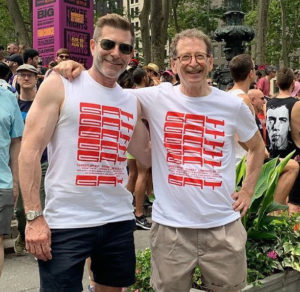 Celebrate Pride with this graphic advertising New York City’s first-ever Pride March, held 50 years ago this June, to commemorate the one-year anniversary of the Stonewall Uprising.
Celebrate Pride with this graphic advertising New York City’s first-ever Pride March, held 50 years ago this June, to commemorate the one-year anniversary of the Stonewall Uprising.
Known then as the Christopher Street Liberation Day March, this incredibly brave, public event attracted thousands of participants. The annual march contributed greatly to solidifying the significance of Stonewall in LGBT history.
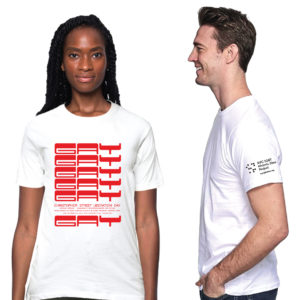
ABOUT THE T-SHIRT
Made in the USA from 100% ring-spun cotton. Unisex fit. Shirts run small; order one size up for a roomier fit. Price includes shipping and handling. T-shirts are expected to start shipping on June 5, 2020. Order no later than June 8th to ensure delivery in June. Order now >
EXPLORE THE HISTORY OF NYC’S PRIDE MARCH
New York City’s first ever Pride March was held on Sunday, June 28, 1970 (the one-year anniversary of the Stonewall uprising), and, much to the organizers’ surprise, attracted thousands of participants. Known at the time as the Christopher Street Liberation Day March, the route began on Washington Place and ended with a “Gay-In” in Central Park’s Sheep Meadow. Learn more >
“Any way you look at it, that boy was PUSHED!”
March 8, 2020
#OnThisDay
March 8, 1970
Police Raid at the Snake Pit
In the early morning of March 8, 1970, police raided the Snake Pit, a gay-run, non-Mafia, after-hours bar in the basement of a Greenwich Village apartment building.
Fearing rioting on par with the Stonewall Uprising (just eight months prior), the NYPD arrested 167 people, who were taken to the 6th Police Precinct Station House at 135 Charles Street.
Argentinian immigrant Diego Vinales, who was only 23 years old, apparently panicked over the possibility of deportation, tried to escape from the third story of the jail, and was impaled on the iron fence below. He was cut loose along with part of the fence by firemen, taken to St. Vincent’s Hospital and survived, but word spread that he was dead or dying. A number of arrested men found an empty police office and started making phone calls to Gay Activists Alliance (GAA) leaders and to the press, generating interest from the New York Daily News. GAA and Gay Liberation Front organized a quick response later that afternoon – an angry protest by a crowd numbering around 500 people, who marched from Christopher Park to the police station (pictured).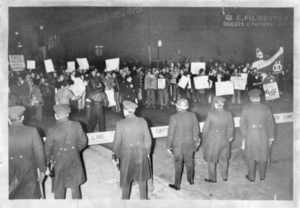
Today, learn more about this significant event in LGBT history through the Project website:
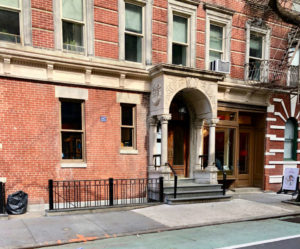
The Snake Pit
Site of a March 8, 1970, NYPD raid which received much media coverage and is credited with greatly inspiring more LGBT people to become politically active, including many who had not following Stonewall, such as future film historian Vito Russo and future GAA president Morty Manford. It also demonstrated the strength of the recently formed gay rights movement organizations. EXPLORE THIS SITE >>>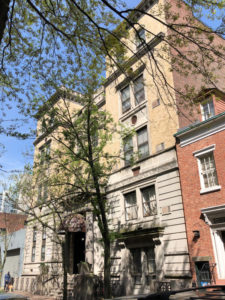
6th Police Precinct Station House
Following the March 1970 police raid on the Snake Pit, 167 gay men were arrested and taken by NYPD to the station house at 135 Charles Street. Apparently fearing deportation, Argentinian immigrant Diego Vinales, one of the men arrested, jumped from a third-story window and was critically injured. He was taken to St. Vincent’s Hospital and a crowd of about 500 people confronted the police at the station. EXPLORE THIS SITE >>>
Below, a Gay Activists Alliance flyer for the Snake Pit raid, written by Marty Robinson. Angry protesters, numbering around 500, marched from Christopher Park to the police station where they were met by barricades and armed police during a half-hour confrontation.
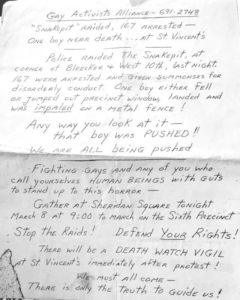
Civil Rights Leader Bayard Rustin Pardoned
February 6, 2020
,FOR IMMEDIATE RELEASE
PRESS CONTACT
Ken Lustbader, NYC LGBT Historic Sites Project
(917) 848-1776 / [email protected]
BAYARD RUSTIN, CIVIL RIGHTS ACTIVIST,
PARDONED POSTHUMOUSLY BY
CALIFORNIA GOV. NEWSOM
Rustin — one of the most important yet little-known figures
of the civil rights movement — lived in NYC and his former residence
is an NYC LGBT historic site
NEW YORK, NY — Thursday, February 6, 2020 —California Gov. Gavin Newsom has posthumously pardoned openly gay civil rights activist Bayard Rustin. The action comes more than 60 years after Rustin was arrested in Pasadena, CA, for having consensual sex with another man, charged with vagrancy and ordered to register as a sex offender. It was this arrest that publicly outed Rustin as a gay man.
“Prior to his arrest in California, Bayard Rustin was a prominent civil rights activist, conscientious objector and pacifist,” said Amanda Davis, manager for the NYC LGBT Historic Sites Project, a NYC-based initiative dedicated to researching and celebrating place-based LGBT history throughout the five boroughs. “Rustin returned to New York and the news of his homosexuality was eventually used against him; he was forced to resign from leadership posts.”
Raised as a Quaker, Bayard Rustin was an openly gay African-American activist and devout pacifist who, over the course of five decades, had an immeasurable impact on the civil rights movement in the United States and social justice efforts abroad. One of his many roles was as chief advisor to Dr. Martin Luther King, Jr. in the 1950s and early 1960s, to whom he taught Mahatma Gandhi’s philosophy of non-violent resistance.
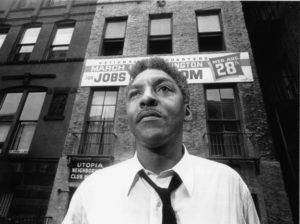
Bayard Rustin in front of the headquarters of the 1963 March on Washington for Jobs and Freedom, 170 West 130th Street, Harlem, August 7, 1963. Photo by Orlando Fernandez/World Telegram & Sun.
Bayard Rustin was, as Gov. Newsom noted, ‘a visionary champion for peace, equality and economic justice,'” said Ken Lustbader, co-director of the NYC LGBT Historic Sites Project. “He was open and proud of his homosexuality and it was because of this that Rustin was often sidelined — even as he organized some of the most important efforts to advocate for racial justice, chief among these the 1963 March on Washington for Jobs and Freedom. We are pleased to see this wiped from Rustin’s history and encourage all New Yorkers to celebrate his work and visit the sites right here in New York City that connect us with his legacy.”
Gov. Newsom issued a broader clemency initiative to clear others who were victims of the state’s criminalization of the LGBT community.
In New York City, three extant sites that connect to the legacy of Bayard Rustin have been mapped by the NYC LGBT Historic Sites Project:
 NAT’L HQ FOR THE 1963 MARCH ON WASHINGTON FOR JOBS AND FREEDOM
NAT’L HQ FOR THE 1963 MARCH ON WASHINGTON FOR JOBS AND FREEDOM
170 West 130th Street
Although denied the title of “director” of the March due to his homosexuality, Bayard Rustin is now acknowledged as the lead architect of this history-making event. (more)

BAYARD RUSTIN RESIDENCE
Building 7, Penn South
Bayard Rustin lived in an apartment in this Chelsea building complex from 1962 to 1987 (his death). While here, he served as the lead organizer of the 1963 March on Washington for Jobs and Freedom and took part in numerous social justice campaigns around the world. (more)

BAYARD RUSTIN RESIDENCE
217 Mott Street, Rear
While living here (from 1947 to 1954), Bayard Rustin took part in the influential “Journey of Reconciliation” in 1947 and contributed to other civil rights causes and anti-war campaigns, alongside his Mott Street neighbor and fellow activist Igal Roodenko. (more)
About the NYC LGBT Historic Sites Project
The NYC LGBT Historic Sites Project is a nonprofit cultural initiative and educational resource that is making an invisible history visible by documenting historic and cultural sites associated with the LGBT community throughout New York City.
###
#LGBTHistoryMonth
20191007
LGBT History is Hidden in Plain Sight
… and we’ll show you! October is LGBT History Month and the Project is connecting the present and the past on our social media channels. Follow all month long to learn about the LGBT history embedded within the sites you walk by every day!
IG: @nyclgbtsites TW: @nyclgbtsites FB: /nyclgbtsites


Victor’s Cafe, then and now, featuring mural by gay Cuban artist
Arturo Martin Garcia,on the Upper West Side
Origins in Education
LGBT History Month was established in 1994 when a Missouri high school teacher, Rodney Wilson, recognized an omission of LGBT history from the cirriculum, and a general lack of awareness from young people. Together, Wilson, his fellow teachers and community leaders selected October as a month for which to shine a light on the contributions of LGBT indivdiuals to American history. (more)
Why October? Across the country, public schools are in session and can engage with content developed specifically on this subject. And, importantly, existing traditions such as National Coming Out Day (October 11th) occur this month.
The NYC LGBT Historic Sites Project is an educational resource for everyone, whether you’re walking the City and curious about its LGBT history, or an educator seeking to bring this important American history into the classroom. We’re proud of our work with the NYC Department of Education and will continue to uncover the invisible history of LGBT people in New York, and to share it with the largest number of people possible!
Let’s Go Exploring
All you need is Instagram to join us on mini-tours of LGBT history this month. Follow us at @nyclgbtsites and watch for capsule collections of LGBT historic sites inspired by our tours on the VAMONDE app.


James Baldwin NYC residence added to National Register of Historic Places
September 12, 2019
We are extremely pleased to share the news that the James Baldwin Residence, located at 137 West 71st Street, has been listed on the National Register of Historic Places.
This announcement comes after two years of focused effort on behalf of the Project, and soon after the author and civil rights activist’s Upper West Side rowhouse’s designation as an NYC Individual Landmark during #Stonewall50 and WorldPride.
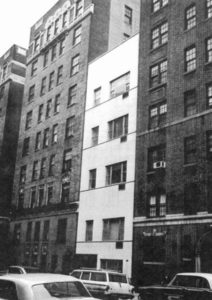
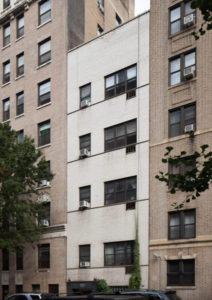
Photos: (l) Tax photo of 137 West 71st Street, 1964 (a year before James Baldwin bought the building). Courtesy of the NYC Municipal Archives; (r) 137 West 71st Street, on the Upper West Side, 2016. Credit: Christopher D. Brazee/NYC LGBT Historic Sites Project.
The nomination was initiated and researched by the Project as part of a National Park Service grant to increase LGBT diversity on the National Register, facilitated by the New York State Historic Preservation Office (SHPO). The NYS SHPO confirmed on September 3, 2019, the official listing of the New York City site.
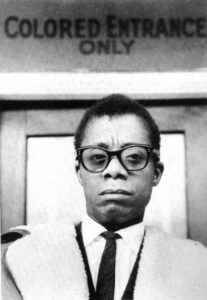 As a gay black author, civil rights activist, and social commentator, Baldwin transformed, and continues to transform, discussions about race and sexuality in America and abroad.
As a gay black author, civil rights activist, and social commentator, Baldwin transformed, and continues to transform, discussions about race and sexuality in America and abroad.
Seeing James Baldwin’s NYC residence listed on the National Register of Historic Places is the realization of our mission, in part, to increase LGBT representation on this important official inventory of sites and to formally recognize the U.S. home most closely associated with Baldwin, a pivotal voice of 20th century America. We are delighted that our years of research into Baldwin’s connections to New York City and this home, specifically, have resulted in the site’s recognition at both the local, state, and national levels.
The National Register listing follows the site’s listing on the State Register of Historic Places, which occurred on July 15, 2019.
Literary icon and civil rights activist James Baldwin used this Upper West Side remodeled rowhouse as his New York City residence from 1965 until his death in 1987. Although he generally eschewed labels and did not self-identify as gay, he was open about the fact that he had relationships with men and spoke openly about various LGBT issues. He first wrote about his own sexuality in his 1985 essay, “Freaks and the American Ideal of Manhood.” Baldwin wrote several novels that featured gay and bisexual characters, such as his groundbreaking second novel, Giovanni’s Room (1956), and spoke openly about same-sex relationships and LGBT issues.
“The NYC LGBT Historic Sites Project has created a national model for recognizing the underrepresented history of LGBT New Yorkers. We are truly grateful for this collaboration and congratulate the LGBT Historic Sites Project on this latest achievement of officially designating the residence of gay author, activist and New Yorker, James Baldwin, to the National Register, said Erik Kulleseid, Commissioner of the NYS Office of Parks Recreation and Historic Preservation (SHPO).
The National Register of Historic Places is the federal government’s honorary list of sites deemed significant to American history and includes over 93,500 sites across the country, yet the LGBT community remains vastly underrepresented with less than twenty sites. To date, the Project has been involved with seven of the 22 LGBT-related listings on the National Register. Additionally, the Project authored the Historic Context Statement for LGBT History in New York City (2018) to help guide the New York State Historic Preservation Office and New York City Landmarks Preservation Commission in evaluating LGBT historic sites. The Project is also surveying sites that appear eligible for official listing and is nominating sites to the National Register of Historic Places; see what has been listed so far in New York City.
The James Baldwin Residence was designated a NYC Individual Landmark by the NYC Landmarks Preservation Commission on June 18, 2019, at the onset of WorldPride and a month of celebration in lead-up to the 50th anniversary of the game-changing Stonewall uprising. The Project’s research served as a key foundation for the Commission’s evaluation of this and five other LGBT historic sites; its advocacy brought a wave of public support to these sites in advance of their important public hearing before the Commission. The Project remains grateful to all those who supported these designations, in particular New York City Council Speaker Corey Johnson, a champion for preservation LGBT history in New York City. Revisit the Project’s testimony on the James Baldwin Residence (here).
“Broadway Theater District” published, added to VAMONDE app
September 10, 2019
40+ theaters celebrated in new LGBT theme:
“Broadway Theater District”
published to website and added to the VAMONDE app
Our Curated Themes make it easy for you to explore NYC’s LGBT historic sites by subjects of interest. The latest addition—to both our website and our channel on the VAMONDE app (download from Apple or Google Play!)—is a 40+ site collection of theaters on and around Broadway, from 41st to 54th Streets.
Whether a star with name in flashing lights on a marquee or a member of the chorus line, so many LGBT individuals have contributed their talents to our theater history. We celebrate them with our new Broadway Theater District theme.
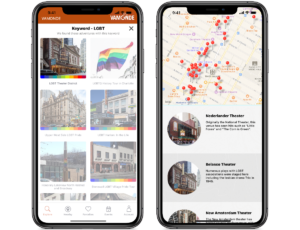 Search “LGBT” on the VAMONDE app and you’ll find our adventure,
Search “LGBT” on the VAMONDE app and you’ll find our adventure,
featuring the Broadway Theater District sites, right away.
New York City has long been considered the leading American center for arts and culture, and the arts—especially theater—constitute one of New York’s primary economic forces. Throughout the 20th century, the LGBT community has had a significant and disproportionate impact on the Broadway stage, even as the New York Legislature-enacted Wales Padlock Law (1927-1967) made it illegal for theaters to show plays that featured gay and lesbian characters (though some productions managed to get around this restriction).
This curated collection spotlights the Broadway Theater District and its associations with major LGBT performers and creators. Research for this new theme has been supported, in part, by a grant from the Manhattan Community Awards Program, facilitated by the Office of Borough President Gale Brewer.
DOWNLOAD the VAMONDE app from Apple or Google Play!
Our History Has Been Erased
June 18, 2019
Unprotected, an LGBT Historic Site is Lost to the Wrecking Ball
 LGBT history was made at Alternate U.
LGBT history was made at Alternate U.
On July 24, 1969, the first meeting of the Gay Liberation Front (GLF) took place at Alternate U., a free counterculture and leftist organizing center located at 69 West 14th Street and Sixth Avenue. The significance of this site cannot be overstated: GLF was the first LGBT activist organization formed in response to the Stonewall rebellion, in June 1969. As the riots catalyzed the newly formed gay liberation movement, GLF was at the fore. In this building, protests were organized, meetings were held, community was nurtured, and history was made. This building was our tangible connection to our past. Now, it is gone.
Alternate U. has been demolished.
News of the site’s risk of demolition was first reported in early 2018. Alongside our colleagues at the Historic Districts Council, we called for the protection of this and other culturally-significant historic sites.
While millions of LGBTQ individuals and allies celebrated the legacy of #Stonewall50 during Pride Month 2019, Alternate U. was demolished. Brick by brick, this historic site was reduced to rubble. The demolition of Alternate U. is the second LGBT historic site lost since the Project was founded; the first was the Paradise Garage, demolished 2018.

Our work is critical. Photographs and documents are now all that’s left of this LGBT historic site. Our work makes an impact. Scholarly research and advocacy undertaken by our team lead to the June 2019 designation of six LGBT historic sites as NYC Individual Landmarks, on the basis of their cultural significance. We need your support to continue onward.
Here’s How You Can Help
[1] Nominate an LGBT historic site! Especially in the outer boroughs, help us record places of significance to our community.
[2] Donate to the project! With just one full-time project manager and three all-volunteer co-directors, we’ve made incredible achievements in a short time: mapping more than 200 LGBT historic sites, successfully nominating 5 sites to the New York State and National Register of Historic Places, securing Landmarks Preservation Commission designation of 6 LGBT historic sites, reaching over 600 middle and high school students through in-classroom presentations in NYC public schools, and more.
6 LGBT Historic Sites are Now Designated NYC Landmarks!
September 19, 2019
The NYC Landmarks Preservation Commission voted and the decision was *unanimous*: all six LGBT historic sites presented at public hearing earlier this month are now Individual Landmarks!
On Staten Island, the Audre Lorde Residence. On the Upper West Side, the James Baldwin Residence. In SoHo and Greenwich Village, the Gay Activists Alliance Firehouse, the Women’s Liberation Center, the Caffe Cino and the LGBT Community Center. All are now landmarks, designated for their cultural significance to LGBT, New York City and American history.
Original research by the Project team was key to contextualizing place-based LGBT history for the Commission, and was integral in their evaluations. Following meetings with the Commission’s chair, Sarah Carroll, and her staff to discuss how important LGBT-related sites are to the history of New York, these six sites were selected. Their designation places them alongside the city’s architectural landmarks, adding to the diversity of places officially recognized by the city.
Thanks are in Order
To the Landmarks Preservation Commission, for recognizing the place-based history of the LGBT community. And to our colleague organizations around the City for your important support!
To the elected representatives who championed these designations, especially City Council Speaker Corey Johnson. Thank you also to State Senator Brad Hoylman; Assemblymembers Deborah Glick, Richard Gottfried, Linda Rosenthal and Daniel O’Donnell; Councilmembers Margaret Chin, Debi Rose, Daniel Dromm, Carlos Menchaca, Ritchie Torres and Jimmy Van Bramer and former City Council LGBT Caucus member Rosie Mendez; and Borough Presidents Gale Brewer and Ruben Diaz, Jr.
To YOU, and the hundreds of supporters that submitted a letter in support of these designations. Together, we showed that LGBT historic sites provide a tangible, visceral connection to what is often an unknown and invisible past. Thank you!
What’s Next?
Landmark designations must be reviewed by the City Council, starting with the sub-committee on Landmarks, followed by the Land Use committee and, finally, by the full 51-member City Council. We’ll continue to testify in support at every opportunity, alongside our preservation and LGBT colleagues. Please continue to follow our social media channels for updates along the way!
IG: @nyclgbtsites FB: /nyclgbtsites TW: @nyclgbsites
Read Our Testimony

(1) Audre Lorde Residence,
207 St. Paul’s Avenue,
Staten Island (testimony)
(2) Caffe Cino,
31 Cornelia Street,
Manhattan (testimony)
(3) LGBT Community Center,
208 West 13th Street,
Manhattan (testimony)
(4) James Baldwin Residence,
137 West 71st Street,
Manhattan (testimony)
(5) Women’s Liberation Center,
243 West 20th Street,
Manhattan (testimony)
(6) Gay Activists Alliance Firehouse,
99 Wooster Street,
Manhattan (testimony)
Protect LGBT History with Just One Click
May 24, 2019
On Tuesday, June 4th, the NYC Landmarks Preservation Commission will hold a public hearing to consider the designation of six New York City sites for landmark designation based on their cultural significance to LGBT and American history. We need you to write letters, attend the hearing and spread the word! We must show the Commission and the City that the LGBT community and its allies support the designation of these important place-based historic sites!
Click here to send a simple, one-click letter showing your support!
HOW YOU CAN HELP
 Attend the hearing on Tuesday, June 4th at 1 Centre Street, 9th Floor. All members of the public are permitted to speak for up to 3 minutes on each item up for consideration. What should you say? (1) State your name; (2) State your professional qualifications, if relevant; (3) Express your strong support for the designation of the six LGBT historic sites and briefly explain why.
Attend the hearing on Tuesday, June 4th at 1 Centre Street, 9th Floor. All members of the public are permitted to speak for up to 3 minutes on each item up for consideration. What should you say? (1) State your name; (2) State your professional qualifications, if relevant; (3) Express your strong support for the designation of the six LGBT historic sites and briefly explain why.
Available to attend but not comfortable testifying? Our collective physical presence speaks volumes. Please come.
 Write a letter in support! If unable to attend, please submit your support in writing to the public record. As with testimony at the public hearing (see above), your letter should state why you believe the six sites (see our summaries for each below) are culturally significant and deserving of designation. Email your letter to LPC Chair, Sarah Carroll, at [email protected].
Write a letter in support! If unable to attend, please submit your support in writing to the public record. As with testimony at the public hearing (see above), your letter should state why you believe the six sites (see our summaries for each below) are culturally significant and deserving of designation. Email your letter to LPC Chair, Sarah Carroll, at [email protected].
Not sure what to say? Pressed for time? We’ve made it easy with this one-click letter, below!
 Instagram! Twitter! Facebook! Tell your friends and contacts to join you in supporting the designation of these six LGBT historic sites!
Instagram! Twitter! Facebook! Tell your friends and contacts to join you in supporting the designation of these six LGBT historic sites!
Sample text:
I support designation of LGBT historic sites as cultural landmarks. Sign on before the June 4th hearing of the NYC Landmarks Preservation Commission: http://www.

- Audre Lorde Residence,
207 St. Paul’s Avenue, Staten Island (more) - Caffe Cino,
31 Cornelia Street, Manhattan (more) - LGBT Community Center,
208 West 13th Street, Manhattan (more) - James Baldwin Residence,
137 West 71st Street, Manhattan (more) - Women’s Liberation Center,
243 West 20th Street (more) - Gay Activists Alliance Firehouse,
99 Wooster Street, Manhattan (more)
Myth Busters
May 20, 2019
Facts matter. As we approach the 50th anniversary of the Stonewall uprising, the Project is highlighting how place-based research and documentation are important tools used to clarify some of the myths and misinformation surrounding the iconic Stonewall Inn and the history-making riots of June 1969.
Here’s what you’ve heard: The original establishment opened in 1930 as Bonnie’s Stone Wall, a tearoom at 51-53 Christopher Street. Bonnie was said to be the lesbian owner; Stone Wall supposedly selected in homage to The Stone Wall, the pseudonymous lesbian memoir by Mary Casals published in 1930. It was considered a notorious tearoom and raided by the police.
Fantastic and colorful … but false (with the exception of the address)
The romantic story of the lesbian owner Bonnie and her desire to reference Mary Casals’ book is in print and often repeated, but newspaper accounts, conveyance documents, phone listings and other contemporary — albeit unromantic — sources used by historic preservationists reveal that to simply not be the case. The factual account of the Stonewall Inn’s name has no direct LGBT associations, but is steeped in Village history.
“Bonnie” was, in reality, Vincent Bonavia, a local Village businessman with a nickname presumably derived from his last name. He originally opened the Stonewall Inn at 91 Seventh Avenue South in 1930. In 1934, a year after Prohibition ended, “Bonnie” relocated what was not a tearoom but a former speakeasy, to 51-53 Christopher Street, opening it as a restaurant and bar, where a large vertical signed was installed calling attention to “Bonnie’s Stonewall Inn.”

Here, from the Landmarks Preservation Commission’s 2015 designation report for the Stonewall Inn as an Individual Landmark: “After a vacancy of about a year, late in 1934, the Stonewall Inn moved to the commercial space at 51-53 Christopher Street. The Stonewall Inn, sometimes known as Bonnie’s Stonewall Inn, presumably in honor of its proprietor Vincent Bonavia, opened for business at 91 Seventh Avenue South in 1930. Purportedly a tearoom, a restaurant serving light meals and non-alcoholic beverages, it was in fact a speakeasy, which was raided by prohibition agents in December 1930, along with several other Village nightspots.”
Spread the facts; correct the record. And take the time to read our Stonewall 50 factsheet, created for instances precisely like this. “Stonewall: The Basics,” co-produced by leaders in LGBTQ history documentation, interpretation, and outreach, is an easy-to-understand guide to the people, circumstances, and legacy of the Stonewall uprising. With millions of people expected to visit the city for Pride month, this is our community’s opportunity to get the facts right about this history-making event, and our history at-large.
Download “Stonewall: The Basics” here.
Image: Matchbook cover advertising Bonnie’s Stonewall Inn, c. 1940s. Courtesy of Tom Bernardin.
Six LGBT Historic Sites Calendared by Landmarks Preservation Commission
May 14, 2019
FOR IMMEDIATE RELEASE
PRESS CONTACT
Ken Lustbader, NYC LGBT Historic Sites Project
(917) 848-1776 / [email protected]
SIX LGBT HISTORIC SITES CALENDARED BY LANDMARKS PRESERVATION COMMISSION
THE FIRST STEP FOR CONSIDERATION AS DESIGNATED NEW YORK CITY LANDMARKS
NYC LGBT Historic Sites Project’s Research and Advocacy
Establishes Case for Significance
Landmarking Actions Come as
50th Anniversary of Stonewall Approaches, in June
NEW YORK, NY — Monday, May 14, 2019 — The NYC Landmarks Preservation Commission has calendared six New York City sites for possible landmark designation based on their cultural significance to LGBT and American history. The expert research and ongoing advocacy of the NYC LGBT Historic Sites Project contributed significantly to the selection of these important place-based historic sites.
The vote to calendar comes as New York City is poised to recognize the 50th Anniversary of the Stonewall uprising, and play host to NYC Pride and WorldPride, when millions of LGBT individuals and allies will arrive in New York to honor and celebrate LGBT history.
“We are thrilled that our research was a catalyst for the Landmarks Preservation Commission’s review of cultural landmarks, which highlight the rich LGBT history of New York City,” said Andrew Dolkart, co-director of the NYC LGBT Historic Sites Project. “We met with the Commission’s chair, Sarah Carroll, and her staff to discuss how important LGBT-related sites are to the history of New York and are pleased that these cultural sites may soon be designated alongside the city’s architectural landmarks, adding to the diversity of places officially recognized by the city.”
The six LGBT historic sites calendared by the NYC Landmarks Preservation Commission for public hearing on Tuesday, June 4th, are:
- Audre Lorde Residence, on Staten Island
- Caffe Cino, in Greenwich Village
- The LGBT Community Center, in Greenwich Village
- James Baldwin Residence, on the Upper West Side
- Women’s Liberation Center, in Chelsea
- Gay Activists Alliance Firehouse, in SoHo
Learn more about each site below.
“We’re immensely proud of our work and pleased that it could be used by the Commission to establish the significance of these six sites, which we hope represent the beginning of continued recognition of LGBT sites as significant to New York City and American history,” said Ken Lustbader, co-director of the NYC LGBT Historic Sites Project. “Literally hundreds of other NYC sites, from the Walt Whitman Residence in Brooklyn to Julius’ Bar in Greenwich Village to the Billy Strayhorn & Aaron Bridgers Residence in Harlem, merit further consideration for formal designation as cultural landmarks.”
“We are thankful to the NYC Landmarks Preservation Commission and its chair, Sarah Carroll, for understanding the importance of these cultural landmarks and taking this important first step for possible landmark designation,” said Amanda Davis, manager of the NYC LGBT Historic Sites Project. “And we are especially grateful for City Council Speaker Corey Johnson, who has championed our Project and our advocacy to ensure LGBT historic sites are among those recognized by the City as significant to our history.” The Speaker recently hinted at forthcoming landmarking news regarding LGBT sites when accepting the “Friends in High Places” award from city-wide advocate Historic Districts Council.
For more than two decades, co-directors of the NYC LGBT Historic Sites Project have researched and advocated for the recognition of sites which speak to the impact of LGBT history and people on New York City and American culture. In 2015, the website www.nyclgbtsites.org was launched to share this pioneering place-based study of NYC’s LGBT history with the public. Last year, the Project completed the Historic Context Statement for LGBT History in New York City, a first-of-its-kind framework for evaluating sites for LGBT significance, that was shared with the NYC Landmarks Preservation Commission. To date, nearly 200 historic sites have been researched, photographed and published online to promote the cultural contributions of LGBT people and to draw focus to sites which, often, are unrecognized. The NYC LGBT Historic Sites Project’s work is making an invisible history visible.
Learn more about the six LGBT historic sites that have been calendared for landmark designation by the NYC Landmarks Preservation Commission by visiting their full entries at www.nyclgbtsites.org:
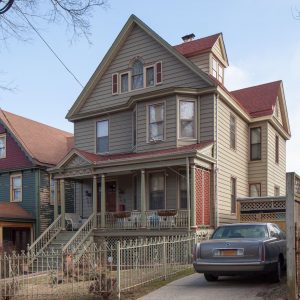 Audre Lorde Residence
Audre Lorde Residence
207 St. Paul’s Avenue, Staten Island
Acclaimed black lesbian feminist, writer, and activist Audre Lorde lived here with her partner and two children from 1972 to 1987. While here, Lorde was a prolific writer who authored numerous influential books, co-founded Kitchen Table: Women of Color Press, and spoke at the 1979 National March on Washington for Lesbian and Gay Rights. (more)
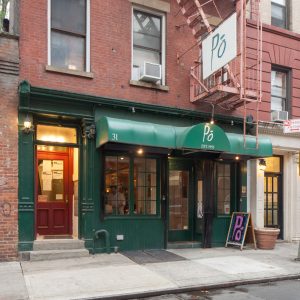 Caffe Cino
Caffe Cino
31 Cornelia Street, Manhattan
The Caffe Cino is widely recognized as the birthplace of Off-Off-Broadway theater and was located on the ground floor of this building from 1958 to 1968. It is also highly significant as a pioneer in the development of gay theater, at a time when it was still illegal to depict homosexuality on stage. The NYC LGBT Historic Sites Project successfully nominated the Cino to the State and National Registers of HIstoric Places in 2017. (more)
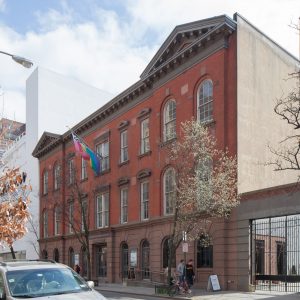 LGBT Community Center
LGBT Community Center
208 West 13th Street, Manhattan
Since 1983, the Lesbian, Gay, Bisexual, and Transgender (LGBT) Community Center has served as a vital support system for hundreds of thousands of people and has witnessed the founding of ACT UP, GLAAD, Las Buenas Amigas, Queer Nation, and the Lesbian Avengers, and for many years was the meeting location for the Metropolitan Community Church of New York and SAGE. The Gender Identity Project, which was established here in 1989, is the longest running service provider for the transgender and gender non-conforming (TGNC) community in the state. (more)
 James Baldwin Residence
James Baldwin Residence
137 West 71st Street, Manhattan
Literary icon and civil rights activist James Baldwin used this Upper West Side remodeled rowhouse as his New York City residence from 1965 until his death in 1987. Although he generally eschewed labels and did not self-identify as gay, Baldwin wrote several novels that featured gay and bisexual characters and spoke openly about same-sex relationships and LGBT issues. Just this month, the NYC LGBT Historic Sites Project completed its nomination of the Baldwin Residence to the New York State Register of Historic Places. It is currently being reviewed by the State and, if accepted, will then be reviewed by the Department of the Interior for the National Register of Historic Places. (more)
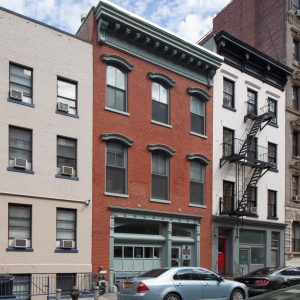 Women’s Liberation Center
Women’s Liberation Center
243 West 20th Street
In the early 1970s, the Women’s Liberation Center was founded as an important meeting space for many women’s groups, including those that specifically served the lesbian community. The Center operated here from 1972 to 1987. (more)
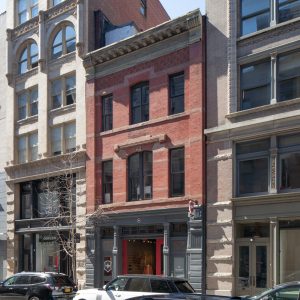 Gay Activists Alliance Firehouse
Gay Activists Alliance Firehouse
99 Wooster Street, Manhattan
The Gay Activists Alliance (GAA) formed in December 1969 and became the most influential American gay liberation political activist organization in the early 1970s. From 1971 to 1974, GAA used this firehouse in SoHo as its headquarters, which served as New York’s most important LGBT political and cultural community center during these years. (more)
About the NYC LGBT Historic Sites Project
The NYC LGBT Historic Sites Project is a nonprofit cultural initiative and educational resource that is making an invisible history visible by documenting historic and cultural sites associated with the LGBT community throughout New York City.
###
Leaders in LGBTQ History Documentation, Interpretation, and Outreach Create Stonewall 50 Factsheet
April 15, 2019
FOR IMMEDIATE RELEASE
PRESS CONTACT
Cristiana Peña / Nick Porter
Peña + Porter
(516) 320-0038 / (909) 262-5920
[email protected] / [email protected]
STONEWALL: RIOT OR UPRISING?
BIRTH OF THE LGBTQ MOVEMENT OR TURNING POINT?
New Factsheet Answers All the Basic Questions about Stonewall as Pride Month and World Pride in NYC Draw Nearer
NEW YORK, NY — Monday, April 15, 2019 — The NYC LGBT Historic Sites Project, Making Gay History, the New York Public Library, GLSEN, the National Parks Conservation Association, and the Stonewall 50 Consortium announce the release of “Stonewall: The Basics,” a new FAQ-style primer on the historic Stonewall uprising.
“Stonewall: The Basics,” which is co-produced by leaders in LGBTQ history documentation, interpretation, and outreach is an easy-to-understand guide to the people, circumstances, and legacy of the Stonewall uprising, which began in New York City’s Greenwich Village on June 28, 1969.
“This year marks the 50th anniversary of the Stonewall uprising, and New York City is set to host World Pride this June,” said Ken Lustbader, co-director of the NYC LGBT Historic Sites Project. “With millions of people expected to visit the city for Pride month, we’re seizing on this opportunity to provide the most accurate documentation about this history-making event.”
“Stonewall: The Basics” provides answers to fundamental questions such as:
- What is the Stonewall Inn?
- Why was the Stonewall Inn raided by police?
- Who started the confrontation?
- Was Stonewall the start of the LGBTQ civil rights movement?
- Stonewall is a national monument. What does that mean?
“Stonewall, and the people and events surrounding the uprising, have evolved beyond history and fact to legend and myth,” said Eric Marcus, founder and host of the Making Gay History podcast. “‘Stonewall: The Basics’ clarifies the historical record. As interest in people, places, and moments significant to LGBTQ history grows in the run-up to June, this new factsheet will provide a starting point for anyone interested in knowing about Stonewall and the events that helped shape the trajectory of a movement that has spread around the world.”
“Stonewall: The Basics” is available online now as a download-ready PDF through the Stonewall 50 Consortium’s website.
Click here to preview “Stonewall: The Basics.”
“While Stonewall, as a place, looms large in our collective national imaginings, ‘Stonewall: The Basics’ is a tremendous reminder that it is people who make history,” said Eliza Byard, executive director of GLSEN. “The homeless LGBTQ teens, trans women of color, lesbians, drag queens, and more who resisted the police at Stonewall are part of a long legacy of community building, protesting, and history-making individuals who have shaped the LGBTQ movement, and who continue to do so to this very day.”
Additionally, the co-creators of “Stonewall: The Basics” encourage visitors to the Stonewall site to use the excellent self-guided walking tour map (linked below) from the National Parks Conservation Association and the NYC LGBT Historic Sites Project. Published in 2017 as the first walking tour map dedicated to telling the history of the 1969 Stonewall uprising and the fight for LGBTQ rights, the tour connects the public with nearly 20 historic sites significant to the LGBTQ community, anchored by the Stonewall National Monument in New York’s Greenwich Village. Collectively these sites contribute to the story of the LGBTQ civil rights struggle and the events and social changes that eventually led to the Stonewall uprising and its impact.
Click here to download the self-guided walking tour map.
The Stonewall Basics fact sheet was made possible through the support of the New York Community Trust. “Americans who felt like outsiders elsewhere are drawn to New York, where our diversity has allowed them to find welcoming communities,” says Kerry McCarthy, The New York Community Trust’s vice president for philanthropic initiatives. “We’re working to bring LGBTQ history out of the closet and into the spotlight, because LGBTQ history is New York City’s history and our nation’s history.”
About the Co-Creators
NYC LGBT Historic Sites Project
The NYC LGBT Historic Sites Project is a nonprofit cultural initiative and educational resource that is making an invisible history visible by documenting historic and cultural sites associated with the LGBTQ community throughout New York City. For more, visit www.nyclgbtsites.org, or follow on Instagram, Facebook, or Twitter.
Making Gay History
Making Gay History is a nonprofit organization dedicated to bringing the largely hidden history of the LGBTQ civil rights movement to life through the voices of the people who lived it—principally through the award-winning Making Gay History podcast and LGBTQ-inclusive educational materials. For more, visit www.makinggayhistory.org, or follow on Instagram, Twitter, or Facebook.
New York Public Library
The New York Public Library is a free provider of education and information for the people of New York and beyond. With 92 locations—including research and branch libraries—throughout the Bronx, Manhattan, and Staten Island, the library offers free materials, computer access, classes, exhibitions, programming, and more to everyone from toddlers to scholars, and has seen record numbers of attendance and circulation in recent years. The New York Public Library serves more than 18 million patrons who come through its doors annually and millions more around the globe who use its resources at www.nypl.org.
GLSEN
GLSEN works to create safe and inclusive schools for all. They envision a world in which every child learns to respect and accept all people, regardless of sexual orientation, gender identity, and/or gender expression. Each year, GLSEN programs and resources reach millions of students and educators in K-12 schools, via action at the national, state, and local level. Over nearly three decades of work, GLSEN has improved conditions for LGBTQ students across the United States and launched an international movement to address LGBTQ issues in education and promote respect for all in schools. Find more information on GLSEN’s policy advocacy, student leadership initiatives, school-based programs, research, and professional development for educators at www.glsen.org.
National Parks Conservation Association
Since 1919, the nonpartisan National Parks Conservation Association (NPCA) has been the leading voice in safeguarding our national parks. NPCA and its more than 1.3 million members and supporters work together to protect and preserve our nation’s natural, historic, and cultural heritage for future generations. NPCA led the campaign for the Stonewall National Monument. For more information, visit www.npca.org.
Stonewall 50 Consortium
The Stonewall 50 Consortium is an organization that brings together scores of nonprofit institutions and organizations committed to producing programming, exhibitions, and educational materials related to the Stonewall uprising and/or the history of the LGBTQ civil rights movement in the context of the 50th anniversary of the Stonewall uprising in June 2019. The mission of the consortium includes helping participating institutions and organizations share ideas and best practices, facilitate potential collaborations, coordinate outreach efforts, and avoid scheduling conflicts and duplication of programming. For more information, visit www.stonewall50consortium.org.
###
NYC LGBT Historic Sites Project Receives a 2019 Excellence in Preservation Award
April 10, 2019
FOR IMMEDIATE RELEASE
PRESS CONTACT Ken Lustbader, NYC LGBT Historic Sites Project p: (917) 848-1776 / e: [email protected] Katy Peace, Preservation League of New York State p: 18) 462-5658 ext. 17 / e: [email protected]
The NYC LGBT Historic Sites Project Receives a 2019 Excellence in Historic Preservation Award
This award from the Preservation League of NYS recognizes the best in the field of historic preservation
New York, NY—Wednesday, April 10, 2019—The NYC LGBT Historic Sites Project has been named one of this year’s Excellence in Historic Preservation award winners by the Preservation League of New York State. Along with seven other honorees, the Project represents a shining example of historic preservation done well. The League’s statewide awards program has been honoring notable achievements in retaining, promoting, and reusing New York State’s irreplaceable architectural heritage since 1984. The Project and its fellow 2019 award recipients will be honored in New York City:
- WHAT: Preservation League of NYS “Excellence in Historic Preservation” awards ceremony
- WHEN: Thursday, May 9, 2019, at 6:00 pm
- WHERE: The historic New York Yacht Club, 37 West 44th Street, New York, NY
- MORE INFO: preservenys.org/2019awards
The NYC LGBT Historic Sites Project (www.nyclgbtsites.org) is a pioneering cultural heritage initiative and educational resource that is comprehensively identifying sites connected to lesbian, gay, bisexual, and transgender history and culture in New York City. Launched in 2015 by preservation professionals, the project makes an invisible history visible by identifying extant historic LGBT locations. The project was catalyzed by funding from the National Park Service Underrepresented Community Grant Program, administered in collaboration with the New York State Historic Preservation Office, to increase diversity on the National Register of Historic Places. Based on its research, the project nominates LGBT sites to the National Register of Historic Places, curates walking tours, presents lectures, engages the community through events, and develops educational opportunities. Its robust social media presence (@nyclgbtsites) disseminates LGBT place-based historical content. In December 2018, the Project received the New York State Historic Preservation Award. “It is wonderful to see what the NYC LGBT Historic Sites Project has been able to do to shine a light on underrepresented communities within the preservation community,” said Preservation League President Jay DiLorenzo. “The model that they are setting is sure to inspire similar groups within New York State and around the country.” “We are pleased to have our work recognized by the League. The “Excellence in Preservation” award helps to validate that LGBT history is American history,” said Amanda Davis, project manager of the NYC LGBT Historic Sites Project. “As we approach the 50th anniversary of the Stonewall uprising this June, it’s important to recognize LGBT place-based history and the influence that the community has had on New York State and American culture.” This organization serves as a local, state, and regional example of expanding National Register designation to include sites relating to underrepresented history. They have truly set a new standard for cultural sites and underrepresented communities. The Preservation League team is so pleased that this effort will receive statewide recognition. The NYC LGBT Historic Sites Project team includes Co-Directors Andrew S. Dolkart, Ken Lustbader, Jay Shockley, and Project Manager Amanda Davis. 2019 Awardees:
- Graycliff Estate – Isabelle Martin House | Derby, Erie County
- Eastman Gardens | Rochester, Monroe County
- NYC LGBT Historic Sites Project | NYC
- Knickerbocker Club: Centennial Renewal | New York City
- RUPCO East End Apartments of Historic Newburgh | Newburgh, Orange County
- Walton & Willett Stone Store – Cahill Landing | Oswego, Oswego County
- The News Apartments | Troy, Rensselaer County
- Neumann House designed by Marcel Breuer | Croton-on-Hudson, Westchester County
As the Preservation League honors excellence in historic preservation, they will also look toward preservation’s future with the inaugural Zabar Family Scholarship. Following the Excellence award presentation, three current students will receive a scholarship of $1,000 each in support of their studies in historic preservation. They are Tabitha O’Connell (SUNY’s University at Buffalo), Camille Sasena (Pratt Institute), and Ryan Zeek (Columbia University). About the NYC LGBT Historic Sites Project The NYC LGBT Historic Sites Project is a cultural initiative and educational resource that is documenting historic sites connected to the LGBT community throughout New York City. Its interactive map features diverse places from the 17th century to the year 2000 that are important to LGBT history and illustrate the community’s influence on American culture. The Project is nominating sites to the National Register of Historic Places and developing educational tours and programs. For more, visit www.nyclgbtsites.org, or follow on Facebook, Twitter and Instagram. About the Preservation League of New York State Since its founding in 1974, the Preservation League has built a reputation for action and effectiveness. Our goal has been to preserve our historic buildings, districts and landscapes and to build a better New York, one community at a time. The Preservation League of New York State invests in people and projects that champion the essential role of preservation in community revitalization, sustainable economic growth and the protection of our historic buildings and landscapes. We lead advocacy, economic development and education programs across the state. ###
Taking LGBT history into the classroom
March 5, 2019
In 2018, the Project was awarded a grant from the City Council to collaborate with the Department of Education in bringing LGBT place-based history to public schools in the city’s five boroughs.
From over 100 educator-submitted requests, our February to May 2019 schedule of sessions was narrowed down to twenty. Our collaboration is the first of its kind: connecting middle and high school students with historic places in their city — and even in their own neighborhoods — that reflect the LGBT community’s contributions to New York and American history and culture.
Working with education consultant Melissa Mott, we’ve so far visited five classrooms, from Sheepshead Bay, Brooklyn, to the south shore of Staten Island and the Fordham section of the Bronx. Grounded in a discussion about the erasure and/or misrepresentation of many diverse histories, the visits provide students of all backgrounds with the opportunity to rethink how they see or don’t see themselves or their classmates reflected in the telling of American history. Our lessons also seek to position LGBT youth in the center of their own stories by reinterpreting historic locations, events, and people to highlight previously invisible LGBT narratives.
The feedback we’ve received so far from NYC educators has been wonderful:
I was delighted to have the NYC LGBT Historic Sites Project visit my classroom. Their presentation was interactive, student-driven, and dynamic; it asked students both to engage with new material related to NYC history, and to re-contextualize some material they were already familiar with. For example, many students have read Langston Hughes in middle or high school, often in the context of reading Lorraine Hansberry’s A Raisin in the Sun; but my twelfth-grade English students were audibly shocked to hear that both were members of the LGBT community, and further, that they could visit the actual sites where both writers lived and worked in New York City. The NYC LGBT Historic Sites Project’s place-based history creates a new sense of relevance for students who may be prone to look at history as already written or as a simple case of “this is what happened”; the NYC LGBT Historic Sites project reframes history as a narrative written by a dominant culture, and as part of an ongoing struggle for recognition and civil rights taking place right now, right here.
– Katherine Montgomery, Phd; English teacher at TAPCO (Bronx)Shown here, Project co-director Ken Lustbader and education consultant Melissa Mott travel to Staten Island to share LGBT history with public school students.




With Bum Bum Bar Closed, Only Three Lesbian Bars Remain in New York City
March 1, 2019
FOR IMMEDIATE RELEASE
PRESS CONTACT
Ken Lustbader, NYC LGBT Historic Sites Project
p: (917) 848-1776 / e: [email protected]
With Bum Bum Bar Closed, Only Three Lesbian Bars Remain in New York City
Just three lesbian bars remain in operation in New York City
New York, NY—Friday, March 1, 2019—After more than two decades, the Bum Bum Bar in Woodside, Queens, has shuttered. Since its opening in the early 1990s, the Bum Bum Bar (pronounced “boom boom”) has been gay-owned and operated, attracting a mixed, but mostly working-class, Latina lesbian crowd.
Along with several other gay and lesbian bars in Queens, Bum Bum provided support for the inaugural Queens Pride Parade in 1993. (more) Bum Bum was known for hosting numerous events that attracted customers from across the five boroughs and was one of only four lesbian bars still in operation in New York City. With Bum Bum’s closing (at the end of 2018), the three remaining NYC lesbian bars are Henrietta Hudson and Cubbyhole, both in Greenwich Village, and Ginger’s Bar in Park Slope, Brooklyn.
While their significance is often underestimated or dismissed by heterosexual society, bars and other establishments play a pivotal role is LGBT culture as centers for LGBT acceptance, community and activism. Through history, these spaces — whether always gay friendly or only during certain times of the day or week — have given LGBT people the freedom to be themselves in a way they often cannot be in their personal or professional lives. “These are the kinds of historic places – dating from the city’s founding in the 17th century to the year 2000 – that we are continuously documenting,” said Amanda Davis, manager of the NYC LGBT Historic Sites Project, “so that our project reflects the diversity of the LGBT community throughout the five boroughs.”
Other significant LGBT bars and nightlife venues in Queens include The Love Boat (more; no longer active) and Friend’s Tavern, known as the oldest active gay bar in Queens. (more) Both have been documented by the Project as historic sites.
Exterior of the now-shuttered Bum Bum Bar, at 63-14 Roosevelt Avenue, Woodside, Queens. Photo by Christopher Brazee for the NYC LGBT Historic Sites Project. About the NYC LGBT Historic Sites Project
The NYC LGBT Historic Sites Project is a cultural initiative and educational resource that is documenting historic sites connected to the LGBT community throughout New York City. Its interactive map features diverse places from the 17th century to the year 2000 that are important to LGBT history and illustrate the community’s influence on American culture. The Project is nominating sites to the National Register of Historic Places and developing educational tours and programs.
###
Visiting the (Unmarked) Grave of Murray Hall
February 4, 2019
Recently, Project co-director Ken Lustbader visited the grave site of Murray Hall, a gender non-conforming Tammany Hall politico whose Greenwich Village residence, at 457 Sixth Avenue, we’ve mapped as an NYC LGBT historic site. Here’s Ken’s story about his visit:
“I live near the apartment where Murray Hall resided in the Village, so his story is present in my daily life. I felt it was important to honor Hall’s memory by visiting his grave and made a visit to Mount Olivet Cemetery in Maspeth, Queens. Hall was buried on January 19th, 1901, three days after he died. I wasn’t sure what I’d find since, most likely, no one had been there in years or even decades. Unfortunately, Hall’s grave is unmarked, which is what you see here. I found the grave site after cemetery staff shared Hall’s ledger card with me (pictured), which included his name and grave location. It’s rather sad that there’s no tombstone to commemorate his life, but the visit was still incredibly meaningful and poignant for me. I may have been the first visitor in a very long time. Now, when I walk by Hall’s residence, I feel a bit more connected to him, knowing that I paid a visit to his grave.”
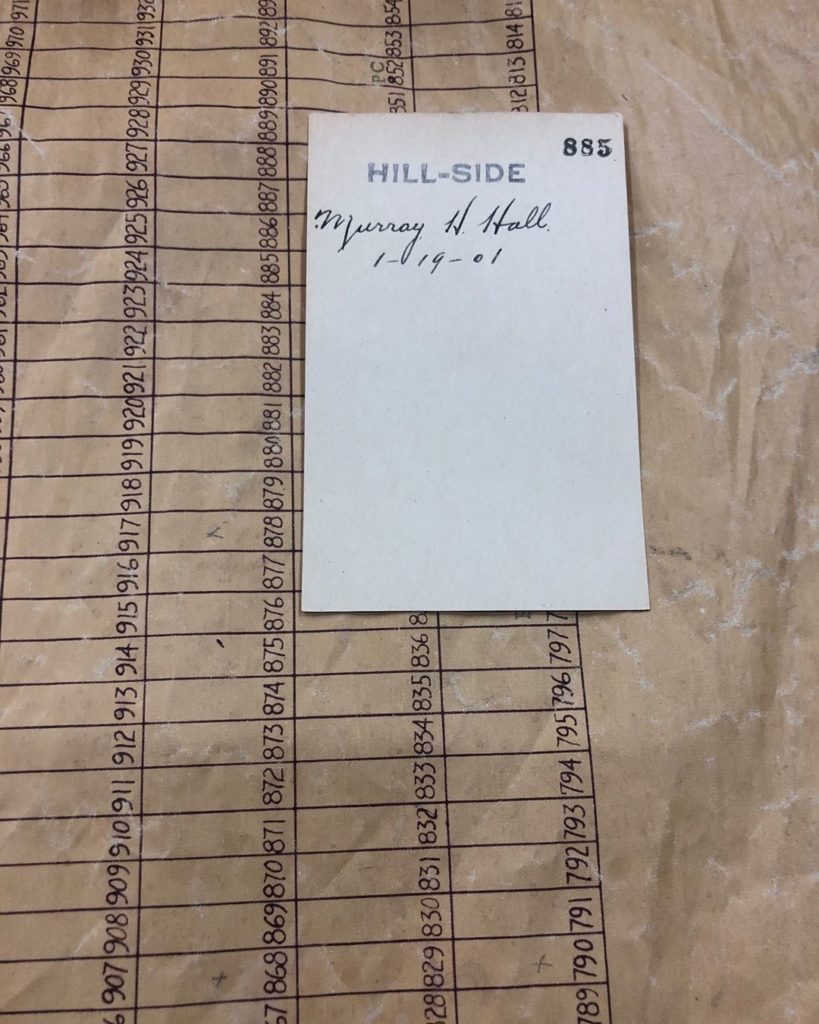
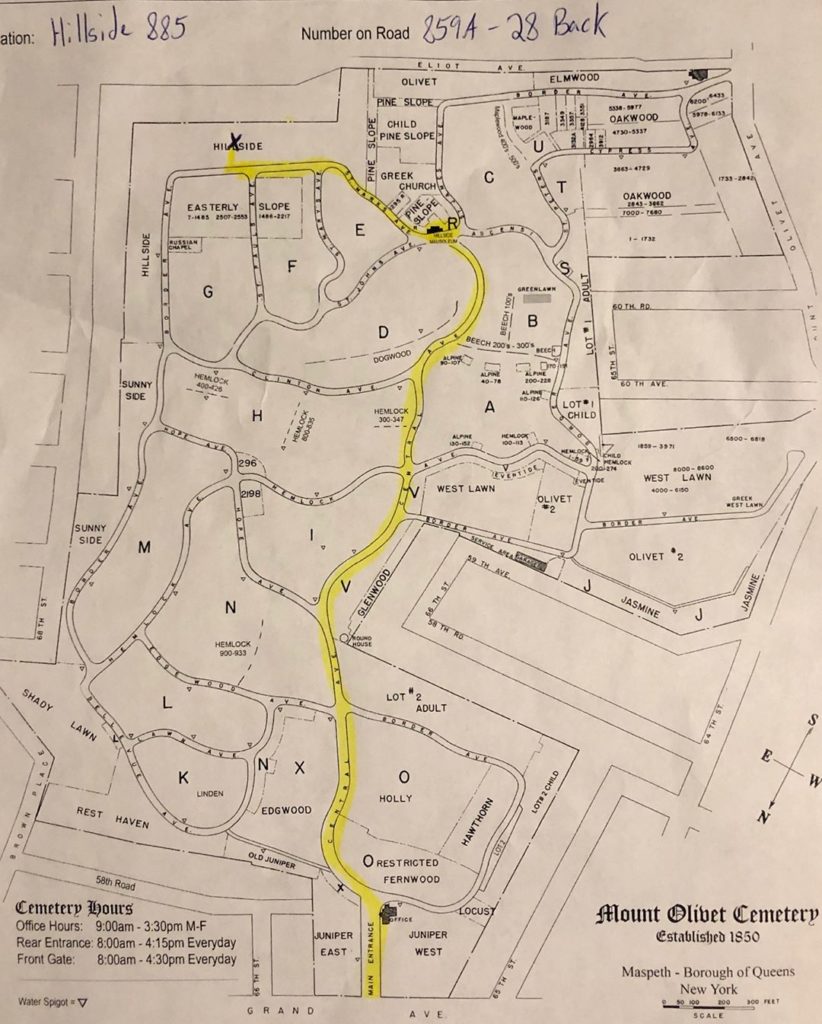
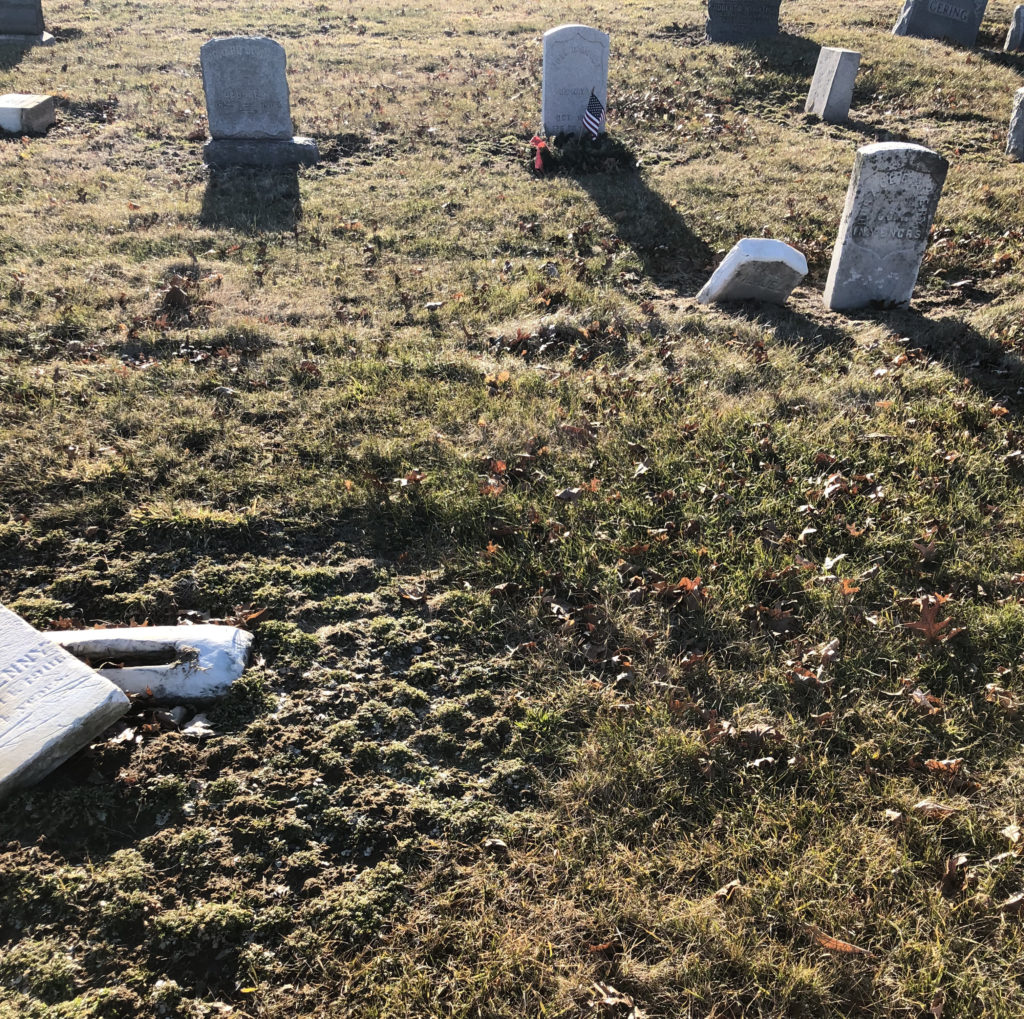
Photos by Ken Lustbader.
Threat to Club Langston Underscores Risks to LGBT-Dedicated Venues in Brooklyn
February 28, 2019
FOR IMMEDIATE RELEASE
PRESS CONTACT
Ken Lustbader, NYC LGBT Historic Sites Project
p: (917) 848-1776 / e: [email protected]
NYC LGBT Historic Sites Project
on the historic, black-owned Starlite Lounge
Call to revisit history upon news of at-risk Club Langston, also in Brooklyn
New York, NY—Thursday, February 28, 2019—It was reported this month that Club Langston, the self-described “last LGBTQIA+ black club in New York City,” is threatened with permanent closure by a combination of rent increases, taxes, business-code violation fees and other expenses.1
The NYC LGBT Historic Sites Project, the only scholarly initiative and educational resource dedicated to recording the place-based history of the LGBT movement in New York City, recalls Club Langston’s predecessor, the Starlite Lounge, which closed nearly ten years ago. Celebrated as the “oldest black-owned non-discriminating bar in New York,” Brooklyn’s Starlite Lounge closed in 2010 and is documented by the Project as an LGBT historic site (more below).
“While their significance is often underestimated or dismissed by heterosexual society,” said Ken Lustbader, co-director of the NYC LGBT Historic Sites Project, “bars and other establishments play a pivotal role is LGBT culture and have throughout the 20th century as centers for LGBT acceptance, community and activism.” Through history, these spaces — whether always gay friendly or only during certain times of the day or week — have given LGBT people the freedom to be themselves in a way they often cannot be in their personal or professional lives.
Club Langston (formally called the Moore Bar and Lounge) is affectionately nicknamed by its patrons after Langston Hughes, the celebrated poet and a leading figure of the Harlem Renaissance. Though private about his personal life, Hughes is generally believed to have been gay and included homosexual subtext in his writing. His former residence at 20 East 127th Street is included on the Project website as an LGBT historic site and was designated an Individual Landmark by the NYC Landmarks Preservation Commission in 1981. The residence was also listed on the New York State and National Registers of Historic Places in 1982.
About the Starlite Lounge (closed 2010)Formerly located in the building at the corner of Bergen Street and Nostrand Avenue in Crown Heights, the Starlite Lounge was established by openly gay African-American entrepreneur Harold “Mackie” Harris as an LGBT-inclusive bar in 1962. Starlite was possibly the first black-owned gay bar in Brooklyn, catering to LGBT people of color at a time when the Mafia operated most LGBT bars in New York. Harris lived in the neighborhood and created what became a legendary safe-haven in central Brooklyn that catered to a diverse clientele, LGBT and straight, depending on the hour of the day and day of the week.
Between 1992 and 2004, the bar was owned by William “Butch” King, who was the resident DJ and helped establish Starlite as a destination for house music and dancing. By the end of its 50-plus-year run, the self-described “oldest black-owned non-discriminating bar in New York” catered to LGBT people of color and a broader clientele throughout the week and especially at Friday night drag shows and Saturday night house music events. It was considered one of Brooklyn’s oldest gay bars when it was forced to close on July 31, 2010 after being evicted due to the sale of the building.
Photo: Starlite Lounge, c. 1980s. Courtesy of the NYC Municipal Archives.
1 As reported by NBC in “Business owner fights to save ‘last LGBTQIA+ black club in NYC'” (more)
About the NYC LGBT Historic Sites Project
The NYC LGBT Historic Sites Project is a cultural initiative and educational resource that is documenting historic sites connected to the LGBT community throughout New York City. Its interactive map features diverse places from the 17th century to the year 2000 that are important to LGBT history and illustrate the community’s influence on American culture. The Project is nominating sites to the National Register of Historic Places and developing educational tours and programs.
###
153 and Counting … Looking Back on 2018
December 20, 2018
We just published our 153rd LGBT historic site!
We’re immensely proud of this work, to document NYC’s sites of significance to the LGBT movement, and equally grateful to those whose support has made the NYC LGBT Historic Sites Project possible. Together, we’ve put LGBT history on the map.
Celebrate with us by donating $153 to the NYC LGBT Historic Sites Project (or any amount — truly, every dollar counts!).
DONATE
Just how far have we come since the Project launched in 2015?
 153 published sites and multiple successful State and National Register listing nominations later, it’s evident: New York City and State are home to a rich LGBT history that merits acknowledgement, documentation and, in some cases, designation. Also in 2018 …
153 published sites and multiple successful State and National Register listing nominations later, it’s evident: New York City and State are home to a rich LGBT history that merits acknowledgement, documentation and, in some cases, designation. Also in 2018 …
- Walking tours (12!), lectures and presentations (7!) and events (5!)
- Release of our “Historic Context Statement for LGBT History in New York City,” published in partnership with the New York State Historic Preservation Office, as a framework for researching and evaluating sites of potential LGBT significance in New York City (more)
All of this work is undertaken by our team of just one full-time staff person and three all-volunteer co-directors. This year has been non-stop; we have no plans to slow down in 2019.
Please donate to the NYC LGBT Historic Sites Project to ensure that the invisible history of LGBT New Yorkers and Americans is documented, honored and passed on to new generations.
DONATE
In the spirit of this holiday season, donations of $250 and above will receive, as our thank-you, a limited-edition photo of the historic Mattachine Society “Sip-In” at Julius’ Bar, signed by two participants: Dick Leitsch (1935-2018) and Randy Wicker.
Taken by Village Voice photographer Fred W. McDarrah on April 21, 1966, the image was printed in 2018 from the original negative and stamped with the official authorization from the McDarrah estate.
Sincerely,
Ken, Jay, Andrew and Amanda
NYC LGBT Historic Sites Project Team
P.S. Curious to know more about that 153rd site? Here you go!
Multimedia
[vimeo id=”75230326″ width=”600″ height=”320″ autoplay=”no” api_params=”” class=””][/vimeo]
Hosted by Vimeo
[soundcloud url=”http://api.soundcloud.com/tracks/110813479″ layout=”classic” comments=”no” show_related=”no” show_user=”no” auto_play=”no” color=”#f95506″ width=”100%” height=”200px” class=”” id=””]
Hosted by Soundcloud
We’re New York State Award Winners!
December 6, 2018
The NYC LGBT Historic Sites Project team has been honored with a 2018 New York State Historic Preservation Award!
Last week, the team traveled to the New York State Museum in Albany to accept the award, given annually by the New York State Office of Parks, Recreation and Historic Preservation to projects which exemplify “excellence in the preservation and revitalization of New York’s historic and cultural resources.”
The NYC LGBT Historic Sites Project was recognized as “an outstanding and groundbreaking documentation project that records the often untold and remarkable histories of Lesbian, Gay, Bisexual and Transgender New Yorkers.” The award acknowledges our website of over 150 LGBT historic sites (and counting!) across the city’s five boroughs, completion of the Historic Context Statement for LGBT History in New York City, five nominations to the National Register of Historic Places (with two more in the pipeline), and an ongoing intensive-level survey.
This work has been partially funded by the National Park Service’s Underrepresented Communities Grants program, which is administered by the New York State Historic Preservation Office. Special thanks to Kath LaFrank, National Register Coordinator, and Kathy Howe, Survey and Evaluation Unit Coordinator, at the state office for their guidance.
We’re looking forward to increasing representation and awareness of the city’s LGBT historic sites in 2019 as we gear up for World Pride and the 50th anniversary of the Stonewall Uprising in June!
Multimedia
Hosted by Vimeo
Hosted by Soundcloud
WATCH: SmartTalk at “Summit for New York City”
November 6, 2018
On October 9, 2018, Project co-director Ken Lustbader spoke at the annual Summit for New York City, hosted by the Municipal Art Society. This “SmartTalk” was a brief look at the organization’s mission, a visual tour of sites which demonstrate the incredible legacy of LGBT people in New York City … and a call to follow the Project (and share our work) on social media!
Instagram: @nyclgbtsites
Facebook: /nyclgbtsites
Twitter: @nyclgbtsites
Groundbreaking Study to Identify and Evaluate Historic LGBT Sites in NYC
20181105
FOR IMMEDIATE RELEASE
PRESS CONTACT
Ken Lustbader, NYC LGBT Historic Sites Project
p: (917) 848-1776 / e: [email protected]
NYC LGBT Historic Sites Project Announces Completion of Groundbreaking Study to Identify and Evaluate Historic LGBT Sites in NYC
New York State Leads the Nation in Designating Sites Significant to LGBT History
New York, NY—November 5, 2018—A new, groundbreaking study has been published as a framework for researching and evaluating sites of potential LGBT significance in New York City, the NYC LGBT Historic Sites Project announced today, following an October-long celebration of national LGBT History Month.
Completed in partnership with the New York State Historic Preservation Office, the “Historic Context Study for LGBT History in New York City” will continue the momentum of New York leading the nation in listing sites associated with LGBT History on the State and National Registers of Historic Places. The context statement provides an overall history of the city’s LGBT past by themes, from the 17th century up to the year 2000. It is a framework for the public, advocates, and cultural heritage professionals to identify and evaluate potential historic resources with specific examples and a step-by-step evaluative tool.
“We are honored to have been recognized by New York State as leaders in the documentation and interpretation of LGBT place-based history. The ‘Historic Context Study for LGBT History in New York City’ will be an invaluable tool for others statewide who share our commitment to preserving LGBT heritage sites,” said Jay Shockley, lead author and co-director of the NYC LGBT Historic Sites Project. “Informed by decades of work in the five boroughs, the NYC LGBT Historic Sites Project team conceptualized and developed a partial narrative — both thematic and chronological — of New York City’s LGBT community spanning centuries. Our work continues, with research that seeks to expand this narrative to further include underrepresented communities within the larger LGBT community throughout New York City.”
Rose Harvey, Commissioner of the Office of Parks, Recreation and Historic Preservation: “This study provides the roadmap for designating future LGBT sites in New York City and will serve as an inspiration to other communities in the state and across the nation that are seeking to unveil their often-unrecognized LGBT history.”
The “Historic Context Statement for LGBT History in New York City,” coordinated by the NYS Division for Historic Preservation, was funded through an Underrepresented Communities Grant awarded to the Office of Parks, Recreation and Historic Preservation by the National Park Service. In addition to the study, the grant funding facilitated the NYC LGBT Historic Sites Project team to research and write new State and National Register listings, including:
- Earl Hall at Columbia University, in recognition of the site as a venue for meetings and dances of the Student Homophile League, the first gay student organization in the country (more)
- Caffe Cino, for its role in the development of Off-Off-Broadway and gay theater and support of gay playwrights at a time when depicting homosexuality on stage was illegal (more)
- Julius’ Bar, the site of the 1966 “Sip In,” protesting discriminatory policies against homosexuals in public spaces (more)
- Alice Austen House, an update to the site’s existing listing to now include recognition of Austen’s pioneering work as a female photographer and her 53-year same-sex relationship with Gertrude Tate (more)
To explore further information and an interactive map of the sites documented in the study, visit www.nyclgbtsites.org.
Other State and National Registers-listed properties in New York State that explore LGBT history include Bayard Rustin Residence at Penn South, the home of one of the most important yet little-known figures of the civil rights movement (more); Fire Island’s Cherry Grove Community House and Theater and the Carrington House (both on Long Island); and two communities in Buffalo: the Fargo Estates and Allentown Historic Districts.
The State and National Registers of Historic Places are the official lists of buildings, structures, districts, landscapes, objects and sites significant in the history, architecture, archeology and culture of New York State and the nation. State and National Registers listing can assist property owners in revitalizing buildings, making them eligible for various public preservation programs and services, such as matching state grants and state and federal historic rehabilitation tax credits.
About the NYC LGBT Historic Sites Project
The NYC LGBT Historic Sites Project is the first cultural heritage initiative and educational resource to document historic sites connected to the LGBT community in New York City. The initiative was founded in 2014 by preservation professionals and is focused on the recognition and preservation of extant sites relating to the broad cultural impact of LGBT people on New York City. The project has developed an interactive map featuring diverse places from the 17th century to 2000 that are important to LGBT history and illustrate the community’s influence on New York and American history and culture. We are also nominating LGBT sites to the National Register of Historic Places and developing educational tours and programs.
Website: www.nyclgbtsites.org
Instagram: @nyclgbtsites
Facebook: /nyclgbtsites
Twitter: @nyclgbtsites
###
Are you Exploring LGBT History with Urban Archive Yet?
20180824
Already in-the-know about Urban Archive? If not, it’s a free mobile app that maps thousands of historical images from the city’s many wonderful libraries, museums, historical societies, and preservation organizations — and that includes the NYC LGBT Historic Sites Project! Working with the Urban Archive team, we’ve shared curated walks in celebration of Pride Month and traced LGBT history on one of their engaging Hunts. If you haven’t already downloaded, we highly recommend you give it a try.
Now’s a great time to start using Urban Archive because just this summer, they rolled out version 1.0 of the mobile app. With updates to navigation, content discovery tools and more, connecting with history through Urban Archive is more enjoyable than ever. Here’s the full story via Medium.
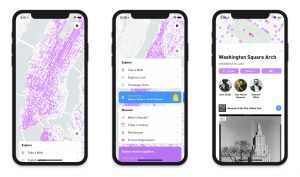
Project Manager Amanda Davis on Bronxnet’s OPEN
August 14, 2018
On Wednesday our very own Amanda Davis joined Daren Jaime on Bronxnet to discuss the Project’s origins and its work documenting LGBT history in all of New York City’s five boroughs, but especially in the Bronx.
Watch for a rundown of some of the Bronx’s most important LGBT sites including Christine Jorgensen’s childhood home, Woodlawn Cemetery and Orchard Beach.
Watch below:
Bronxites and everyone else: Do you have ideas for important Bronx-based LGBT sites to feature on this website? Click here to submit a site!
LGBT history mapped as another Queens site is published
20180814
FOR IMMEDIATE RELEASE
PRESS CONTACT
Ken Lustbader, NYC LGBT Historic Sites Project
p: (917) 848-1776 / e: [email protected]
Guillermo Vasquez Corner is latest Queens LGBT
site featured on dynamic digital map
Corner of 77th Street and Broadway, in Elmhurst, honors Colombian-born
Queens resident who helped co-found annual Queens Pride march
New York, NY—The NYC LGBT Historic Sites Project announces the digital publication of its latest Queens-based site significant to the City’s LGBT history: Guillermo Vasquez Corner, in Elmhurst. This latest historic site brings the total of sites in Queens up to nine, with many more in the queue for further research and publication in late Summer/early Fall.
Guillermo Vasquez was a leading gay rights, AIDS, and Latino community activist in Queens who emigrated from Colombia in 1972. Seventeen years after his 1996 death from AIDS-related complications, the corner of 77th Street and Broadway was renamed “Guillermo Vasquez Corner” and a street sign was unveiled next to the site of the Love Boat, a former gay Latino bar where Vasquez educated the community about HIV/AIDS.
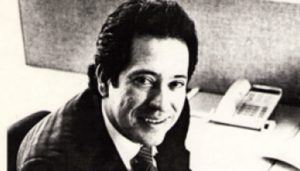
NYC Councilmember Daniel Dromm, Chair of the Council’s LGBT Caucus, recalls of the impact Guillermo Vasquez made on his Queens and Latino communities: “He was a fierce soldier in the battle against HIV/AIDS and a bridge between Latino activists and other movements for social justice.”
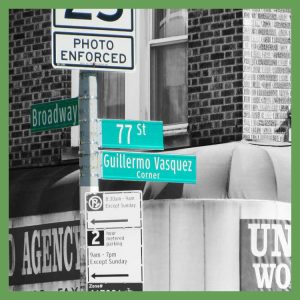
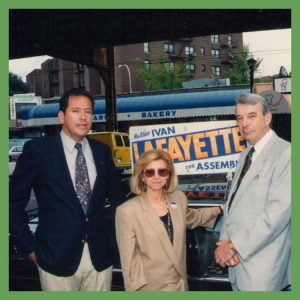
Other significant LGBT sites in Queens already published to the Project’s interactive map include:
- Bum Bum Bar (more)
- West Side Tennis Club (more)
- Frank Kameny Residence (more)
- Kitty Genovese Residence (more)
- Julio Rivera Corner (more)
- New York State Pavilion (more)
- Riis Park Beach (more)
- Manford Family Residence (more)
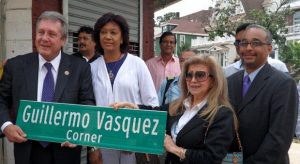 Photos:
Photos:
(1) Guillermo Vasquez.
(2, left) Guillermo Vasquez Corner street sign in front of the building that once housed the Love Boat, a gay Latino bar where Vasquez educated the community about HIV/AIDS, 2018. Photo by Amanda Davis/NYC LGBT Historic Sites Project.
(3, right) Guillermo Vasquez (at left), Nayibe Nunez-Berger and New York State Assembly representative Ivan Lafayette on Roosevelt Avenue in Jackson Heights, c. 1990s. Courtesy of NYC Council Member Daniel Dromm.
(4) NYC Council Member Daniel Dromm and Nayibe Nunez-Berger, president of the Latin American Cultural Center of Queens, hold the Guillermo Vasquez Corner sign at the July 27, 2013 street co-naming ceremony. State Senator José Peralta is at right. Photo by Ana Luisa Castaño, via Queens Latino.
Historical Background
Born near Cali, Colombia, Guillermo Vasquez (1953-1996) immigrated to the United States in 1972 to study international law and political science at Pace and Columbia universities. A long-time resident of Jackson Heights, Queens, Vasquez was a leading advocate for the borough’s Latino community. He was a founding member and president of the Queens Hispanic Coalition, a founding member of the Latin American Cultural Center of Queens, and a member of the Colombian American National Coalition.
Vasquez was also instrumental in pushing for LGBT visibility in Queens and raising awareness—especially among Latinos—about the AIDS epidemic. Vasquez was a member of Queens Gays and Lesbians United (Q-GLU), worked with the New York City Gay and Lesbian Anti-Violence Project (now the Anti-Violence Project), and served on the board of the Empire State Pride Agenda, a statewide organization that advocated for LGBT rights. In 1993, as a member of the Queens Lesbian and Gay Pride Committee, he helped organize the first Queens Pride Parade and served as a translator for Spanish-speaking participants. (more)
As sites connected to LGBT history in NYC are threatened — the former site of the Paradise Garage has been demolished; 69 West 14th Street, site of the founding of the Gay Liberation Front, is actively threatened by the wrecking ball — it is more important than ever to remember the determination of LGBT equal rights pioneers and the physical sites which place key people and events in history.
About the NYC LGBT Historic Sites Project
The NYC LGBT Historic Sites Project is a cultural initiative and educational resource that is documenting historic sites connected to the LGBT community throughout New York City. Its interactive map features diverse places from the 17th century to the year 2000 that are important to LGBT history and illustrate the community’s influence on American culture. The Project is nominating sites to the National Register of Historic Places and developing educational tours and programs.
###
Three Years of Documenting and Celebrating LGBT Historic Sites
20180801
We’re not too shy to ask: will you please make a donation to celebrate the third anniversary of the Project, and our work to document LGBT sites?
In August 2015, the NYC LGBT Historic Sites Project was established with a mission to document and honor LGBT place-based history in NYC. We’ve made incredible achievements in these first three years, and our work continues to be more essential than ever. We must put LGBT history—often invisible to the public at-large—on the map and document our cultural heritage before it’s too late.
We hope that, in celebration of our birthday, you’ll consider a donation. Please give today.
In Memoriam: Dick Leitsch, pioneering LGBT activist
20180622
On Friday, June 22, 2018, Richard “Dick” Leitsch, the pioneering and innovative LGBT activist, passed away. He was 83 years old.

Dick will forever be remembered as the mastermind behind the game-changing “Sip In” at Julius’ Bar, one of the earliest acts of civil disobedience in the LGBT movement. As then-president of the Mattachine Society, Dick created a media moment that changed the course of history, captured in the famous photo by Fred W. McDarrah.
Dick remained committed to the LGBT equal rights movement throughout his life, and we are all indebted to his early leadership and trailblazing actions. His spirit will live on in each of us.
Raise a glass tonight in honor of Dick Leitsch. And next time you’re in Greenwich Village, sip a cocktail in his honor at Julius’ Bar.


Photos: (1) Dick Leitsch, president of Mattachine Society of New York, at its offices, December 30, 1965. Photo by Louis Liotta/New York Post. Source: NYP Holdings, Inc. via Getty Images; (2) After pouring their drinks, a bartender in Julius’s Bar refuses to serve John Timmins, Dick Leitsch, Craig Rodwell (1940 – 1993), and Randy Wicker, members of the Mattachine Society, an early American gay rights group, who were protesting New York liquor laws that prevented serving gay customers, New York, New York, April 21, 1966. (Photo by Fred W. McDarrah/Getty Images); (3) Dick Leitsch at the 52nd anniversary of the “Sip-In” at Julius’ Bar, Apirl 2018.
Today in LGBT History: Bombing at Uncle Charlie’s
20180428
Uncle Charlie’s, which opened in 1980 at 56 Greenwich Avenue and closed in September 1997, was one of the city’s most popular gay video bars and one of the first to appeal to gay men of the MTV generation. The bar, with its large modern interior and television screens, was a stark contrast to the prior generation of gay bars that were perceived as outdated and dark. It attracted a “younger, suit-and-tie crowd” and, over time, gained a reputation as a so-called “S and M” (Stand and Model) bar, due to the fact that numerous patrons stared more at the TV screens than talk with each other. On April 28, 1990, at 12:10 a.m., a homemade pipe bomb exploded, injuring three men who were later treated for minor injuries at nearby St. Vincent’s Hospital. The bomb was made from several M-80 firecrackers that were stuffed into a six-inch length of pipe. It had no timing device and was lighted and placed in a garbage can inside the bar moments before the blast.
On April 28, 1990, at 12:10 a.m., a homemade pipe bomb exploded, injuring three men who were later treated for minor injuries at nearby St. Vincent’s Hospital. The bomb was made from several M-80 firecrackers that were stuffed into a six-inch length of pipe. It had no timing device and was lighted and placed in a garbage can inside the bar moments before the blast. Although the police said the blast did not appear bias-related, Mayor David Dinkins and several gay rights groups characterized it as an anti-gay attack since Uncle Charlie’s was a well-known gay bar. The recently formed Queer Nation and other groups organized a demonstration of almost 1,500 protesters from Uncle Charlie’s to the Sixth Precinct at 233 West 10th Street, carrying a banner that read “Dykes and Fags Bash Back.” The Mayor released a statement calling the bombing the 26th bias incident against the LGBT community that year.
Although the police said the blast did not appear bias-related, Mayor David Dinkins and several gay rights groups characterized it as an anti-gay attack since Uncle Charlie’s was a well-known gay bar. The recently formed Queer Nation and other groups organized a demonstration of almost 1,500 protesters from Uncle Charlie’s to the Sixth Precinct at 233 West 10th Street, carrying a banner that read “Dykes and Fags Bash Back.” The Mayor released a statement calling the bombing the 26th bias incident against the LGBT community that year.
Queer Nation was founded March 1990 at the Lesbian and Gay Community Services Center (now the LGBT Community Center) with the mission of eliminating homophobia and increasing LGBT visibility. Its four founders (Tom Blewitt, Alan Klein, Michelangelo Signorile, and Karl Soehnlein) were members of ACT UP New York. They were outraged by the escalation of violence against LGBT people in the streets of New York, and the continued existence of anti-gay discrimination. The group’s name was an early re-appropriation of the word “queer” as a political identity. Their rallying cry during demonstrations was: “We’re here! We’re Queer! Get used to it!” The group developed chapters in cities nationwide, including Atlanta, Denver, Houston, Portland, and San Francisco.
 In 1995, the blast at Uncle Charlie’s was discovered to have been one of the first terrorist attacks on U.S. soil by a radical Muslim group. The New York Times reported that El Sayyid A. Nosair, one of the leaders on trial for the terrorist conspiracy to blow up New York City landmarks, allegedly planted the bomb at Uncle Charlie’s as a protest against homosexuality on religious grounds. The trial resulted in Nosair being sentenced to life in prison.
In 1995, the blast at Uncle Charlie’s was discovered to have been one of the first terrorist attacks on U.S. soil by a radical Muslim group. The New York Times reported that El Sayyid A. Nosair, one of the leaders on trial for the terrorist conspiracy to blow up New York City landmarks, allegedly planted the bomb at Uncle Charlie’s as a protest against homosexuality on religious grounds. The trial resulted in Nosair being sentenced to life in prison.
Photos, top to bottom:
Uncle Charlie’s bar on Greenwich Avenue, October 1992. Photo by Ken Lustbader.
Interior of Uncle Charlie’s, c. 1990s. Source: Then and Now: Uncle Charlie Remembers Queer Memories of New York Facebook Page.
May 16, 1990 Outweek article by Andrew Miller and Duncan Osborne about the bomb and protests. Photo by Tracy Litts. Sources:
Andrew Miller and Duncan Osborne, “Bombing at Gay Bar Raises Community Ire,” Outweek, May 16, 1990.
David Bahr, “Uncle Charlie’s Closes and With It, Perhaps, an Era,” The New York Times, September 21, 1997.
James C. McKinley Jr., “Bomb Explodes at a Gay Bar, Prompting a Protest,” The New York Times, April 29, 1990.
James C. McKinley Jr., “Many Accused in Terror Plot Bombed Gay Bar, U.S. Says,” The New York Times, January 15, 1995.
“Today In Gay – April 28, 1990: Bomb Explodes At Uncle Charlie’s Downtown NYC Later Found Out To Be Terrorist Attack,” Back2Stonewall, April 28, 2017, https://bit.ly/2Hwijvl.
“Uncle Charlie’s Downtown”, Jeremiah’s Vanishing New York, February 20, 2014, https://bit.ly/2HZqFLC.
PHOTOS: LGBT advocates honor 52nd Anniversary of historic “Sip-In” with trailblazer Dick Leitsch and advocate/influencer Adam Eli
April 26, 2018
PHOTO RELEASE
PRESS CONTACT
Ken Lustbader, NYC LGBT Historic Sites Project
p: (917) 848-1776 / e: [email protected]
** PHOTOS **
Generations come together at LGBT anniversary event
LGBT civil rights trailblazers Randy Wicker, Dick Leitsch — mastermind
of 1966 Mattachine Society “Sip-In” — and new guard activist Adam Eli
share a toast a Julius’ Bar
New York, NY–LGBT advocates and NYC preservationists celebrated history on Saturday, April 21st, at Julius’ Bar in Greenwich Village, the site of the historic 1966 “Sip-In” organized by the Mattachine Society, an early American homophile group.
Trailblazer and mastermind of the “Sip-In” — one of the earliest acts of public resistance, which challenged discrimination against LGBT people in New York City — Dick Leitsch, as well as fellow Mattachine member and protest participant Randy Wicker, were joined by Adam Eli, whose own non-violent activism builds on the legacy of actions like the groundbreaking “Sip-in.”
Speaking to the standing-room-only crowd at Julius’, Adam Eli referenced the historic pendulum of progress in the community: “when the pendulum moves forward, it’s because we pushed it,” resisting periods of oppression and using our might to swing the pendulum back towards a period of increased rights and equality. “Tonight, honor your ancestors, thrive with your contemporaries and fight like hell on Monday,” he declared, in a moment (full speech here) which captured the spirit of inter-generational appreciation between pioneers Leitsch and Wicker and the young Eli, a force behind the activist group Voices4.

State Senator Brad Hoylman presented event organizers NYC LGBT Historic Sites Project and Julius’ Bar with a proclamation declaring April 21, 2018 to be “Julius’ Bar Appreciation Day,” in honor of Julius’ status as the “oldest LGBTQ bar in New York City still in operation” and the Sip-In’s status as “one of the first acts of gay civil rights disobedience in the United States of America.”
NYC Councilmember Daniel Dromm, Chair of the Council’s LGBT Caucus and himself a former teacher, praised the leadership of Dick Leitsch for his 1966 “Sip-In” and also the work of the NYC LGBT Historic Sites Project to document and disseminate LGBT history via its website, www.nyclgbtsites.org. Councilmember Dromm reinforced his support of LGBT history inclusion in public school curriculum.


View more photos of the
“Sip-In” 52nd Anniversary celebration (here).
Photos:
(1) Left to right, Helen Buford, owner of Julius’ Bar; NYC Councilmember Daniel Dromm; Dick Leitsch; Adam Eli, activist and social influencer; Jay Shockley, Project co-director; Randy Wicker; Ken Lustbader (with sign), Project co-director.
(2) Randy Wicker, participant of the 1966 “Sip-In” signs copies of the famous photograph by Fred W. McDarrah, of the Mattachine Society group being denied a drink by the bartender at Julius’.
(3) Dick Leitsch, mastermind of the 1966 Mattachine Society’s “Sip-In” joins with NYC LGBT Historic Sites Project manager Amanda Davis, donning a “Go-Go Mattachine!” button, for a fun photo.
(4) State Senator Brad Hoylman (right, with bowtie) presents a proclamation declaring April 21, 2018, to be “Julius’ Bar Appreciation Day,” in honor of its place in LGBT and American history.
Historical Background
Fifty-two years ago — on April 21st, 1966 — four homosexuals went in search of a drink. They had a purpose: to challenge discrimination against LGBT men and women at bars. At the time, the New York State Liquor Authority (SLA) enforced regulations making it illegal for bars to serve drinks to known or suspected gay men or lesbians, since their presence was considered de facto disorderly. The SLA regulations were one of the primary governmental mechanisms of oppression against the gay community because they precluded the right to free assembly. This was particularly important because bars were one of the few places where gay people could meet each other. Learn more about Julius’ as a site of LGBT history on our website (more).
At Julius’ Bar, they were refused service, the exchange with the bartender captured in a now-famous image by legendary photographer Fred W. McDarrah. Mainstream media took notice and what was called a “Sip-In” helped to change history.
As sites connected to LGBT history in NYC are threatened — the former site of the Paradise Garage has been demolished; 69 West 14th Street, site of the founding of the Gay Liberation Front, is actively threatened by the wrecking ball — it is more important than ever to remember the determination of LGBT equal rights pioneers and the physical sites which place key people and events in history.
About the NYC LGBT Historic Sites Project
The NYC LGBT Historic Sites Project is a cultural initiative and educational resource that is documenting historic sites connected to the LGBT community throughout New York City. Its interactive map features diverse places from the 17th century to the year 2000 that are important to LGBT history and illustrate the community’s influence on American culture. The Project is nominating sites to the National Register of Historic Places and developing educational tours and programs. For more, visit www.nyclgbtsites.org, or follow on Facebook, Twitter and Instagram.
###
DEMOLISHED: Paradise Lost
20180413
Demolition was completed on the former Paradise Garage site this month — the first LGBT historic site loss since the launch of the Project in 2015. At least one other site of LGBT significance is actively threatened by the wrecking ball: 69 West 14th Street, where the Gay Liberation Front held important community activities and political organizing in the immediate aftermath of the 1969 Stonewall uprising.
The demolition of the Paradise Garage underscores the urgency of our work: to document sites that shaped LGBT and American culture before they are lost.
Between 1977 and 1987, the Paradise Garage, at 84 King Street, was one of the most important and influential clubs in New York City with a devoted patronage comprised of sexual and ethnic minorities (primarily African-American gay men).
With resident DJ Larry Levan and other DJs as the center of attention, it influenced dance, music, and culture both nationally and internationally as the birthplace of the modern nightclub.
Sharing LGBT history with the Norwegian Consulate
20180316
The NYC LGBT Historic Sites Project was delighted to meet with members of the Norwegian consulate and the Minister for Children and Equality, Ms. Linda Helleland, on March 17, 2018. The Minister and her delegation were in NYC for the United Nations’ Commission on the Status of Women summit.
Starting with a luncheon at Julius’ Bar, we walked Greenwich Village and shared the important history of sites connected to LGBT and American history. Also attending the afternoon’s activities were SAGE and OutRight. We hope you enjoy this recap in photos, short video clips, and dynamic Instagram Stories, via @norwaynewyork.



ALERT: LGBT historic site at risk of demolition
20180316


FOR IMMEDIATE RELEASE
PRESS CONTACT
Ken Lustbader, NYC LGBT Historic Sites Project
p: (917) 848-1776 / e: [email protected]
Simeon Bankoff, Historic Districts Council
p: (212) 614-9107 / e: [email protected]
Important cultural heritage site central to the early LGBT rights movement at risk of demolition
Preservation groups join together to advocate for the protection
of sites of cultural significance in New York City
New York, NY – A New York City site tied to the local and national history of the LGBT rights movement is at risk of demolition. 69 West 14th Street, at Sixth Avenue, is where the Gay Liberation Front held important community activities and political organizing in the immediate aftermath of the 1969 Stonewall uprising.
“69 West 14th Street’s significance to LGBT history here in New York City and as part of the larger LGBT rights movement cannot be overstated,” said Jay Shockley, co-director of the NYC LGBT Historic Sites Project, a nonprofit launched in 2015 with a mission to research and document sites of LGBT significance throughout NYC’s five boroughs. “This was the location where the Gay Liberation Front, the first post-Stonewall gay rights organization in America, was founded and where it first held meetings.”
News that the commercial occupant of the building had closed its doors first circulated via the blog Jeremiah’s Vanishing New York; subsequently, Our Town reported that the building’s immediate neighbors were also being vacated and demolition is expected sometime this year. Since the NYC LGBT Historic Sites Project launched its critical efforts to document historic sites in 2015, 69 West 14th Street is the first site actively threatened with demolition and underscores the urgency of the organization’s work: to document sites that shaped LGBT and American culture before they are lost.
Cultural heritage protection is also a priority of the Historic Districts Council (HDC). Earlier this month, HDC selected the NYC LGBT Historic Sites Project, along with the New York Preservation Archive Project, as organizations to represent the larger issue of Cultural Landmarks as one of its Six to Celebrate campaigns. “In recent years, the City has protected several landmarks based largely on their cultural importance,” says Simeon Bankoff, Executive Director of the Historic Districts Council, the city-wide advocate for New York City’s historic neighborhoods and sites. “This is a stated objective of the Landmarks Preservation Commision and one we very much support. Through coalitions fostered by the Six to Celebrate program, we hope to broaden and strengthen the public conversation about how to recognize, honor and protect sites of cultural significance.”
View the history of 69 West 14th Street
on the NYC LGBT Historic Sites Project (click for more).
About the NYC LGBT Historic Sites Project
The NYC LGBT Historic Sites Project is a cultural initiative and educational resource that is documenting historic sites connected to the LGBT community throughout New York City. Its interactive map features diverse places from the 17th century to the year 2000 that are important to LGBT history and illustrate the community’s influence on American culture. The Project is nominating sites to the National Register of Historic Places and developing educational tours and programs.
About the Historic Districts Council
Since 1970, The Historic Districts Council (HDC) has been a vital force helping to preserve historic neighborhoods and buildings throughout the five boroughs. HDC’s mission is to ensure the preservation of significant historic neighborhoods, buildings and public spaces in New York City, uphold the integrity of New York City’s Landmarks Law, and further the preservation ethic. We work directly with people who care about our city’s historic neighborhoods and buildings, and represent a constituency of over 500 local community organizations across all five boroughs.
###
Earl Hall at Columbia University Listed on National Register of Historic Places
20180314
FOR IMMEDIATE RELEASE
PRESS CONTACT
Ken Lustbader, NYC LGBT Historic Sites Project
p: (917) 848-1776 / e: [email protected]
Earl Hall at Columbia University
Listed on National Register of Historic Places
Important venue for LGBT gatherings nominated by the NYC LGBT Historic Sites Project for its affiliation with the Student Homophile League, the first gay student organization in the country, founded at Columbia University in 1966.
New York, NY – This week, Earl Hall at Columbia University was listed on the National Register of Historic Places, following its nomination by the NYC LGBT Historic Sites Project and in recognition of Earl Hall as a venue for meetings and dances of the Student Homophile League, the first gay student organization in the country.
In 1966, Columbia University became the first collegiate institution in the United States — and possibly the first in the world — with an LGBT student group. In the fall of that year, sophomore Robert Martin (using the pseudonym Stephen Donaldson) founded the Student Homophile League following a meeting with Columbia University and Barnard College representatives, religious advisers, and two of the most important national leaders for gay and lesbian rights, Frank Kameny and Barbara Gittings. The small student group had the support of the university chaplain and, thus, gained space in Earl Hall, the center of student religious life. The university officially recognized the group in April 1967. In 1970, the Student Homophile League became the more activist Gay People at Columbia (also known as Gay People at Columbia-Barnard), which sponsored a series of popular Friday-night dances in Earl Hall’s auditorium.
Earl Hall was nominated to the State and National Registers of Historic Places by the NYC LGBT Historic Sites Project, a cultural heritage initiative and educational resource dedicated to broadening people’s knowledge of LGBT history. In so doing, the Project is acknowledging sites that are important to LGBT history as well as those that illustrate the community’s influence on American culture at-large. This is the fourth LGBT historic site the Project has successfully nominated to the State and National Registers since 2016.
“We are delighted to see Earl Hall listed on the National Register of Historic Places, following our nomination,” said Andrew Dolkart, Project co-director and lead author of the nomination. “Columbia University’s Earl Hall hosted the first student gay group in America, the Student Homophile League, later Gay People at Columbia, founded in 1966. Earl Hall was also the site of pioneering monthly gay dances that were key social events for younger gay men and lesbians. We are thrilled that the NYC LGBT Historic Sites Project, with the support of Columbia University and the New York State Office of Historic Preservation, has been able to prepare the documentation that resulted in the Federal government’s recognition of Earl Hall’s significance to LGBT history and American history. Too often LGBT history is either hidden by institutions or simply unknown due to a lack of focused efforts at documentation and education. The Project’s work to reverse that trend is immensely important, and the State and National Register listings are validation of LGBT history’s significance to all Americans.”
Earl Hall’s addition makes six buildings on the Columbia campus to be listed on the National Register of Historic Places, and the first for its LGBT significance. The listing concludes a long process of archival research as well as oral history interviews of people who attended the dances and social events, culminating in the Project’s nomination of the Earl Hall site.
Earl Hall is exceptionally significant in the period 1970-1985 for its association with the gay dances held in the ballroom in the period before the AIDS epidemic forever changed social life for gay men. The first gay dance open to the public was held at Earl Hall on June 19, 1970, and the dances soon became a rare publicly accessible event that provided primarily young gay people with a safe social space to gather and socialize. Over the next five years, the importance of the dances increased.
In 1981, the AIDS virus began its destructive path through the gay community. As the epidemic spread and one method of transmission was identified as sexual contact, the year 1985 marked a watershed in the understanding of the severity of the crisis in New York City. The year 1985 also marks the year when AIDS became a national issue. The death of several celebrities from AIDS, notably Rock Hudson and Ricky Wilson, the opening of Larry Kramer’s play, The Normal Heart, and the premier of the television drama An Early Frost, brought the enormity of the crisis to general public awareness. In the same year, the drinking age in New York State was raised to twenty-one, and most bars began requiring identification. This meant that most of the younger gay students were more restricted in where they could dance legally, and the Columbia dances became a more important social venue.
As those who attended the dances can attest, the mixers were welcoming to younger gay men and lesbians, accepting of everyone no matter how they looked or dressed, and were more low key than events at venues such as bars, clubs, and discos. Thus they were an important social space and they played a vital role in bridging the gap between the pioneering early days of gay rights advocacy at Columbia and the often AIDS-related political activism that became evident beginning in the late 1980s.
Visit Earl Hall on the NYC LGBT Historic Sites Project website (click here).
About the NYC LGBT Historic Sites Project
The NYC LGBT Historic Sites Project is a cultural initiative and educational resource that is documenting historic sites connected to the LGBT community throughout New York City. Its interactive map features diverse places from the 17th century to the year 2000 that are important to LGBT history and illustrate the community’s influence on American culture. The Project is nominating sites to the National Register of Historic Places and developing educational tours and programs. For more, visit www.nyclgbtsites.org, or follow on Facebook, Twitter and Instagram.
###
Love for Cultural Landmarks
20180214
Landmarks need love, too! All year long, we celebrate the sites and people who have helped to shape LGBT culture and history, here in New York City and beyond. This month, we showed them extra love by joining in on the fun with the Landmarks need love, too! All year long, we celebrate the sites National Trust for Historic Preservation and their “heart bomb” event!
Here’s a quick primer. Love the concept? There’s still time for you to get crafty and snap a photo or film an Instagram Story of yourself showering love upon some of your favorite landmarks. Use the hashtag #IHeartSavingPlaces!


 Support LGBT historic research and education
Support LGBT historic research and education
Our mission to document and honor LGBT place-based history in NYC continues, and it’s more essential than ever. We must put LGBT history—often invisible to the public at-large—on the map and document our cultural heritage before it’s too late. Give today.
Cultural Heritage Featured as One of “Six to Celebrate”
January 17, 2018
The Historic Districts Council (HDC), New York’s city-wide advocate for historic buildings and neighborhoods, is pleased to announce its “Six to Celebrate,” an annual listing of historic New York City neighborhoods that merit preservation attention.
Six to Celebrate is New York’s only citywide list of preservation priorities. Profiles of each of the 2018 Six to Celebrate neighborhoods, as well as all past neighborhoods, are available by visiting www.6tocelebrate.org.
“Since 2011, Six to Celebrate has helped shape the preservation agenda in New York. It helped create five New York City Historic Districts, three National Register Districts, three National Register Properties, and 33 Individual Landmarks, and leveraged over $115,000 in private and public grants for these community-driven projects,” said Simeon Bankoff, HDC’s Executive Director. “It’s thrilling to help local communities throughout the city achieve real progress and lasting success.”
For 2018’s Six to Celebrate, HDC has selected the larger theme of Cultural Landmarks. The NYC LGBT Historic Sites Project is honored to be chosen, along with the New York Preservation Archive Project, as representative of this important aspect of our city and our society’s history and heritage:
Cultural Landmarks, Citywide
Working in partnership with the New York Preservation Archive Project and the NYC LGBT Historic Sites Project, HDC will undertake a campaign to shine a light on sites of cultural significance throughout the five boroughs. In recent years, the LPC has designated several landmarks based largely on their cultural impact and has expressed that such designations are a priority for the agency. Through the formation of a diverse coalition of stakeholders, HDC hopes to broaden the conversation about preservation tools for culturally significant sites and to create an action plan for their proper stewardship.
To read more about all Six to Celebrate, click here.
Support the Project with a Year-end Donation
December 19, 2017
Our mission to document and honor LGBT place-based history in NYC continues, and it’s more essential than ever. We must put LGBT history—often invisible to the public at-large—on the map and document our cultural heritage before it’s too late.
Can we count on your ongoing help?
We’ve set ambitious goals for 2018, and we need your support to maintain our rigorous research, writing and publication schedule—that’s how we’re able to deliver on our fundamental purpose of public education. And 2018 is a critical year: this is our time to prepare for 2019 and the 50th anniversary of the Stonewall Uprising.
Your donation will be matched!
A generous donor has pledged to match every dollar contributed between now and the end of the year, up to $20,000. Give today, your tax-deductible donation will go twice as far.
There’s important work to be done: research for over 100 new historic site profiles for our website, photograph more buildings, advocate for more LGBT-related sites to receive formal recognition through National Register of Historic Places nominations, and educate the public through engaging programming.
Share your passion for LGBT history with five friends! To show our gratitude, donors contributing $1,000 or more will receive a complimentary private walking tour (up to 6 people) of LGBT historic sites. Share your commitment to the Project with all of your friends, family and colleagues by using the social share buttons below.
It’s up to us, together.
LGBT history is all of our history—it is American history. We hope our angel donor’s special year-end matching gift challenge will inspire you to give generously, knowing your contribution will be doubled. Please consider a charitable gift to the NYC LGBT Historic Sites Project.
Sincerely,
Ken, Jay, Andrew and Amanda
NYC LGBT Historic Sites Project Team
Give with Purpose on #GivingTuesday and Support the Project
20171128
Show your support of history, culture and social justice this season. Give to the NYC LGBT Historic Sites Project this #GivingTuesday. In a season synonymous with shopping ‘til dropping, #GivingTuesday reminds us that the philanthropic spirit lives on and lives strong!
The NYC LGBT Historic Sites Project has an ambitious research and publication goal for 2018, and we’re counting on your support to achieve it. Your donation will help us research and write over 100 new historic site entries for our website, photograph more buildings, and dive into more archival holdings. Atop the list of our most necessary expenses are professional staff with the expertise to identify and research often-invisible LGBT history and technology experts to maintain our sophisticated website with interactive map — this is critical to ensure we’re achieving one of our foundational goals of serving as a tool for education, especially as Stonewall 50 approaches in 2019.
Donate to help power the NYC LGBT Historic Sites Project into another year.What your support can mean for the Project:
$10: No donation is too small – it all adds up! ![]()
$25: Know that your support helped to continue our work. ![]()
$66: Pay homage to the “Sip-In” which took place at Julius’ Bar in 1966. ![]()
$100: Underwrite the acquisition fees of new archival photographs. ![]()
$250: Sponsor updates to our interactive map and social media posts. ![]()
$500: Support architectural photography for new website entries. ![]()
$1,000: Sponsor a week of archival research and writing. ![]()
$2,500: Be an LGBT-preservation patron; support generously! ![]() Please consider a donation to the NYC LGBT Historic Sites Project. Once you’ve donated, encourage friends, family and colleagues to follow your lead using the social share buttons below.
Please consider a donation to the NYC LGBT Historic Sites Project. Once you’ve donated, encourage friends, family and colleagues to follow your lead using the social share buttons below.
Since launching the project in 2015, we’ve made incredible progress … yet we’ve only scratched the surface of the significant font of LGBT history here in NYC. Support us this #GivingTuesday to ensure that the invisible history of LGBT New Yorkers and Americans is documented, honored and passed on to new generations.
Sincerely,
Ken, Jay, Andrew and Amanda
NYC LGBT Historic Sites Project Team
Caffe Cino Listed on National Register of Historic Places
20171116
FOR IMMEDIATE RELEASE
PRESS CONTACT
Ken Lustbader, NYC LGBT Historic Sites Project
p: (917) 848-1776 / e: [email protected]
Caffe Cino Listed on National Register of
Historic Places
Storied theater venue nominated by the NYC LGBT Historic Sites Project for its pioneering role in the development of gay theater and for its importance as a pre-Stonewall meeting space for the LGBT community
New York, NY – This month, the Caffe Cino — long recognized as the birthplace of Off-Off-Broadway theater in New York City — was officially listed on the National Register of Historic Places. The announcement comes nearly 60 years after the theater’s opening in a storefront space at 31 Cornelia Street in Manhattan by Joe Cino, an openly gay man. The venue is significant for its role in the development of gay theater and support of gay playwrights at a time when depicting homosexuality on stage was illegal.
The Caffe Cino was nominated to the State and National Registers of Historic Places by the NYC LGBT Historic Sites Project, a scholarly initiative and educational resource dedicated to broadening people’s knowledge of LGBT history beyond Stonewall and to placing that history in a geographical context. In so doing, the Project is acknowledging sites that are important to LGBT history as well as those that illustrate the community’s influence on America at-large.
“We are delighted to see the Caffe Cino listed on the National Register of Historic Places, following our nomination,” said Amanda Davis, Project manager and lead author of the nomination. “How fitting that today, on what would have been Joe Cino’s 86th birthday, we are able to honor his work and the legacy of the Caffe Cino in this way. LGBT history is American history, and tragically it is too often lost due to a lack of focused efforts of documentation and education. The Project’s work to reverse that trend is immensely important, and the State and National Register listings are validation of LGBT history’s significance to all Americans.”
The office of Governor Andrew Cuomo said in a press release, supporting the nomination of the Caffe Cino to the State and National Registers of Historic Places: “The Empire State proudly celebrates its diverse culture and rich heritage, and with the addition of these significant sites to the Registers of Historic Places, we will continue to honor all of the great things that make New York, New York. Listing these landmarks will honor the contributions made by so many New Yorkers throughout our vast history, and helps advance efforts to preserve and improve these important historic sites for future generations.” Of the Caffe Cino itself, the Governor’s office acknowledged the site as “the first venue of importance to continuously stage Off-Off-Broadway theater and was critical in the development of gay theater and supporting gay playwrights at a time when depicting homosexuality on stage was illegal.”
The listing concludes a long process of archival research as well as oral history interviews, culminating in the Project’s nomination of the Caffe Cino site. Research work was funded, in part, by a grant from the National Park Service Underrepresented Grants Programs, administered through the New York State Office of Parks, Recreation, and Historic Preservation.
Opened in December of 1958, the Caffe Cino was initially intended as a coffeehouse with space for art exhibitions, but the venue soon began allowing patrons to stage poetry readings and short theatrical performances. “The Cino” as it became known was a showcase for original, experimental theater, beginning with the anti-war themed Flyspray in the summer of 1960. It subsequently became New York’s first significant venue to feature work from then-unknown playwrights including Doric Wilson, Robert Heide, Tom Eyen, Sam Shepard, Robert Patrick, Lanford Wilson, H.M. Koutoukas, William M. Hoffman, and many more. Artists who showcased their work there went on to win Pulitzer Prizes, Tony Awards and various other recognitions, and a few became founders of influential theater companies. The most successful production here was George Haimsohn and Robin Miller’s Dames at Sea, which introduced teenager Bernadette Peters in 1966.
The Caffe Cino had a relatively short lifespan. The venue closed in March, 1968 following Joe Cino’s suicide after the death of his partner Jon Torrey. In that short time it evolved from a coffeehouse with art exhibitions into the birthplace of a new theater movement. The cultural scene in New York City was burgeoning and many establishments were beginning to stage plays, but not with any regularity. The Caffe Cino became the first reliable venue to support unknown artists as they honed their craft, allowing them to take risks that would shape the future of American theater.
The Caffe Cino also carries important historical resonance as an incubator of gay theater specifically, and as a support space for gay artists and gay men in general. At a time when depicting homosexuality on stage was a crime, many of the Caffe Cino’s early productions featured gay characters or subject matter. Interest in the arts in New York City’s Greenwich Village was exploding in the early-to-middle 20th Century, but the LGBT community still lacked a physical space in the city in which patrons could gather and see work by and about them. The Caffe Cino was that place, and as such it is a landmark in LGBT culture and history.
Visit the Caffe Cino on the NYC LGBT Historic Sites Project website (click here).
About the NYC LGBT Historic Sites Project
The NYC LGBT Historic Sites Project is a cultural initiative and educational resource that is documenting historic sites connected to the LGBT community throughout New York City. Its interactive map features diverse places from the 17th century to the year 2000 that are important to LGBT history and illustrate the community’s influence on American culture. The Project is nominating sites to the National Register of Historic Places and developing educational tours and programs. For more, visit www.nyclgbtsites.org, or follow on Facebook, Twitter and Instagram.
###
Six New Historic Sites Published
20171031
Capping off October’s LGBT History Month, we’ve added six new sites to our map! This group includes our first Asian-American historic site, another Latino site, and more representation in Queens and Staten Island. There are still lots more diverse sites in our queue that we’re actively researching and photographing so be sure to check back or sign up for our newsletter to stay updated.
The latest additions to our website include:
- Kitty Genovese Residence, Queens: From 1963 to 1964, Kitty Genovese lived here with her girlfriend Mary Ann Zielonko, though they were known to most people as roommates. In March 1964, a sensationalized and largely untrue news article about Genovese’s murder captivated the public and made her a symbol of bystander apathy. (see the full entry)
- “Desi Dhamaka” Protests at Madison Square Park, Manhattan: For several years in the 1990s, the South Asian Lesbian and Gay Association (SALGA) led “Desi Dhamaka” protests in Madison Square Park in response to being banned from participating in the annual India Day Parade. SALGA and its allies also handed out flyers and provided information sessions for the Desi LGBT community in the park. (see the full entry)
- Louis Sullivan & the Bayard-Condict Building, Manhattan: This elegant loft building is the only New York City design of Chicago master architect Louis Sullivan. Evidence suggests the likelihood that Sullivan was a gay man. (see the full entry)
- Jimmy Zappalorti Lane, Staten Island: On January 22, 1990, Vietnam War veteran Jimmy Zappalorti was murdered near his home on the South Shore of Staten Island because he was gay. The highly publicized murder became the borough’s first officially-designated gay hate crime and helped lead to New York State’s first hate crimes bill, which passed in 2000. (see the full entry)
- Empire State Building, Manhattan: After a multi-year campaign led by GLAAD, the Empire State Building commemorated LGBT Pride for the first time in 1990 by lighting its famed tower in lavender, a tradition it continues today with rainbow lighting. In subsequent years it has also been lit in association with World AIDS Day and Spirit Day, an initiative that brings attention to the bullying, and related suicides, of LGBT youth. (see the full entry)
- Asociación de Arte Latinoamericano (ADAL), Manhattan: For nearly 40 years, gay artistic director Max Ferrá led INTAR, a Latino theater company first known as Asociación de Arte Latinoamericano (ADAL) when it was located in this building from 1966 to 1971. Under Ferrá, who was also a co-founder, the company became a major force in developing Hispanic-American theater talent, including original works by several notable LGBT playwrights. (see the full entry)
Caffe Cino Recommended for State and National Registers of Historic Places
20171103
Great news from the Governor’s office! Governor Cuomo announced today that the New York State Board for Historic Preservation has recommended that Caffe Cino, along with 20 other properties, be added to the State and National Registers of Historic Places. From the Governor’s statement:
Governor Andrew M. Cuomo today announced that the New York State Board for Historic Preservation has recommended adding 21 properties, resources and districts to the State and National Registers of Historic Places. The nominations, which reflect the striking diversity of New York’s history, include the Mount Hope Cemetery in the Finger Lakes where both human rights pioneers Frederick Douglass and Susan B. Anthony are buried, four sites significant in African-American history, and an Off-Off-Broadway theater in New York City that is important in LGBT history.
“The Empire State proudly celebrates its diverse culture and rich heritage, and with the addition of these significant sites to the Registers of Historic Places, we will continue to honor all of the great things that make New York, New York,” Governor Cuomo said. “Listing these landmarks will honor the contributions made by so many New Yorkers throughout our vast history, and helps advance efforts to preserve and improve these important historic sites for future generations.”
State and National Registers listing can assist property owners in revitalizing buildings, making them eligible for various public preservation programs and services, such as matching state grants and state and federal historic rehabilitation tax credits. Since the Governor signed legislation to bolster the state’s use of rehabilitation tax credits in 2013, the state and federal program has spurred $3 billion of investment in historic commercial properties.
“State and National Register listing is an important step in appreciating the value of our history,” said Rose Harvey, Commissioner of the Office of Parks, Recreation and Historic Preservation. “Historic preservation is an excellent tool to create jobs, promote tourism, expand housing and encourage private investment, all while preserving natural resources.”
New York City
- Caffe Cino, Manhattan: The 1877 building housed Caffe Cino from December 1958 to March 1968, when it was the first venue of importance to continuously stage Off-Off-Broadway theater and was critical in the development of gay theater and supporting gay playwrights at a time when depicting homosexuality on stage was illegal.
To read the full statement, click here.
Advocate.com publicizes our interactive map
20170504
By: Scott Ragan
We’re thrilled to see Advocate.com — the online presence for The Advocate magazine — share a video about the Project with its online community. Watch below (brief ad may play first).
Click here to view the video on Advocate.com.
Call for Papers: Co-director to guest edit scholarly journal’s LGBTQ heritage edition
20171019
Change Over Time, a semiannual journal from the University of Pennsylvanis focusing on history, theory, and praxis of conservation, has invited Project co-director Ken Lustbader to serve as guest editor for their Spring 2019 issue, focused on LGBTQ heritage.
Description below, or click here for the call as PDF.
CALL FOR PAPERS
The journal Change Over Time: An International Journal of Conservation and the Built Environment, published by the University of Pennsylvania Press, invites submissions for the Spring 2019 issue.
LGBTQ Heritage | Guest Editor: Ken Lustbader
In spite of the immense historic and cultural contributions of LGBTQ Americans, the LGBTQ community at large is among the least represented in our national, state, and local designation programs. To date, only eleven of the more than 92,000 sites on the National Register of Historic Places have been listed for their primary association with LGBTQ history. This underrepresentation has prevented effective advocacy and educational opportunities, leaving potentially significant sites and histories unappreciated, uncelebrated, and potentially endangered.
Over the past five years there has been growing recognition of the importance of LGBTQ place-based history by cultural heritage professionals, historians, and advocates. Place-based heritage provides a unique opportunity to illustrate the richness of LGBTQ history and the community’s contributions to American culture. Examples include historic sites associated with arts and architecture, important social centers such as bars and LGBTQ organization locations, places related to oppression and protest, and residences of notable figures.
This issue, published in commemoration of the 50th anniversary of the Stonewall Uprising, will explore questions related to LGBTQ cultural heritage: What are the challenges in identifying an often invisible and, at times, transient and denied history? How can historians and preservationists ensure for diverse representation of LGBTQ communities? How does one address significance and architectural integrity when recognizing LGBTQ sites that are often architecturally undistinguished and frequently altered?
We welcome contributions from US and international contexts on a range of topics: researching and documenting LGBTQ place-based sites; exploring rural, urban, and suburban LGBTQ narratives; approaches for categorization of resource types and cultural significance; challenges related to official recognition of LGBTQ-related sites; and solutions for interpretation and educational opportunities.
Submissions may include case studies, theoretical explorations, evaluations of current practices, or presentations of arts- or web-based projects related to LGBTQ cultural heritage.
Abstracts of 200-300 words are due 5 January 2018. Authors will be notified of provisional paper acceptance by 19 January 2018. Final manuscript submissions will be due mid May 2018.
Submission
Articles are generally restricted to 7,500 or fewer words (the approximate equivalent to thirty pages of double-spaced, twelve-point type) and may include up to ten images. See Author Guidelines for full details at cotjournal.com, or email Senior Associate Editor, Kecia Fong at [email protected] for further information.
“Why We Are Marching:” Remembering the October 1979 March on Washington
October 14, 2017
This past weekend marked the anniversary of the 1979 National March on Washington for Lesbian and Gay Rights. Revisiting and rereading the information circulated to inform the LGBT community — and the public at large — of the need for this organizing is especially pertinent in our current political climate.
From “Why We Are Marching” flier, circulated in advance of the 1979 March on Washington:
“People throughout the nation are joining together to make the March on Washington for Lesbian and Gay Rights an inspiring and successful event, an event so important that it will propel lesbian and gay liberation forward in a way that hasn’t been done since the Stonewall Riot. The March on Washington will mark an important point in the evolution of lesbian and gay strength: the coming together of people and organizations from all over the country to work for the first national action planned by the lesbian and gay community.
“1979 is the tenth anniversary of the Stonewall Riots, the historic rebellion that helped to launch the current wave of lesbian and gay liberation. What better way for us to commemorate this anniversary than by mobilizing our sisters and brothers, as well as all our supporters, in the first national march for lesbian and gay rights. The march will be a celebration of our community solidarity and a sign of our political strength …
“… We will be in Washginton, building a broad, mass movement to fight for our freedom. Our demonstration will insist on freedom for all gay people and must reflect the anger and pride of our community in the face of government callousness, double-talk, and inaction. We should march on Washington, not plead with the government for token concessions, but to demand and struggle for liberation and an end to persecution.”
Click the flier below to enlarge and read.
VIDEO: “See the places where LGBT history took place”
October 11, 2017
For #LGBTHistoryMonth, an incredible video from EdLab at Teachers College at Columbia University. Featuring LGBT civil rights activist Dick Leitsch at Julius’ bar; Magie Dominic, actress and now archivist for the Caffe Cino, considered the birthplace of Off-Off-Broadway theater (recently listed to the NY State Register of Historic Places); and our incredible co-directors and project manager.
Marsha P. Johnson’s Place(s) in NYC’s LGBT History
October 6, 2017
The Death and Life of Marsha P. Johnson, a new documentary by David France, had its global premiere on Netflix today (tip to NYC locals: the film is also showing at the IFC Center).
We were fortunate to attend an advance screening of this moving film, which enforces the importance of Marsha P. Johnson and fellow activist, Sylvia Rivera, as early and critical advocates for trans rights (thanks to the LGBT Community Center for hosting this special event). A number of New York City locations and historic sites included in the film (rounded up below) stood out to us.
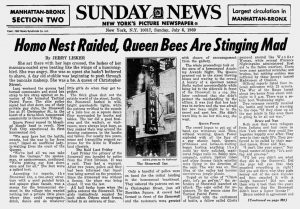
Article about the Stonewall uprising in the Sunday News, July 6, 1969.
The Stonewall Inn & Christopher Park
Marsha P. Johnson, and her involvement during and after the 1969 uprising, has received more and more (much deserved) attention in recent years. While Marsha herself admits that she did not show up at Stonewall until 2 am the first night, and therefore a few hours after the uprising began, she and other trans women of color, including Sylvia Rivera, were key participants who continued to play a crucial role in the fight for LGBT equality and transgender rights in the years to follow.
Visit our Stonewall Inn website entry (scroll down to “Related Media”) and listen as Marsha and Sylvia share their stories. Special thanks to project advisor Eric Marcus and his team at Making Gay History for providing us with these invaluable oral history interviews.
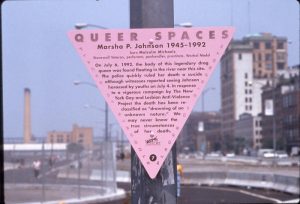
Pink triangle “Queer Spaces” signs were placed by RepoHistory at several NYC locations in the early 1990s to highlight sites of LGBT significance.
Christopher Street Pier
The pier and the Greenwich Village waterfront are shown throughout the Marsha P. Johnson documentary, illustrating their importance to her legacy. While already well-established as a gay cruising area from at least World War I, the pier also became closely associated with Johnson and Sylvia Rivera — both provided much-needed shelter, clothing, and support for homeless queer youth who lived and congregated on the piers.
On July 6, 1992, Johnson’s body was tragically (and mysteriously) found floating in the Hudson River near the piers. Her body was recovered and temporarily placed a half-block south of the Christopher Street Pier until transported to the morgue. The documentary follows Victoria Cruz, a friend of Johnson’s, as she tries to uncover the mystery behind Johnson’s death, which had been labeled a suicide (something those close to her never believed). A pink triangle was installed near the site of where her body was found in the early 1990s, as part of an initiative by RepoHistory to document important queer spaces in NYC. Read more about the waterfront’s LGBT history.
STAR House
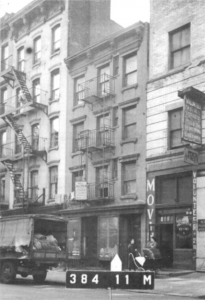 A number of LGBT rights organizations formed in the wake of Stonewall, including the Street Transvestite Action Revolutionaries (STAR), founded by Johnson and Rivera in 1970. Together, they established STAR House in a tenement at 213 East 2nd Street, in the East Village. This was STAR’s first (and it appears only) permanent home, providing refuge for homeless transgender youth from about November 1970 to July 1971. Rivera reflected on the space in a 1979 interview, “We had a STAR House–a place for all of us to sleep. It was only four rooms, and the landlord had turned the electricity off. So we lived there by candlelight, a floating bunch of 15 to 25 queens, cramped in those rooms with all our wardrobe. But it worked.”
A number of LGBT rights organizations formed in the wake of Stonewall, including the Street Transvestite Action Revolutionaries (STAR), founded by Johnson and Rivera in 1970. Together, they established STAR House in a tenement at 213 East 2nd Street, in the East Village. This was STAR’s first (and it appears only) permanent home, providing refuge for homeless transgender youth from about November 1970 to July 1971. Rivera reflected on the space in a 1979 interview, “We had a STAR House–a place for all of us to sleep. It was only four rooms, and the landlord had turned the electricity off. So we lived there by candlelight, a floating bunch of 15 to 25 queens, cramped in those rooms with all our wardrobe. But it worked.”
The building itself was unfortunately demolished by the 1980s and the lot remained vacant until a new residential building was constructed, but we were able to track down the above c. 1939 tax photo from the Municipal Archives.
Photo: The building that would become STAR House, in a c. 1939 tax photo. Courtesy of the Municipal Archives.
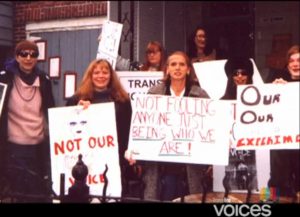
Chelsea Goodwin (left) and Rusty Mae Moore (center, with “Not Fooling Anyone…” sign), along with trans activists in front of Transy House. Source: “Changing House” documentary by Frameline Voices.
Transy House
While the documentary focuses on Marsha P. Johnson, it also highlights the work and influence of other notable transgender activists. Rusty Mae Moore and Chelsea Goodwin, who are interviewed in the film, founded Transy House in Park Slope, Brooklyn, in 1995. A transgender collective that operated until 2008, Transy House provided shelter for up to thirteen people at a time. As with STAR House, after which it was modeled, Transy House was a significant safe haven for trans and gender non-conforming people who had been kicked out of their homes, dropped out of school, or were refused housing at men’s and women’s shelters. It was also the last home of Sylvia Rivera.
Read more about the impact of Transy House and its influence on transgender inclusion in gay and lesbian rights legislation at the city and state levels in the late 1990s.
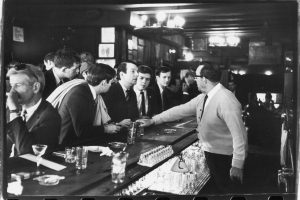
John Timmons, Dick Leitsch, Craig Rodwell, and Randy Wicker of the Mattachine Society during the 1966 “Sip-In” at Julius’ bar. Gift of the Estate of Fred W. McDarrah.
Julius’
While not directly associated with Marsha P. Johnson, the iconic Julius’ bar makes an appearance in the film. The Greenwich Village bar was the site of the 1966 “Sip-In,” at which members of the Mattachine Society, a gay rights organization formed in the 1950s, brought attention to the State Liquor Authority’s discriminatory policy of revoking the licenses of bars that served gay men and lesbians (one of several sites we’ve successfully nominated to the National Register of Historic Places for its significance to LGBT history).
In the documentary, we see Marsha’s friend and roommate Randy Wicker being interviewed at Julius’. Randy was actually one of the four participants of the “Sip-In.” In the famous photo taken by Fred W. McDarrah for the Village Voice (pictured here), you can see Randy in the back looking on as the bartender puts his hand on the glass. Learn more about this important pre-Stonewall event.
Discover more historic sites and learn more about transgender history in NYC with our curated theme.
Have recommendations for other sites significant to the transgender community in NYC? Share your suggestions and help us make trans history visible.
Celebrating LGBT History Month, all October long
20171002
FOR IMMEDIATE RELEASE
PRESS CONTACT
Ken Lustbader, NYC LGBT Historic Sites Project
p: (917) 848-1776 / e: [email protected]
NYC LGBT Historic Sites Project Celebrates
“LGBT History Month”
Throughout October, the Project will highlight important LGBT figures and events with new site listings, a curated tour, social media takeovers, Project launch event, and more
New York, NY – The NYC LGBT Historic Sites Project, a cultural heritage initiative working to document important LGBT sites throughout New York City, has announced its preliminary schedule of programming and events in celebration of October’s LGBT History Month.
LGBT History Month was established in 1994 by educators who recognized a void in the American historical narrative in which LGBT history was neither taught nor celebrated within the traditional educational system — public, parochial or private. Now, each year, shortly after schools return to session, historians, teachers, community groups, activists and the public at-large come together throughout the month to extol the achievements of LGBT individuals no longer with us, as well as those currently fighting and advocating for equal rights and visibility and working to further the movement into the 21st century.
“Our mission is to make the too-often unseen history of NYC’s LGBT community a visible and better-understood thread in our city’s historical fabric,” said Jay Shockley, co-director of the NYC LGBT Historic Sites Project.
Project activities and events during LGBT History Month will include:
- Saturday, October 7th: “Gay Green-Wood” trolley tour at historic Green-Wood Cemetery in Brooklyn. The tour will highlight Green-Wood Cemetery’s connection to LGBT history by showing tour goers the final resting places of important LGBT figures who made a lasting impact on American culture in the 19th and 20th centuries. Some notable “permanent residents” include conductor and composer Leonard Bernstein; “It’s Raining Men” co-author Paul Jabara; Emma Stebbins, sculptor of Central Park’s Bethesda Fountain (already featured on the Project website); activists Drs. Emery Hetrick and Damien Martin; Broadway lyricist Fred Ebb, and more. Green-Wood’s Manager of Preservation and Restoration, Neela Wickremesinghe, will share how these sites are preserved, and tour goers will have the opportunity to mark each grave with a rainbow flag. (more)
- Wednesday, October 11th: National Trust for Historic Preservation and the Project collaborate on a social media “takeover” of the Trust’s Instagram channel (@savingplaces). October 11th is significant both for National Coming Out Day and as the anniversary of the death of American gay rights activist Franklin “Frank” Kameny, whose childhood residence in Queens was among the first sites researched. Throughout the day, the Project will take to the Trust’s Instagram page to share sites and historic photos that speak to the importance of these and LGBT history more broadly.
- Thursday, October 19th to Tuesday, October 24th: The Project will celebrate the 29th annual NewFest (beginning October 19th) and LGBT cinema in general with a series of high-impact image mosaics. Follow on Instagram (@nyclgbtsites) as mosaics highlight films that feature storylines and characters important to LGBT cinema history, or that capture — whether as main set locations or as part of the backdrop of New York City — places with history that looms large in the LGBT community.
- Monday, October 30th: Project launch event at the Church of the Holy Apostles in Chelsea. The Project will celebrate its progress documenting LGBT history and geography in NYC, as well as look forward to what’s in store for the immediate future. The invitation-only event will feature remarks by George Chauncey, historian and author of Gay New York; Matthew Riemer, co-creator of the influential @lgbt_history Instagram account; and other special guests. The Church of the Holy Apostles is a venue of particular significance as it is one of the most important meeting places in New York City for LGBT organizations, dating back to the early post-Stonewall gay rights movement in the early 1970s. Members of the press may contact staff to request media pass.
- New historic sites published to the Project website. Stay tuned for the final week of October when the Project will be debuting newly-researched historically significant locations on its website, www.nyclgbtsites.org. Residences, gathering spaces and institutions coming to the Project’s interactive map include: the Kitty Genovese Residence in Kew Gardens, Queens; the Empire State Building, highlighting the years-long activism of GLAAD to light the famed skyscraper for NYC Pride in 1990; the Jimmy Zappalorti Memorial Tree on Staten Island; Escuelita, a former transgender Latina bar in Midtown Manhattan; the Bayard-Condict Building in NoHo, designed by master architect Louis Sullivan; and the 1990s Desi Dhamaka protests in Madison Square Park.
“We hope that our website inspires the LGBT community and youth, as well as the population more generally, who are too often not taught this particular history,” said Ken Lustbader, Project co-director. “Now more than ever it is imperative to raise public awareness about the community’s contributions to American history as well as the struggles it has faced in achieving acceptance and equality under the law. Our project encourages everyone to take a second look at the physical places we pass every day and to appreciate a history that, until our initiative, has remained largely invisible.”
LGBT History Month activities come on the heels of two recent NYC LGBT Historic Sites Project announcements and successes:
- Caffe Cino listed on the New York State Register of Historic Places: Nearly 60 years after the Caffe Cino opened at 31 Cornelia Street in Greenwich Village, we’re thrilled that our nomination of the famed Off-Off-Broadway cafe theater was listed on the New York State Register of Historic Places on September 14, 2017. The NYC LGBT Historic Sites Project’s nomination now goes to Washington, D.C. where it will be considered for listing on the National Register of Historic Places. (more)
- Debut of the Stonewall National Monument historical walking tour map: Stonewall National Monument — recognized as a national heritage site in 2016 — is the subject of a new historical walking tour, enabling tourists and native New Yorkers alike to engage with the LGBT history of Stonewall and the surrounding Greenwich Village neighborhood in a meaningful way. On September 29, 2017, the Project joins with the National Parks Conservation Association and the National Park Service for a press conference to celebrate this new national resource. (more)
About the NYC LGBT Historic Sites Project
The NYC LGBT Historic Sites Project is a nonprofit cultural initiative and educational resource undertaken in August 2015 that endeavors to catalog important yet often invisible LGBT history in New York City. A first-of-its-kind undertaking, The Project relies on expertise gained from over 25 years of advocacy and research by founders Andrew Dolkart, Ken Lustbader and Jay Shockley. The team includes project manager Amanda Davis who continues that work today by cataloging and archiving historic sites and personalities that are vital to LGBT heritage in New York City. For more, visit www.nyclgbtsites.org, or follow on Facebook, Twitter and Instagram.
About LGBT History Month
Founded by Missouri high school teacher Rodney Wilson and other educators in 1994, LGBT History Month seeks to increase awareness of LGBT history by celebrating the achievements of lesbian, gay, bisexual or transgender icons. Recognizing that LGBT history is one of the only histories not taught in public schools or religious institutions, these educators seek to take advantage of the beginning of the school year to forefront these histories, using each day in October to celebrate a different LGBT icon. LGBT History Month has been endorsed by GLAAD, the Human Rights Campaign, the National LGBTQ Task Force, the National Education Association and other national organizations. In 2006 Equality Forum assumed responsibility for providing content, promotion and resources for LGBT History Month. LGBT History Month provides role models, builds community and makes the civil rights statement about the LGBT community’s extraordinary national and international contributions. For more info visit lgbthistorymonth.com.
###
Download, Print and Explore Greenwich Village with the New Self-Guided Walking Tour
September 29, 2017
We’re pleased to have partnered with the National Parks Conservation Association in developing and writing a Greenwich Village LGBT walking tour that will be distributed at the Stonewall National Monument.
The tour is a snapshot of locations related to LGBT history that builds on our work documenting a full-range of sites related to the community and its influence on American culture. The locations help demonstrate the existence of an LGBT neighborhood in the Village and the burgeoning civil rights movement before Stonewall, and the resulting impact of the Uprising itself.
Read more about the debut of the self-guided walking tour.
New Historic Walking Tour at Stonewall National Monument Launches Today, Connecting the Public with LGBT History
20170929
FOR IMMEDIATE RELEASE
PRESS CONTACTS
Alison Zemanski Heis, National Parks Conservation Association
p: (202) 384-8762 / e: [email protected]
Ken Lustbader, NYC LGBT Historic Sites Project
p: (917) 848-1776 / e: [email protected]
New Historic Walking Tour at
Stonewall National Monument Launches Today,
Connects LGBT History
New York, NY – Today, park and preservation advocates, along with elected officials including Congressman Jerrold Nadler and New York State Senator Brad Hoylman, launched the first walking tour dedicated to telling the history of the 1969 Stonewall uprising and the fight for lesbian, gay, bisexual and transgender (LGBT) rights. The tour connects the public with nearly 20 historic sites significant to the LGBT community, anchored by and surrounding the Stonewall National Monument in New York’s Greenwich Village. Collectively these sites contribute to the story of the LGBT civil rights’ struggle and the events and social changes that eventually led to the Stonewall uprising and its impact.
National Parks Conservation Association, a leading group behind the campaign to help create the national park site, and experts from the NYC LGBT Historic Sites Project will debut the new self-guided walking tour with a presentation at Stonewall National Monument, including the release of the new user-friendly map that is available to the public starting today.
“The LGBT historic sites along this walking tour are unknown to many, but hopefully not for long,” said Cortney Worrall, Northeast senior regional director for National Parks Conservation Association. “Stonewall isn’t just a building. It’s the birthplace of an important movement. And the supporting role the surrounding neighborhood played in this movement can only fully be understood by walking the streets and reliving how the uprising unfolded. This is how we remember our painful past, and what keeps our country from repeating it. There’s no better people to learn this from than the best storytellers America has to offer – our National Park Rangers.”
Highlights along the tour include Julius’ Bar, site of the 1966 “Sip-In” by the Mattachine Society, an early LGBT rights group, which brought attention to the State Liquor Authority’s discriminatory policy of revoking the license of bars that served gay men and lesbians; the Oscar Wilde Memorial Bookshop, established by gay rights activist Craig Rodwell as America’s first gay and lesbian bookstore in 1967; the Snake Pit, a basement bar that, less than a year after Stonewall, was the site of a police raid that resulted in protests by the Gay Liberation Front and Gay Activists Alliance, which demonstrated the strength of these recently formed organizations and inspired more people to become politically active in the fight for LGBT equality.
“Our mission is to make the invisible history of New York City’s LGBT community, which can be felt throughout the city but particularly here in Greenwich Village, a visible and better understood facet of our city’s historical fabric,” said Jay Shockley, co-director of the NYC LGBT Historic Sites Project, the nonprofit group responsible for the historical research to inform the new tour anchored by Stonewall National Monument.
The Stonewall Inn, site of the 1969 uprising, is considered the birthplace of the modern LGBT civil rights movement. In response to police raids against the LGBT community in the summer of 1969, demonstrations over a six-day period took place in the streets surrounding the Stonewall Inn and Christopher Park. The Stonewall events, considered some of the most important of the LGBT civil rights movement, at Stonewall forever changed history, and are considered some of the most important events of the LGBT civil rights movement. These demonstrations helped set the stage for the progress that has since been made on LGBT liberation and equality, and the larger push for human rights and civil rights in the United States. After a years-long campaign to honor this story, Stonewall National Monument became our country’s first national park site dedicated to LGBT history in June of 2016.
“Thanks to the efforts of the National Parks Conservation Association and the NYC LGBT Historic Sites Project, visitors to the Stonewall National Monument will be able to discover some of the rich history of the area that led to the uprising, and set off a global movement,” said Congressman Jerrold Nadler. “The history of the LGBT community and its struggle for civil rights is an important part of American history, and I am proud to have helped lead the effort to have the site of the Stonewall Uprising designated as a national monument.”
“Stonewall remains the town square for the LGBT community – a living, breathing national treasure,” said State Senator Brad Hoylman. “As a gay elected official and a dad, I hope the new historic walking tour provides greater insight for visitors to the monument and reminds future generations of the inspiring historic events that advanced human rights here in Greenwich Village and around the world. In Albany, I’m proud to have played a role in making the Stonewall National Monument possible and I’m honored to take part in this inaugural tour today.”
“After the designation of the Stonewall National Monument, I am so pleased to see the beginnings of programmatic planning for the park and surrounding LGBT historical community get under way,” said Assemblymember Deborah J. Glick. “Developing a plan for the park with many educational opportunities will tell the stories of the LBGT pioneers who made Greenwich Village a bastion for civil rights change, and show young people the long history of the continuing march toward equality.”
About National Parks Conservation Association
Since 1919, the nonpartisan National Parks Conservation Association has been the leading voice in safeguarding our national parks. NPCA and its more than 1.3 million members and supporters work together to protect and preserve our nation’s natural, historic, and cultural heritage for future generations. For more information, visit www.npca.org.
About the NYC LGBT Historic Sites Project
About the NYC LGBT Historic Sites Project. Founded in 2015, the Project is a nonprofit cultural initiative and educational resource that is making an invisible history visible by documenting historic and cultural sites associated with the LGBT community throughout New York City. For more, visit www.nyclgbtsites.org, or follow on Facebook, Twitter and Instagram.
###
Help Plan the Future of Stonewall National Monument
20170928
The National Park Service is preparing a foundation document to guide planning and management of Stonewall National Monument. We welcome all interested persons to participate in this effort. The first comment period for the foundation document runs from September 26, 2017 through October 26, 2017
To learn more, visit our planning website: parkplanning.nps.gov/ston.
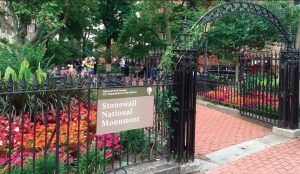
On June 24, 2016, President Obama issued Presidential Proclamation 9465, establishing the Stonewall National Monument in New York City, New York. The national monument was created to preserve and interpret resources associated with the Stonewall uprising, a momentous event in the history of the civil rights movement for the lesbian, gay, bisexual, and transgender (LGBT) community. The uprising was in response to the June 28, 1969 police raid on the Stonewall Inn, a well-known LGBT bar, and the continued riots and demonstrations in the neighborhood in the days that followed.
For general information about Stonewall National Monument, visit the park’s website at www.nps.gov/ston.
It’s Unanimous: Caffe Cino listed on the NY State Register of Historic Places
September 14, 2017
Nearly 60 years after the Caffe Cino opened at 31 Cornelia Street in Greenwich Village, we’re thrilled that our nomination of the famed Off-Off-Broadway cafe theater was listed on the New York State Register of Historic Places today!
Joe Cino, an openly gay man, operated “the Cino” in the storefront space from December 1958 to March 1968. In addition to being the birthplace of Off-Off-Broadway, the Cino was a pioneer in the development of gay theater and in its support of gay playwrights at a time when depicting homosexuality on stage was illegal. It was also significant as a pre-Stonewall site that gave the LGBT community (predominantly gay white men) the opportunity to meet in a social space that served as an alternative to the bar and bathhouse scenes.
Project manager Amanda Davis, who researched and wrote the nomination over the course of the summer, attended today’s meeting of the New York State Board for Historic Preservation at the beautiful Philipse Manor Hall State Historic Site in Yonkers. Kathleen LaFrank, National Register Coordinator for the New York State Historic Preservation Office, presented the nomination to the review board who unanimously voted to add the Caffe Cino to New York State’s honorary register of historic sites. The NYC LGBT Historic Site Project’s nomination now goes to Washington, D.C. where it will be considered for listing on the National Register of Historic Places.
Stay tuned for updates in the next couple of months and, in the meantime, check out other sites in New York City that have been listed for their significance to LGBT history, based on our nominations.
Research work was funded, in part, by a grant from the National Park Service Underrepresented Grants Programs, administered through the New York State Office of Parks, Recreation, and Historic Preservation.
Related Links
Watch our Interview with Impact Hub NYC!
20170406
By: Amanda Davis
Yesterday our co-director Ken Lustbader spoke at a “100 Days of Impact” workshop hosted by Impact Hub NYC in its Tribeca office. The daily workshop series features organizations working on issues that have been impacted by the current administration’s first 100 days in office. Attendees learned how our project could be affected by the administration’s policies and what we’re doing to keep LGBT history visible.
After the workshop, Ken spoke with Monica McCarthy, Events Producer at Impact Hub NYC, in a Facebook Live video about the importance of the project. If you missed it, watch it below!
Multimedia
Courtesy of Impact Hub on Facebook
Engaging a 21st Century Audience
20170323
Our project manager Amanda Davis wrote the following piece for the blog of the National Trust for Historic Preservation. It covers a bit about the years leading up to the founding of our project and why documenting LGBT historic sites is so important. Thanks to our friends at the National Trust for providing us with this platform just after our website launch.
Read the full article over at the National Trust’s Preservation Leadership Forum.
Speaking in Sweden
20170406
By: Amanda Davis
Yesterday our co-director Andrew Dolkart spoke to students and faculty at the Royal Institute of Art in Stockholm, Sweden on the importance of documenting LGBT historic sites and making this history visible to the general public through our interactive website. It’s always a great opportunity to reach out to our friends overseas! See the event listing.
Andrew was co-author of the Stonewall nomination to the National Register of Historic Places in 1999 and, in the past year, has authored the nomination for Julius’ bar and the amended nomination for the Alice Austen House. The latter two nominations are part of our ongoing efforts to recognize LGBT history on the National Register.
NYC’s LGBT Designated Landmarks
February 16, 2017
Separate from the interactive map, our work includes nominating sites to the National Register of Historic Places for their significance to LGBT and American history. Overseen by the National Park Service, the National Register is an honorary federal list that includes over 93,500 sites across the country, yet the LGBT community remains vastly underrepresented with less than twenty sites.
Sites below have also been listed on the New York State Register of Historic Places, which leads the country in nominations that specifically call out LGBT history. We are pleased to be working with the New York State Historic Preservation Office to ensure that the LGBT community’s contributions to American history are recognized on both the state and national registers.
Our work has been funded, in part, by a lead grant from the National Park Service Underrepresented Communities Grant Program to add diversity to the National Register.
National Historic Landmark:
- Stonewall (February 2000)
National Register of Historic Places:
- Stonewall (January 1999)
- Bayard Rustin Residence (March 2016)
- Julius’ (April 2016)
- Alice Austen House (March 2017 amendment)
- Caffe Cino (November 2017)
- Earl Hall (2018)
Check out our list of LGBT sites across the United States that have been listed on the National Register.
We also recommend looking through the groundbreaking, nationwide document, LGBTQ America: A Theme Study of Lesbian, Gay, Bisexual, Transgender, and Queer History, published by the National Park Service in October 2016. The study includes a New York City chapter written by our co-director Jay Shockley.
New York City Landmark:
- Stonewall (June 2015)
Sites that have been granted city landmark status by the NYC Landmarks Preservation Commission (LPC) for their significance to LGBT history.
National Park Service Releases LGBTQ America Theme Study!
October 11, 2016
By: Amanda Davis
The National Park Service released its groundbreaking LGBTQ America: A Theme Study of Lesbian, Gay, Bisexual, Transgender, and Queer History publication today, coinciding with National Coming Out Day and the fifth anniversary of pioneering LGBT rights activist Frank Kameny‘s death.
The 32-chapter study is a result of a multi-year effort by scholars around the country. Our project co-director Jay Shockley wrote chapter 26, “Preservation of LGBTQ Historic and Cultural Sites — A New York City Perspective” based on his research dating back to the early 1990s.
We’re proud to be part of this important initiative that we hope will lead to more LGBT listings on the National Register of Historic Places. Read Jay’s New York City chapter and the full study.
Working with Google Expeditions on National Coming Out Day
20161011
By: Amanda Davis
We were thrilled to work with Google for Education on its Google Expeditions project to highlight some of NYC’s LGBT historic sites in connection with National Coming Out Day. We advised Google staff on potential historic sites to feature and drafted text for some of the sites.
To celebrate the launch, we gathered with Google staff and others at Julius’ bar (one of the featured sites) in Greenwich Village.
Google Expeditions is a virtual reality tool for educators to use in classrooms, but anyone can use it. Get the Expeditions app on Google Play or the App Store and step into some of NYC’s LGBT historic sites from wherever you are in the world.
Related Links
Presenting to the Lower East Side Preservation Initiative
20160913
By: Amanda Davis
Today we presented our project to the Lower East Side Preservation Initiative (LESPI) and guests at the Neighborhood Preservation Center in the East Village. We shared updates on the development of our full website, which we plan to launch in the near future, and shared the histories of just some of the LGBT historic sites that we’ve identified in the East Village and Lower East Side so far.
Many thanks to all who came and suggested LGBT sites!
Related Links
We’re the Neighborhood Preservation Center’s July Spotlight
July 30, 2016
Thanks to the Neighborhood Preservation Center (NPC) for featuring our work in their monthly Spotlight series.
Read the full story via NPC’s website.
President Obama Announces Stonewall National Monument!
20160624
President Obama has just announced the designation of Stonewall National Monument here in New York City to honor the struggle for LGBT equality throughout the nation. It joins existing national monuments for women’s rights in Seneca Falls, New York and for African-American rights in Selma, Alabama in recognizing hard-fought efforts for civil rights in America. “I believe our national parks should reflect the full story of our country, the richness and diversity and uniquely American spirit that has always defined us: that we are stronger together, that out of many, we are one.” While their significance is often underestimated or dismissed by heterosexual society, bars and other establishments have played a pivotal role throughout the 20th century as centers for LGBT activism and community. The designation of Stonewall National Monument recognizes a key moment in American history when LGBT people fought back against oppression that they had faced for decades.
The White House released videos about this historic announcement, which you can view below.
Multimedia
Hosted by YouTube
Placing Pride Flags at Woodlawn Cemetery
20160602
By: Amanda Davis
Today the NYC LGBT Historic Sites Project continued our Pride Month celebrations by placing pride flags at the graves of LGBT notables at the beautiful Woodlawn Cemetery in the Bronx. The flags will be there for the month of June, so please be sure and visit! This follows our flagging event at Green-Wood Cemetery in Brooklyn yesterday. “Flagging graves of LGBT individuals is a way of both celebrating important individuals and providing recognition of the contributions made by LGBT people to the larger community. Working with Woodlawn Cemetery staff, we placed pride flags at the graves of suffragists Carrie Chapman Catt and Mary Garrett Hay, poet Countee Cullen, playwrights Clyde Fitch and Roi Cooper Mergue, sculptor Malvina Hoffman, illustrator J.C. Leyendecker, photographer George Platt Lynes, literary agent Elisabeth Marbury, vaudeville star Bert Savoy, and lawyer John W. Sterling. We also placed flags next to sculptor Patricia Cronin’s Memorial to a Marriage, which she made before same-sex marriage was legal and shows her and her wife Deborah Kass in a loving embrace (both are still living).
We’d like to thank Susan Olsen, Woodlawn’s Director of Historical Services, in particular for her assistance with this initiative as well as Woodlawn volunteers who helped find additional LGBT permanent residents who we honored today. Olsen had this to say,
“Although there are many historic figures associated with the LGBT community memorialized at Woodlawn, prejudices and societal views often kept these individuals from openly declaring their relationships and separation from their life partners when they were laid to rest. In recent times attitudes have changed inspiring lot ownership and memorization that commemorates the rights of all.”
Check out our Woodlawn Cemetery site page to learn more about each of the individuals honored today. We’ll also be adding more names to that page as we discover them. If you have suggestions, please let us know!
Related Links
Kicking Off Pride Month at Green-Wood Cemetery
20160601
By: Amanda Davis
We were thrilled to kick off our first LGBT Pride Month at Green-Wood Cemetery in Brooklyn earlier today. Green-Wood is one of the oldest rural Victorian cemeteries in the country, and has long been the final resting place of famous Brooklynites and others from around New York City.
In partnership with Historic Green-Wood, we spent a beautiful afternoon placing pride flags at the gravesites of LGBT notables. The flags will be in place for the entire month of June so we hope you’ll stop by and say hello! You can find the location of each gravesite by using Green-Wood’s online search feature.
Those remembered today include sculptor Emma Stebbins, composers Leonard Bernstein and Louis Moreau Gottschalk, actor/singer/songwriter Paul Jabara, lyricist Fred Ebb, psychiatrist and gay rights activist Richard Isay, and muralist Violet Oakley.
Richard Moyland, President of Green-Wood, weighed in on the day:
“Green-Wood is proud to partner with the NYC LGBT Historic Sites Project in its work to recognize our permanent residents and their contributions to so many important aspects of American life and culture. Throughout the year, Green-Wood strives to honor these individuals by keeping their stories alive and focusing attention on their extraordinary lives with our annual LGBTQ-themed trolley tour coinciding with Brooklyn Pride Week. He continued. This year, the presence of rainbow flags will be a visible and constant reminder to all that our world is richer because of them. We’d like to thank the staff at Green-Wood for taking part in this special event with us. Please be sure to check out their annual “Gay Green-Wood Trolley Tour” later this month.
As we discover more LGBT people buried here we will add it to our Green-Wood Cemetery site page. There you’ll also find photos of all gravesites that we flagged in addition to any we may have discovered after today’s event. If someone is missing from that page that you feel should be included please let us know so we can add their names and honor them at our next pride flagging event. We’d also be happy to flag the gravesites of your LGBT loved ones, whether they were famous or not.
See you next June!
Event Partners

Related Links
Visiting SAGE Center Harlem
20160513
This afternoon we met with members of SAGE Center Harlem who shared their memories of historic sites in the community. SAGE (Services and Advocacy for GLBT Elders) is the nation’s largest and oldest organization of its kind.
We came away with lots of suggestions and are looking forward to continuing the conversation with the group!
Related Links
50th Anniversary Celebration of the Sip-In at Julius’
April 25, 2016
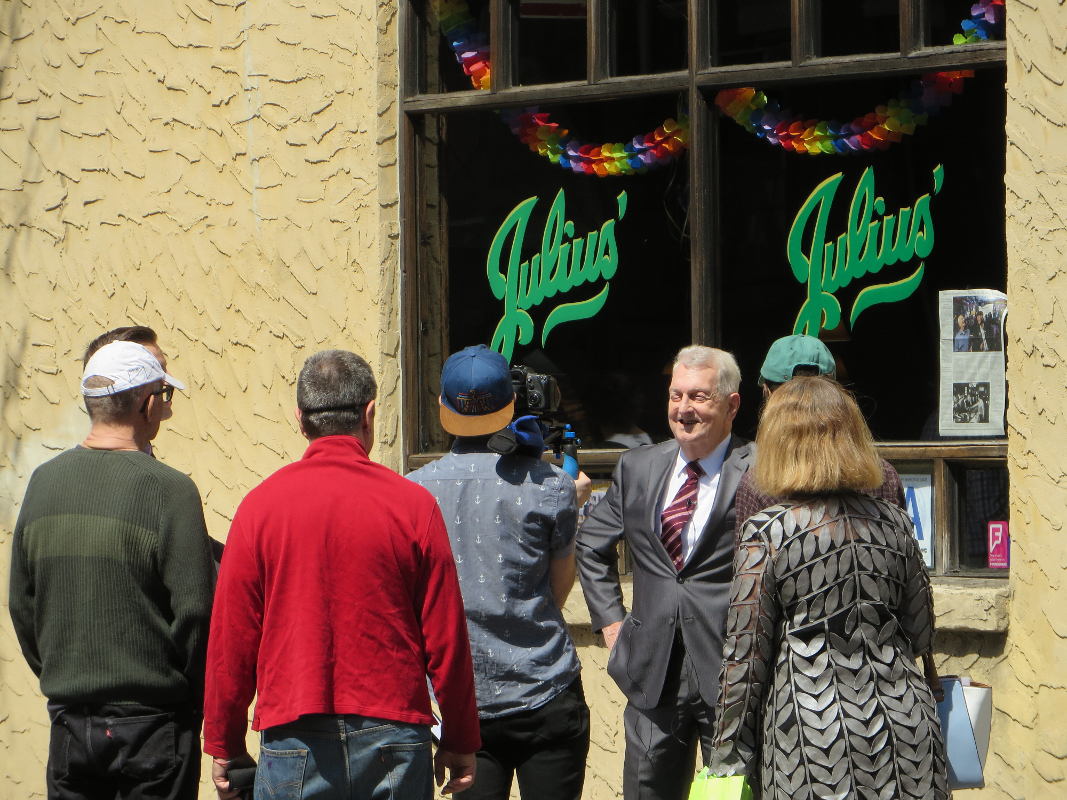
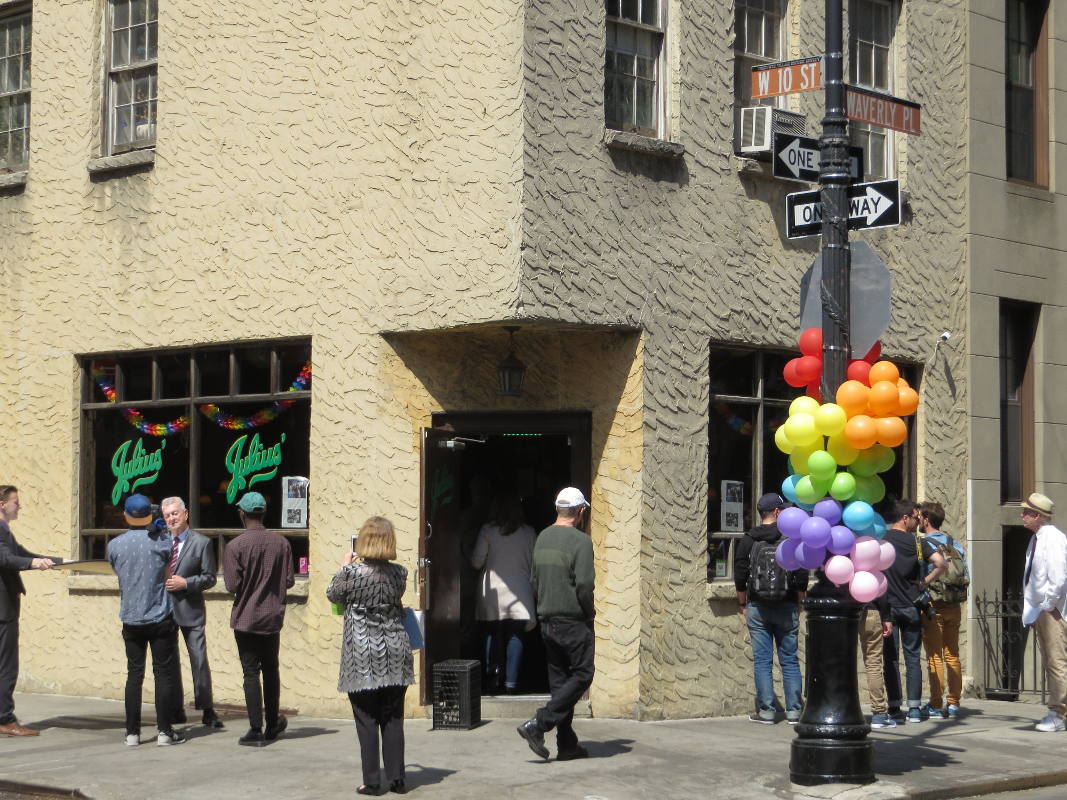
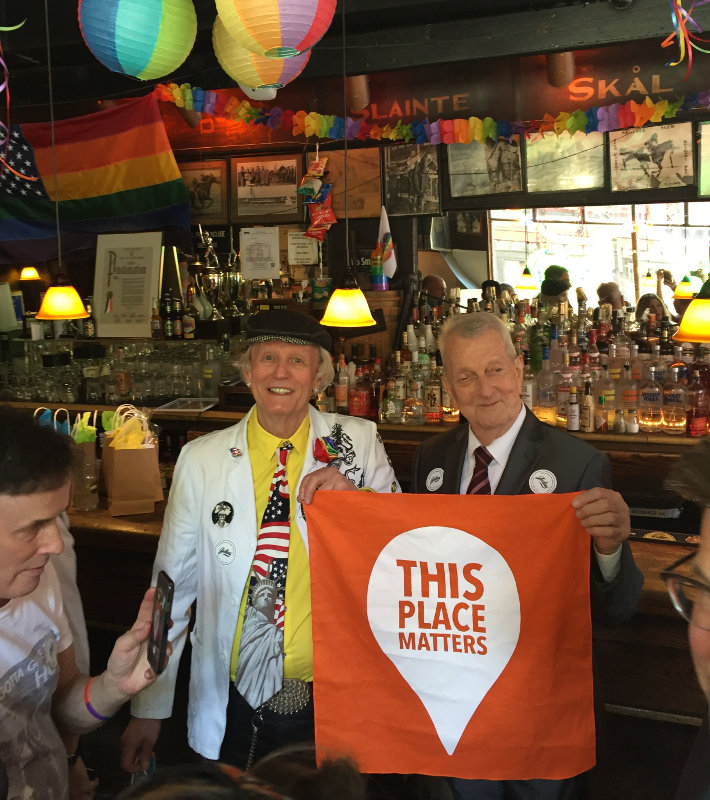
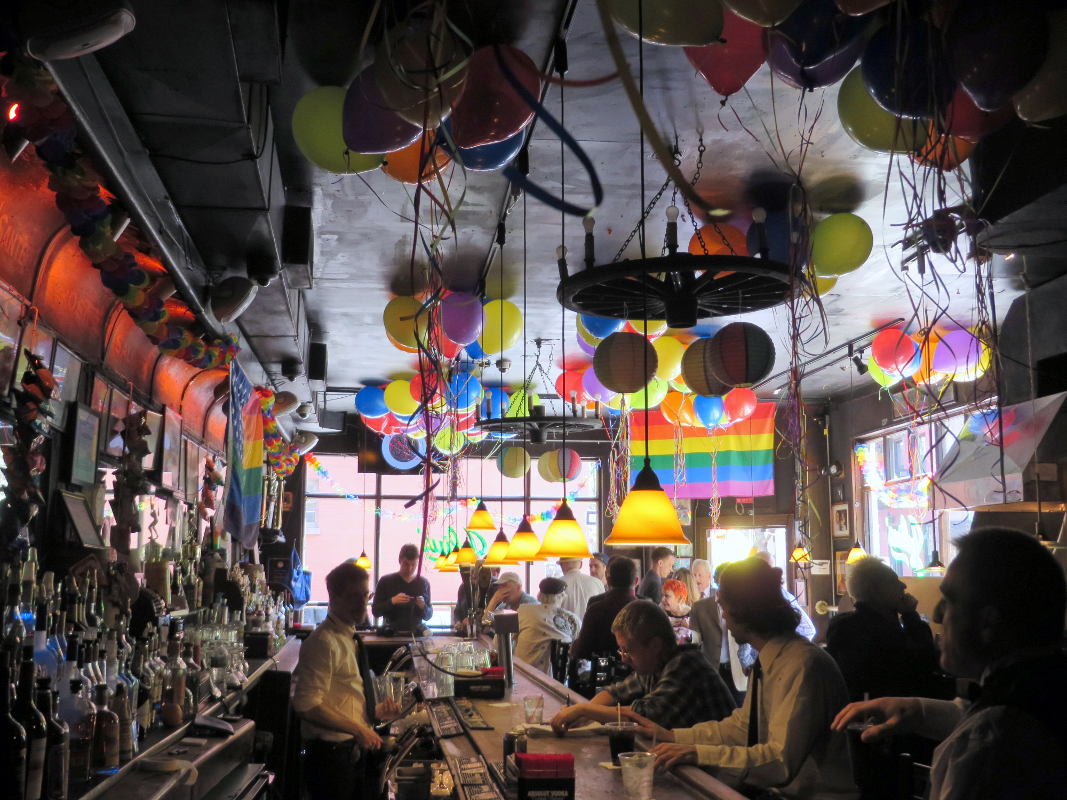
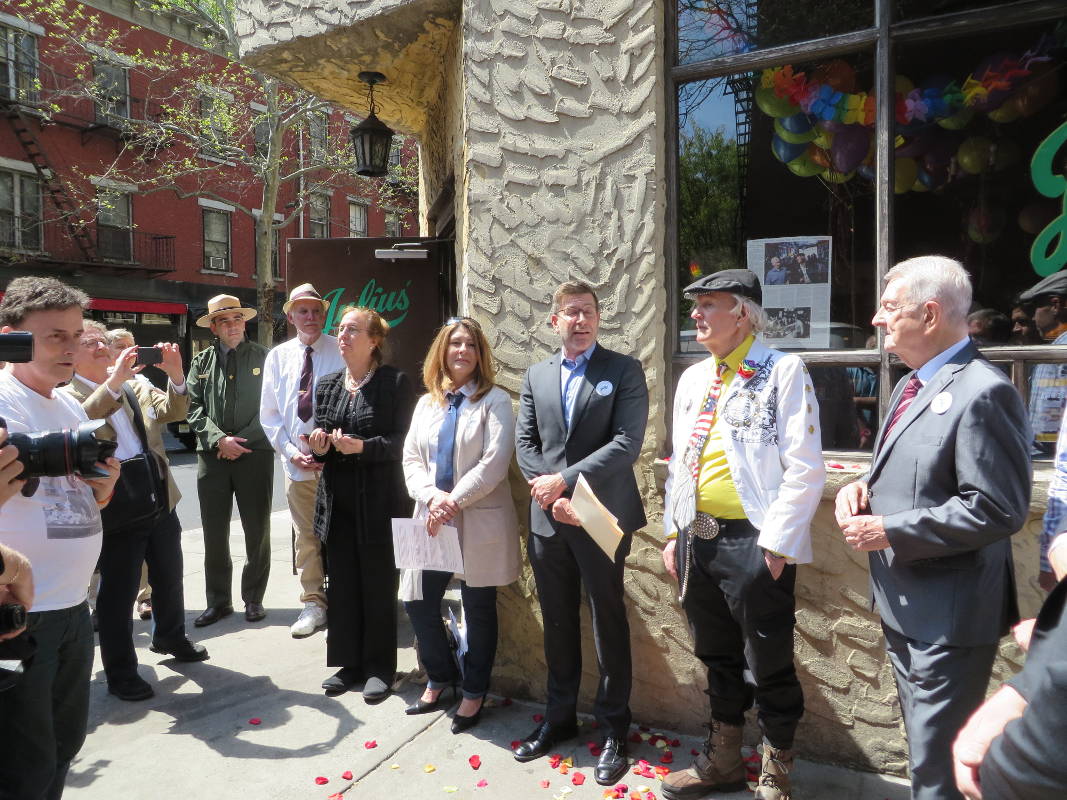
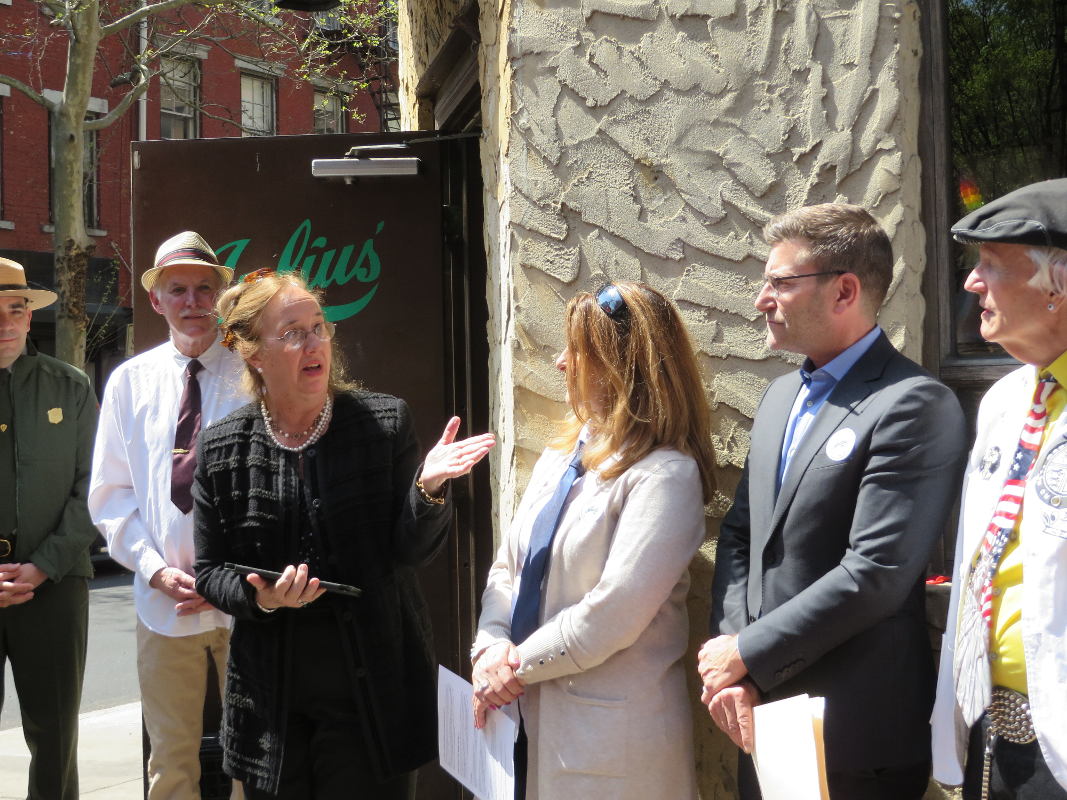
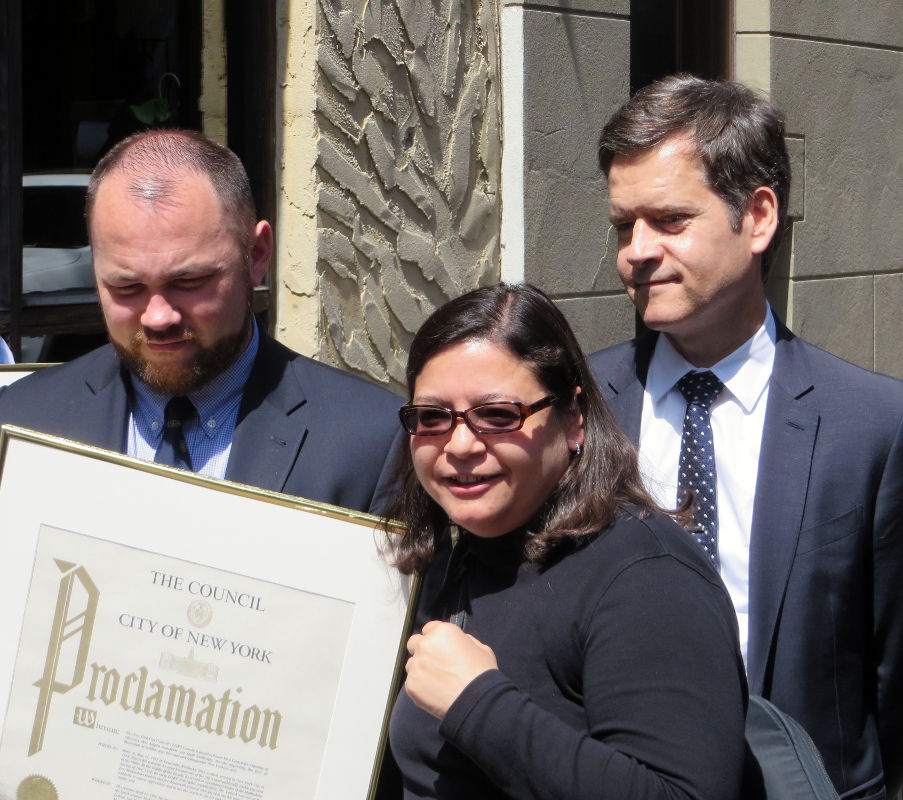
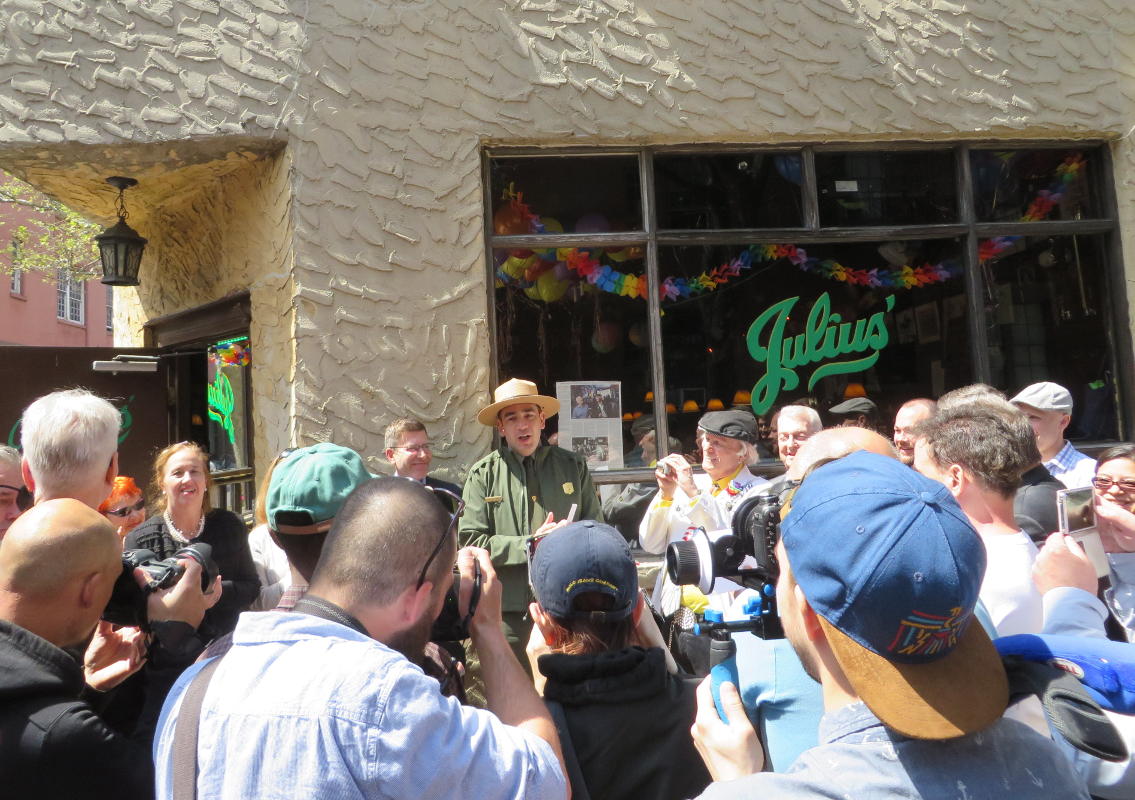
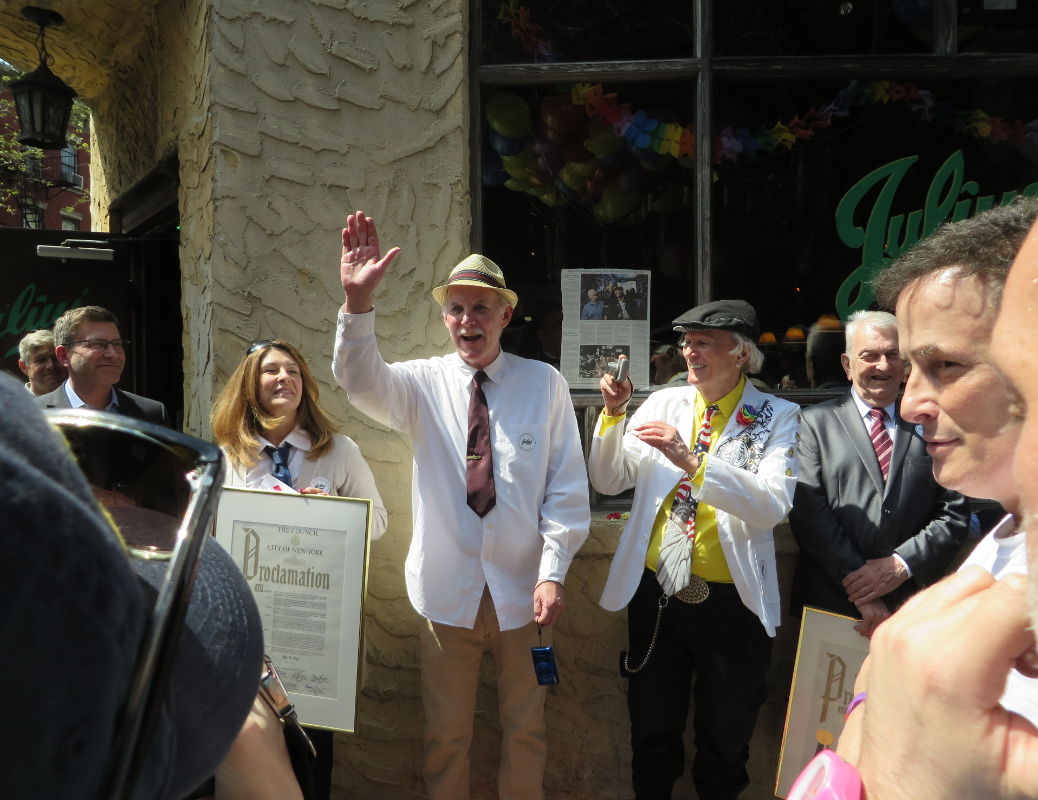
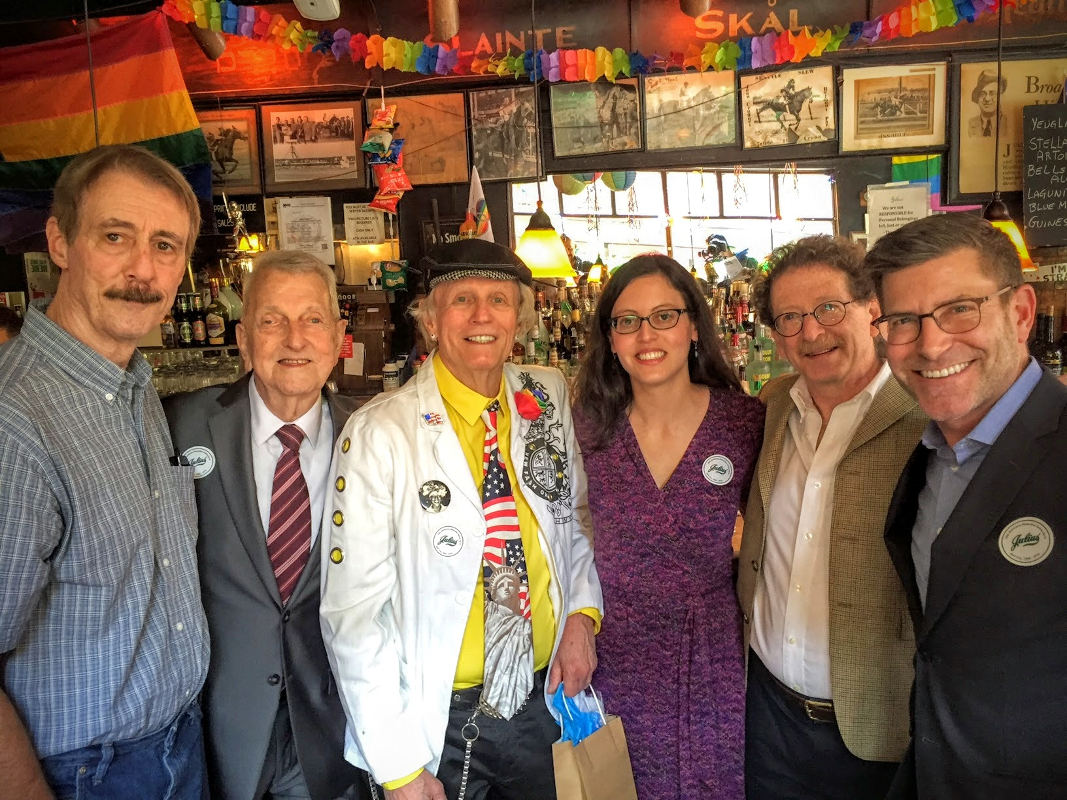
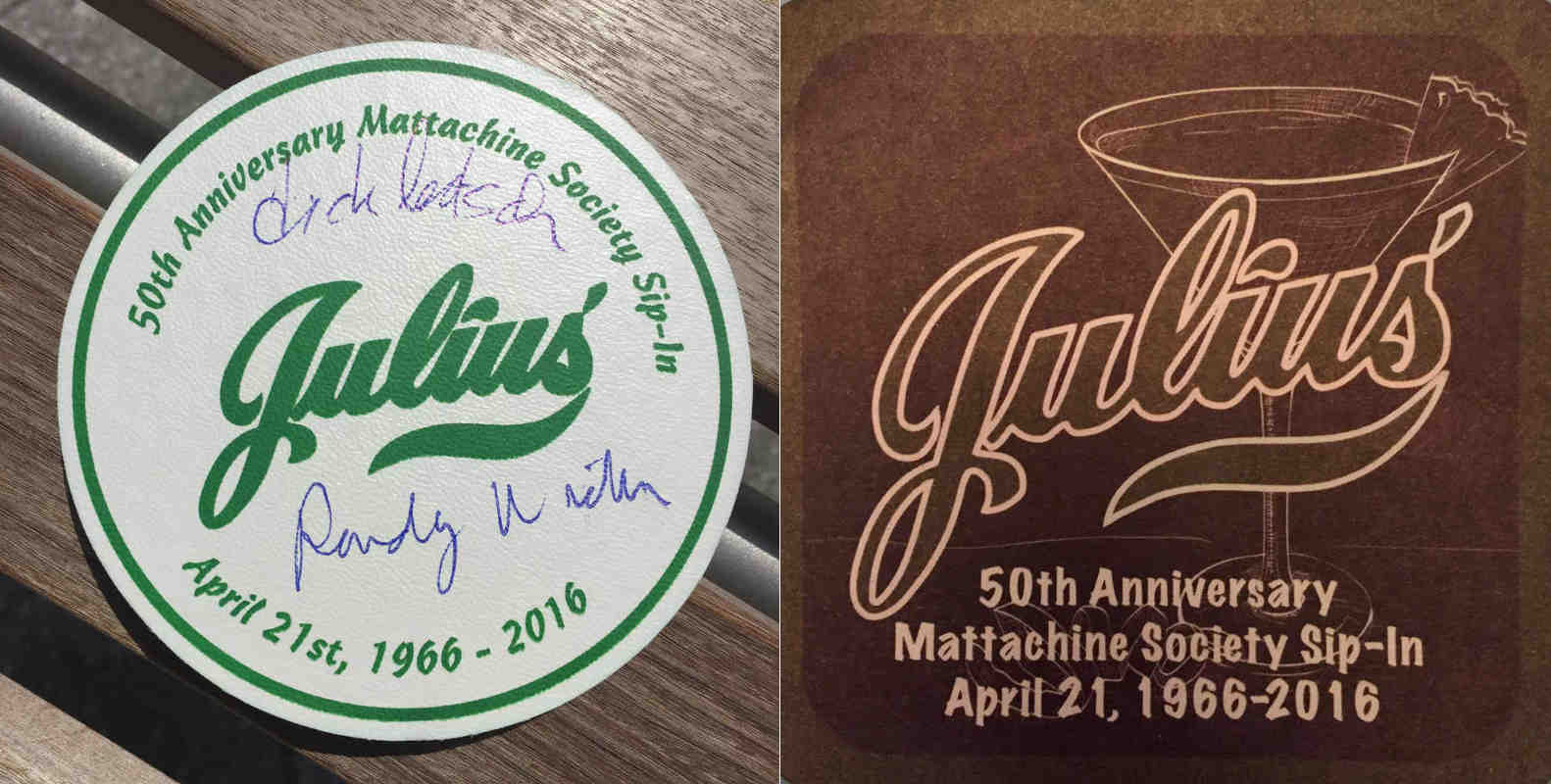
Last week, on April 21st, we gathered at Julius’ bar in Greenwich Village to celebrate the 50th anniversary of the Sip-In, which took place here in 1966.
Joshua Laird, Commissioner of the National Parks of New York Harbor, stood outside Julius’ bar in Greenwich Village to announce its listing on the National Register of Historic Places based on our nomination. Surviving Sip-In participants Randy Wicker and Dick Leitsch were also present and honored.
[Dick Leitsch and Randy Wicker] truly have paved the way for LGBT rights and I think young people should know what these older gentlemen did to make it a little bit easier for future generations.
Elected officials who attended the event include New York State Senator Brad Hoylman, Manhattan Borough President Gale Brewer, and New York City Council Members Rosie Mendez (also chair of the council’s LGBT Caucus), Corey Johnson, and Daniel Dromm. The City Council presented a framed proclamation announcing that April 21, 2016 would be remembered as “Sip-In Day” in New York City.
Many thanks to Casa Vera Productions for capturing a great day in LGBT and NYC history. View the video below!
Multimedia
Hosted by Vimeo
Event Partners
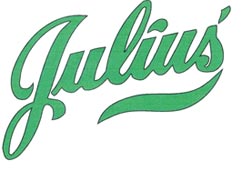
Related Links
Julius’ National Register Nomination
Our Nomination of Julius’ to the National Register of Historic Places Approved Today!
April 20, 2016
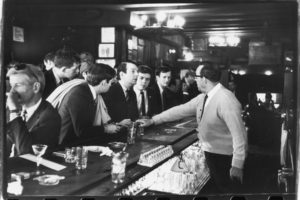
After months of research and outreach our report is now available on the National Park Service website. The bar, which was listed just a day before the Sip-In’s 50th anniversary, is now the eighth site in the country listed on the National Register for its significance to LGBT history.
In New York City, Julius’ is the third LGBT-specific site to be added to the National Register. The other two are the recently-listed Bayard Rustin Residence in Chelsea and the Stonewall Inn in Greenwich Village, which was listed in 1999. Stonewall is still the only LGBT-specific site in the city to be named a National Historic Landmark.
The nomination of Julius’ also fulfills part of our mission to add more LGBT-specific sites to the National Register. Stay tuned for our next nomination!
Related Links
Julius’ Listed on the New York State Register of Historic Places!
March 24, 2016
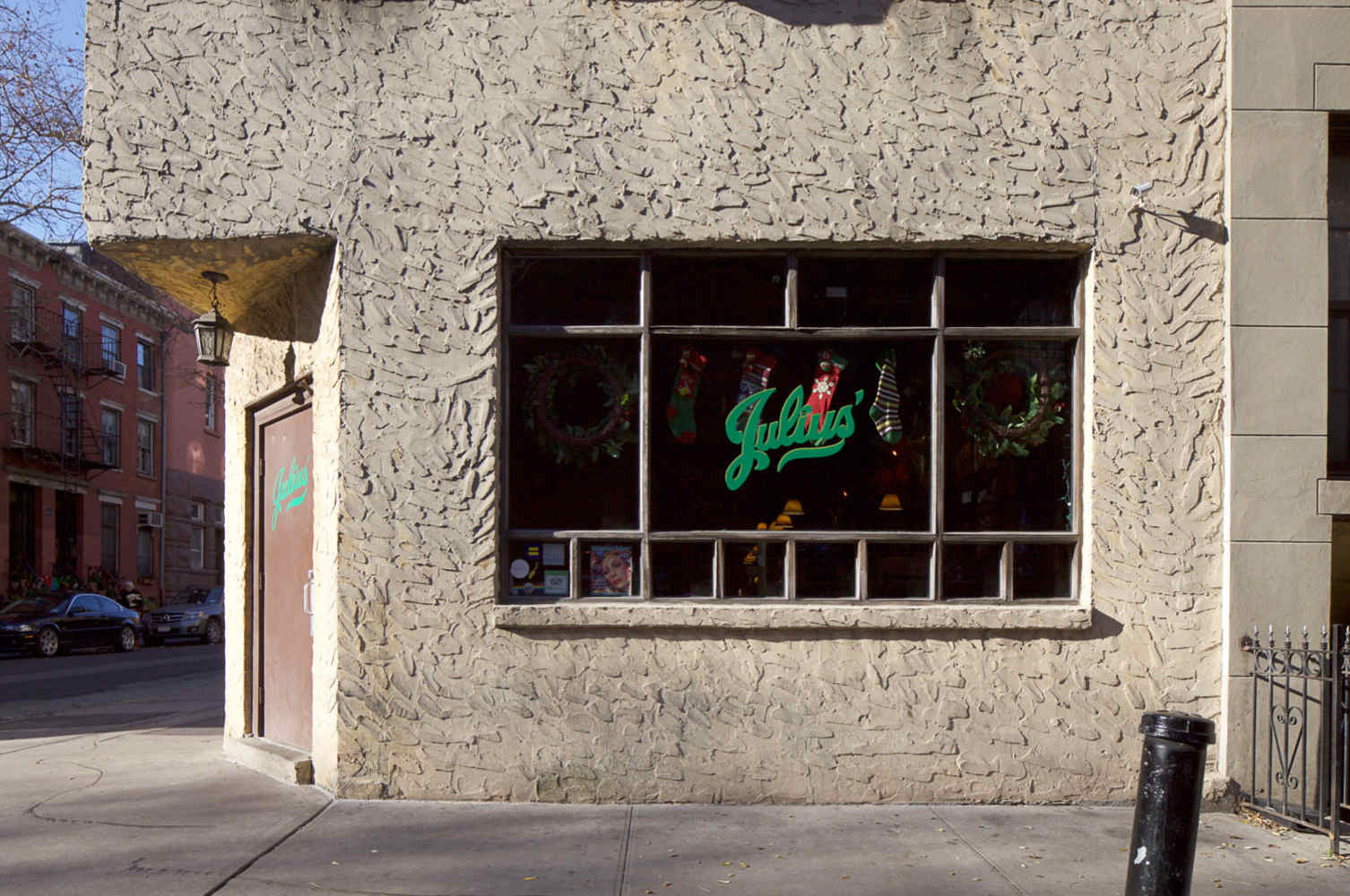 Julius’ bar, 2016. Photo by Christopher D. Brazee/NYC LGBT Historic Sites Project.
Julius’ bar, 2016. Photo by Christopher D. Brazee/NYC LGBT Historic Sites Project.
The NYC LGBT Historic Sites Project’s nomination of Julius’ bar to the National Register of Historic Places moved one step closer today when it was officially listed on the New York State Register of Historic Places.
A press release from Governor Andrew Cuomo yesterday included Julius’ as one of 19 sites across the state recognized for their significance to New York state history.
The 1966 ‘Sip-In’ at Julius’, which approaches its 50th anniversary in April, is considered an important event in the pre-Stonewall gay rights movement and a big step forward in the development of legitimate (rather than mob-owned) LGBT bars in New York City.
Related Links
Bayard Rustin Residence Listed on the National Register of Historic Places!
20160308
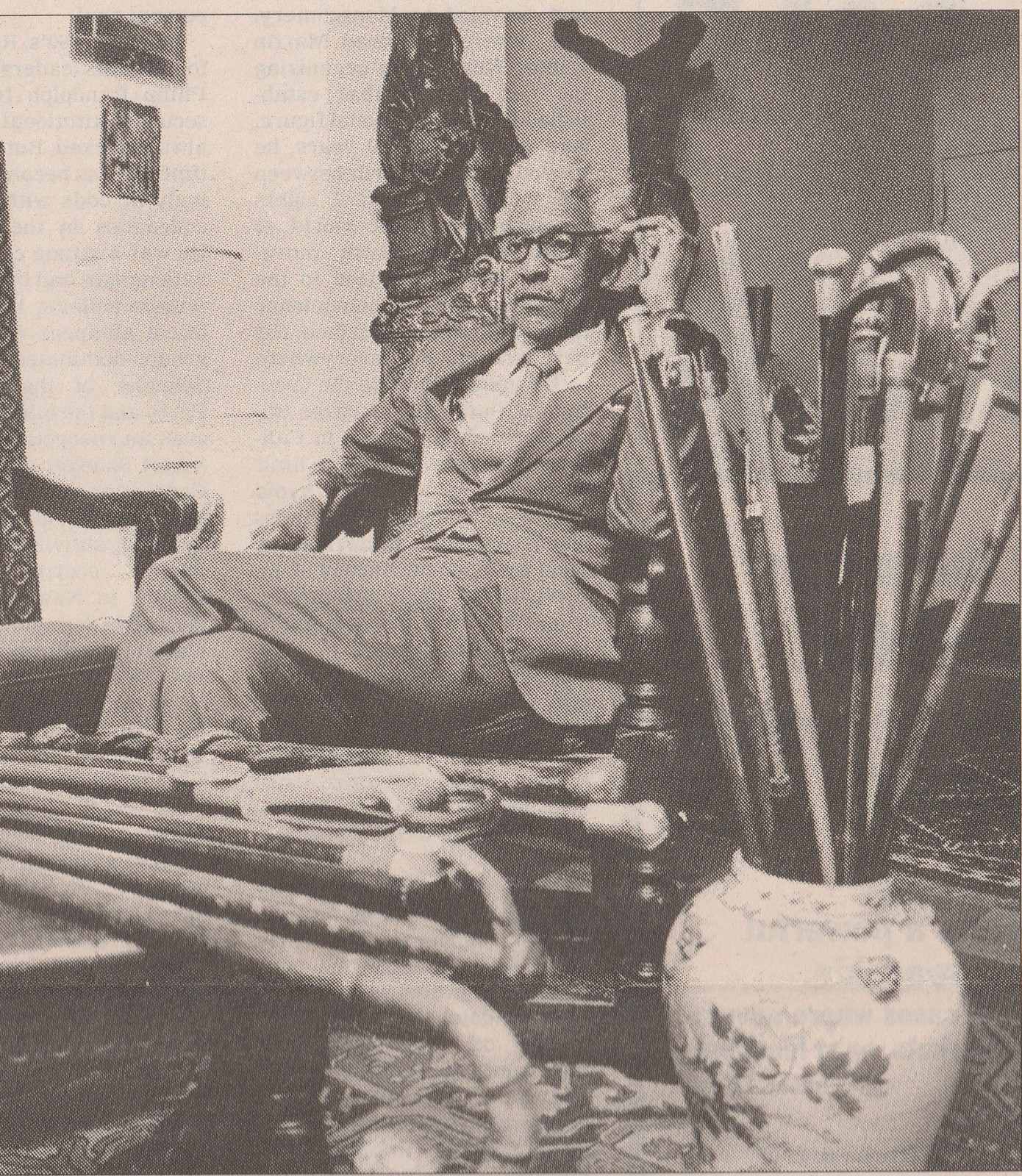
Bayard Rustin (1912-1987), a highly influential African-American civil rights leader and later gay rights activist, organized the 1963 March on Washington for Jobs and Freedom — among other accomplishments — while living in his long-time Penn South residence in Chelsea. He often could not take credit for his work because he lived as an openly gay man.
In honor of his significant contributions to American history, Rustin’s residence in Penn South was added to the National Register of Historic Places today! The addition of Rustin’s residence to the National Register brings the total of LGBT-specific sites on the list to five. Last December, the Bayard Rustin Residence was also listed on the New York State Register of Historic Places.
Read the official nomination, written by Mark Meinke of the Rainbow Heritage Network, and also be sure to take a look at our Bayard Rustin Residence site page.
Related Links
Touring LGBT Historic Sites with George Takei
20160218
Project co-director Ken Lustbader was honored to give the legendary George Takei and his husband Brad a tour of LGBT historic sites in Greenwich Village today. Takei has been a spokesman and activist for a number of human rights campaigns, including LGBT equality.
Visiting the Lesbian and Gay Democratic Club of Queens
20160201
This evening we were invited by Council Member Daniel Dromm to give a presentation about the project to the Lesbian and Gay Democratic Club of Queens at its meeting in Jackson Heights. We look forward to working with the group in the future to document significant historic sites throughout Queens.
NYC LGBT Historic Sites Project Officially Begins!
20150803
Project directors Andrew Dolkart, Ken Lustbader, and Jay Shockley first got involved with researching and advocating for the preservation of LGBT historic sites 25 years ago. In 2014, they applied for and were awarded support from the National Park Service’s Underrepresented Communities Grants Program, which strives to add more diversity to the National Register of Historic Places. After additional fundraising, the NYC LGBT Historic Sites Project was able to officially launch today when we brought on Amanda Davis as project manager.
Our goals include developing an interactive online map of LGBT historic sites and nominating some of those places to the National Register. We also plan to present our work to various community groups, schools, and general audiences throughout the city in order to foster a better understanding of New York City’s LGBT history and the community’s influence on America.





